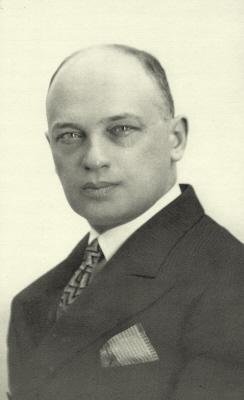
Edward Winter

Savielly Tartakower
Below are the main C.N. items which are related to Tartakower’s career.
***
Under the heading ‘A real scrap’ C.N. 513 gave Tartakower’s victory over Bogoljubow, London, 17 October 1927. Our concluding comment was, ‘Rarely can a loser have played so ingeniously’.
An article by Olga Capablanca on Nottingham, 1936 in the February 1945 issue of Town & Country included this remark about Tartakower:
‘I believe Capa was fonder of him than of any of the others because he admired sincerity next to intelligence, the qualities he looked for in others and were his own main characteristics.’
(823)
Savielly Tartakower and Sir George Thomas were featured on page 20 of CHESS, 14 September 1936:
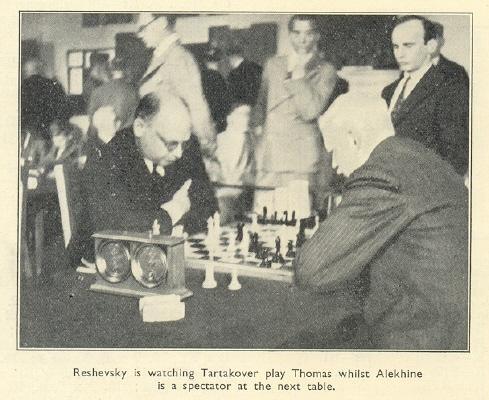
See Photographs of Nottingham, 1936.
Olimpiu G. Urcan has sent us, courtesy of the Hulton Archive, a photograph of Sir George Thomas in play against Tartakower, Hastings, 28 December 1935 (after 25 g5):
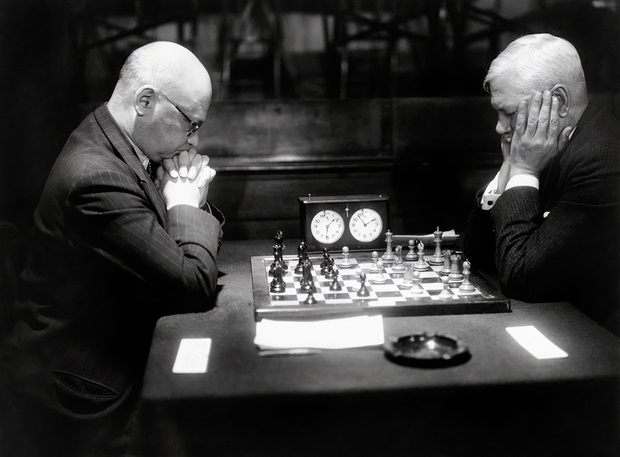
A familiar example of the staircase manoeuvre is the game Mojżesz Leopoldowicz Łowcki v Savielly Tartakower, Jurata, 1937; see, for instance, pages 322-323 of the first edition of the Oxford Companion to Chess.
How interesting to find the selfsame mess (down to virtually identical notes) on page 127 of Chernev and Reinfeld’s The Fireside Book of Chess (New York, 1949).
(1357)
‘I well remember the advice Dr Lasker gave me after the tournament of Mährisch-Ostrau in 1923: “You will never attain a balanced positional judgement until you start to adopt the Ruy López habitually.”’
S. Tartakower, CHESS, December 1948, page 64.
(1409)
Wanted: examples of Tartakower’s wit and wisdom. The familiar examples will also be listed if readers can quote their exact source. A small sample from his two volumes of Best Games:
Volume I, page 17: ‘My principle – that has remained unchanged ever since that period! – was the following: “As long as an opening is reputed to be weak it can be tried”.’
Volume I, page 65: ‘All the spectators – experts as well as amateurs – were already envisaging a fresh triumph for the Cuban, but the natural resistance which is inherent in every position (as in every physical body!) saves Black's game.’
Volume I, page 157: ‘“You really have confidence in your pieces”, Dr Tarrasch said to me, somewhat bitterly, after the game. (Semmering, 1926). “Rather my pieces have confidence in me”, I replied.’
Volume II, page 9: ‘The ever blissful vision of the seventh rank!’
Volume II, page 61: ‘The art of chess is simple: you play Kt-B3-K5 and then, sooner or later, KtxKBP is decisive.’
Volume II, page 83: 1 d4 Nf6 2 c4 e6 3 Nc3 Bb4 4 Bd2. ‘A line rarely used by other masters, but one in which passiveness and aggression are cunningly mingled.’
(1585)
An interesting assessment by Tartakower of the then world champion was published on pages 286-288 of the December 1924 issue of La Stratégie in an article entitled ‘Capablanca as a Theorist’. After stating that Lasker ‘instead of innovating seeks merely to simplify any opening which seems dubious to him’, Tartakower affirmed:
‘We find that this energetic determination to obtain as rapidly as possible a simple and solid position is even more pronounced in Capablanca, who, far from inventing clever systems like Rubinstein or Alekhine, is happy to play fashionable openings, whilst adding from the start of the battle unexpected lightning moves, that is to say petites combinaisons: 20...Nb5!! against Tarrasch at San Sebastián, 1911, or 18...Nxf4!! against Janowsky at New York, 1924. “Playing une petite combinaison” is Capablanca’s favourite expression.’
Tartakower proceeded to note Capablanca’s strong preference for the Ruy López and Queen’s Gambit, his restrained play against the Indian Defence and ‘his unceasing search as Black for sure and tenable defences’. Avoiding the Sicilian and the Caro-Kann, he liked to play the Steinitz Defence to the Ruy López and the Indian Defence. (It was only later that the Cuban made extensive use of the Caro-Kann.) Tartakower continued:
‘The fact is that Capablanca is not afraid to be afraid of the disturbances in the centre which the scientific school considers to be the first step towards victory; and thus he adopts, in Réti’s expression, “a new technique”, the guiding principles of which may be summarized under three points:
1) Always play pieces not to the most effective squares, but to the most natural ones (interior development!);
2) Consider the game of chess to be a drama developing from one move to the next (cinematographic principle);
3) Instead of gaining time and space, as advocated by the old school, accumulate invisible energy by means of subtle manoeuvres where logic is mixed with fantasy (dynamic principle).’
After examining Capablanca’s win over Lasker at the recent New York tournament, Tartakower concluded:
‘Capablanca is the master of masters, who has been able to unite the practical idea of Americanism with the inventive genius of the Latin race. It is true that, influenced by the climate, the German philosopher Lasker had to recognize the superiority of the Cuban in Havana in 1921. The question now is whether the universal spirit and impetuous élan of Alekhine could triumph. Unfortunately, boxing questions – Dempsey or Wills? Siki or Firpo? – seem to be what the civilized world considers the most important.’
Tartakower continued on this theme in an article entitled ‘Can Capablanca Be Beaten?’ on page 24 of the January 1925 Wiener Schachzeitung:
‘Since every player becomes older, weaker and worn down, it would be correct to rephrase the above question as follows: beaten while he is in his current top form?
The world champion provides the answer himself to some extent in a recently published interview in which a certain resignation is apparent. While this may also be interpreted as a favourite strategy of false modesty, the fact remains that Capablanca will not have the last word in chess knowledge, ability and effort by any means. We consider his main failing to be that he refuses to acknowledge any kind of fantasy or imagination in chess. Although we do not expect any kind of monumental theoretical changes from him, we cannot help but remark that he tends to stick all too much to tried and true solutions when handling openings, with a marked preference for a few great predecessors ... If Capablanca does not have any famous example to follow, then his performance is characterized by a certain superficiality (e.g. against the Sicilian or Dutch Defences), although this does show his wonderful tactical talent all the more clearly.
Should therefore a bold new player come along who demonstrates, aside from brilliant imagination, also enough technical training to defeat Capablanca (Alekhine? Réti?), in any event the Cuban’s chess mission can be considered magnificent. After Steinitz the fighter and Lasker the philosopher, there came Capablanca, the worldly champion whose fascinating personality and elegant method of play have contributed enormously to popularizing the art of chess.’
It is interesting to compare Tartakower’s assessment with that of Hans Kmoch in the July 1925 Wiener Schachzeitung (pages 189-194). The following excerpt gives the flavour:
‘The prime difference between his style and that of other champions lies in the fact that any so-called “risk” is foreign to him. No, Capablanca does not take risks. If he did, he would already be leaving the straight paths, the area of exact calculation, and he believes (and justifiably so) that he does not need to do so. He, who as a strategist possesses what is conceivably the finest positional feeling, whose tactical regard illuminates every position like an X-ray and grasps every combination with the speed of lightning, who as a technician is indeed similar to a machine which notes and evaluates any advantage gained with incredible precision, he does not need to trust to luck and find himself in situations in which the chances of even a considerably weaker opponent increase to the extent that the possibility of unforeseen occurrences must be reckoned with.
Of course, this considerable advantage of Capablanca’s is at the same time his drawback in a certain sense – for instance in tournaments, where it is a matter not of defeating each opponent overall, but rather of winning every possible game. It is nowadays quite likely, given the generally very high level of play, that even a relatively weak player could manage to draw in a correctly conducted game.’
(1855)
Who was the first player to give a simultaneous exhibition at sea? According to page 296 of the 14 April 1936 issue of CHESS:
‘Did you know ... that the first simultaneous display on board ship was given by Dr Tartakower on the Massilia in the Mediterranean, 1931? Also he is the only person to have given a simultaneous exhibition in an aeroplane – between Budapest and Barcelona in 1929.’
(1947)
For further information on this topic, see Chess Jottings.
C.N. 1218 pointed out that page 238 of Tartakower’s My Best Games of Chess 1905-1930 (London, 1953) called a game beginning 1 d4 Nf6 2 Nf3 e6 3 c4 Bb4+ ‘Neo-Indian Defence, Buckle-Bogoljubow Variation’. Tartakower’s claim that 3...Bb4+ ‘is already to be found in some of the games of Buckle’ remains to be proven; the closest example we have found so far is 1 d4 e6 2 c4 Bb4+ 3 Nc3 Bxc3+ (Löwenthal v Buckle, fourth match-game, London, 1851).
(2029)
From page 4 of Das neuromantische Schach by S. Tartakower (Berlin, 1927):
‘Da wäre schon der Ausspruch des seligen Teichmann viel zutreffender, der auf einige Ausführungen Réti’s im Jahre 1923 mit dem ihm eigenen kernigen Humor erwiderte: “Erstens existiert die hypermoderne Schule gar nicht und zweitens stammt sie von Nimzowitsch!”’
English translation: ‘... the remark of the late Teichmann, who replied to some of Réti’s statements in 1923 with his own brand of pointed humour: “First, the hypermodern school does not actually exist, and secondly it originates with Nimzowitsch”.’
(3251)
When was the term ‘hypermodern chess’ first used? The earliest citation we can offer at present is in the booklet Am Baum der Schacherkenntnis by S. Tartakower (Berlin, 1921). Pages 15-16 have an article entitled ‘Das hypermoderne Schach’.
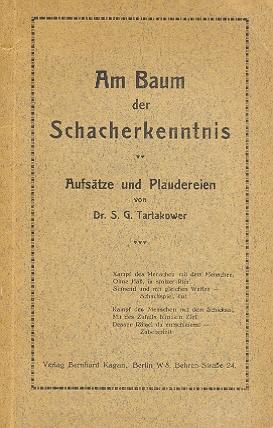
(4140)
Peter Morris (Kallista, Australia) notes on page 256 of 500 Master Games of Chess by S. Tartakower and J. du Mont (London, 1952) the following annotation in the game Paulsen v Rosenthal, Vienna, 1873, after 1 e4 e5 2 Nc3 Nc6 3 g3 Bc5 4 Bg2:
‘In an open game, and at a time when chess went through its “heroic period”, White applies a principle which was later on to be brought to the fore by the masters of “hyper-modern” chess, Breyer, Réti, Nimzowitsch, Bogoljubow, and up to a point by Alekhine and others, namely, control of the centre instead of its occupation.’
The passage is particularly interesting for its reference to Bogoljubow; we have expressed doubts as to whether he should be regarded as a hypermodern player.
(8003)
‘It seems only a few years ago that the Hypermodern School, headed by Alekhine, Réti, Nimzowitsch, Bogoljubow and Breyer, infused a new vitality and profundity into the then extant chess theories.’
Source: Chess Strategy and Tactics by F. Reinfeld and I. Chernev (New York, 1933), page 96.
The omission of Tartakower may be considered a simple oubli.
C.N.s 2323, 4773 and 8687 discussed the nickname ‘The father of modern chess’. Concerning ‘The father of hypermodern chess’, citations for Nimzowitsch (and, even, Tartakower) are easily found, but there is also an article about Louis Paulsen by Imre König on pages 234-236 of CHESS, 19 February 1955:
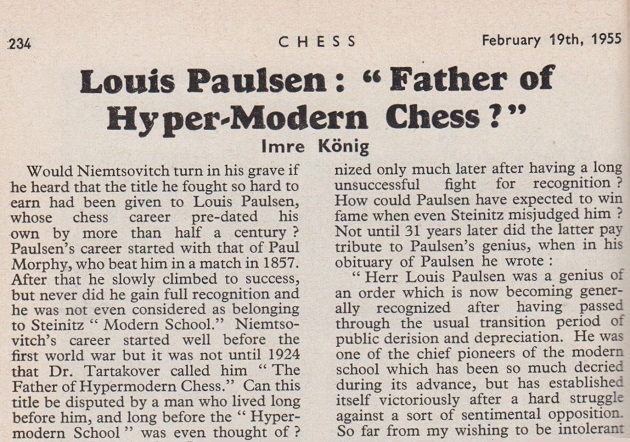
(10463)
See too Hypermodern Chess.
John Donaldson (Seattle, WA, USA) sends an English translation by R. Tekel and M. Shibut of an interesting article by Réti ‘Do “New Ideas” Stand Up in Practice?’, published on pages 8-10 of the Virginia Chess Newsletter of September/October 1993.
A sidelight is Réti’s nomination for White’s best first move: 1 c4. His reasoning begins: ‘One would expect Black’s strongest point in the centre to be d5 since, unlike e5, it has natural protection by the queen. Therefore, the ideal initial move is 1 c4, immediately taking aim at d5.’
Tartakower (see page 15 of his first volume of Best Games) called 1 c4 ‘the strongest initial move in the world’.
(2030)
We first mentioned that remark of Tartakower’s in C.N. 1219.
Numerous books assert that Carl Carls always played 1 c4, except on the occasion when his c-pawn was glued to the board. In fact, games in which Carls opened as White with another first move may even be found in the monograph Carl Carls und die “Bremer Partie” by Kurt Richter (Berlin, 1957).
Annotating the move 1 c4, as played in a match-game between Carls and Antze at Bremen in 1933, Tartakower declared (on page 637 of the August-September 1934 issue of L’Echiquier):
‘An opening which the master from Bremen has been playing, almost without exception, for about 30 years.
Just recently, however, I learned that in annotating the game Eliskases v L. Steiner, which Black won prettily ..., the German master and journalist Leonhardt expressed his joy that this tortuous opening, which comes from the Eastern Jews (“Ost-Juden”) Nimzowitsch and Tartakower, will lose some of its worth.
With such remarks, Leonhardt is certainly doing his homeland a disservice. His hope of flattering official circles may well backfire and he may well be “corrected” for publishing assertions which are:
1. untrue, since the opening was introduced by the Englishman Staunton;
2. maladroit, since the system was developed by the German Carls;
3. ridiculous, since in the game in question, Eliskases v L. Steiner, the move 1 c4 was played by a good Tyrolean, whereas it was refuted by a Semitic player;
4. preposterous, since in chess we take pleasure in seeking truth, without players’ personalities playing any role;
5. unhealthy, since in chess we prefer to be rid of political, ethnological, etc. discussions; and finally;
6. harmful, since the German authorities recommend their citizens not to make attacks on foreigners.’
Leonhardt died a few months later, a great loss to German chess.
(Kingpin, 1996)
A footnote on page 156 of Kings, Commoners and Knaves mentioned that we had been unable to find Leonhardt’s original annotations.
‘It is difficult to think of another chessplayer who has such a broad opening repertoire as Tartakower.’
Paul Keres on page 71 of Paul Keres: The Quest for Perfection by Paul Keres and John Nunn (London, 1997).
(Chess Café, 1998)
Annotating his victory (as White) over Schlechter at Vienna, 1907 in his first Best Games volume (pages 15-17), Tartakower gave 1 c4 an exclamation mark and wrote:
‘A curious point: 18 years later (in 1925) I published a detailed analysis of this opening, in which I arrived at the conclusion that 1 P-QB4 was “the strongest initial move in the world” – and I was already applying it intuitively with great predilection in the first stages of my chess career.’
In his notes to Alekhine v Sämisch, Baden-Baden, 1925 on pages 106-108 of La Stratégie, May 1925, Tartakower wrote:
‘1 P4FD. “Le début le plus fort du monde!”, comme je l’ai déjà et maintes fois proclamé. Les Blancs se préparent à bouleverser le centre ennemi sans se créer quelque point faible.’
(7718)
See too The English Opening.
The conclusion of a quick game between Alekhine and Tartakower, played at Carlsbad on 8 May 1923 appeared in C.N. 1050, taken from the Wiener Schachzeitung, July 1923, pages 135-136.
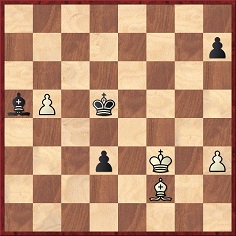
1 Ba7 Kc4! 2 b6 Kc3! 3 b7 d2 4 b8(Q) d1(Q)+ 5 Kg2 Qd5+ 6 Kg3 Kd3!! 7 Qb1+ Ke2 8 Qc2+ Bd2 9 Bc5 Kf1!! 10 h4 Qg2 mate. (Punctuation by Tartakower.)
Richard Forster (Winterthur, Switzerland) writes:
‘The initial position is clearly drawn. White’s 8 Qc2+ isn’t the most accurate, but only 9 Bc5?? loses the game. 9 Qb2 and 9 Kh2 still draw.’
(2152)
Savielly Tartakower – A. Holte
Denmark, 20 January 1923
Queen’s Gambit Declined
1 d4 d5 2 c4 e6 3 Nc3 Nf6 4 Bg5 Be7 5 e3 O-O 6 Qc2 Nbd7 7 Nf3 c6 8 cxd5 exd5 9 Bd3 h6 10 h4 Re8 11 Bf4 Bb4 12 O-O-O Qe7 13 g4 Nxg4 14 Rdg1 Ngf6 15 Ne5 Nxe5 16 dxe5 Nh5 17 Bxh6 Qxe5 18 Rg5 Qf6 19 Rxh5 gxh6 20 Rg1+ Kf8 21 Bg6 Bxc3 22 bxc3 Ke7 23 Bf5 Bxf5 24 Rxf5 Qxh4 25 Rxf7+ Kd6 26 Rg6+ Kc5 27 Rxb7 Rab8 28 Qb3 Rxb7 29 Qxb7 Qa4
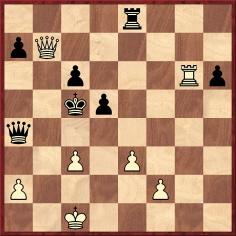
30 Rxc6+ and mate next move.
(2189)
See Capablanca v Steiner (Living Chess).
A severe defeat for Tartakower:
Holger Norman Hansen – Savielly Tartakower
Copenhagen, 5 January 1923
Caro-Kann Defence
1 e4 c6 2 d4 d5 3 Nc3 dxe4 4 Nxe4 Nf6 5 Nxf6+ exf6 6 Nf3 Bd6 7 Bd3 O-O 8 O-O Bg4 9 Re1 Bc7 10 h3 Bxf3 11 Qxf3 Qxd4 12 Re4 Qd5 13 c4 Qa5 14 b4 Qxb4
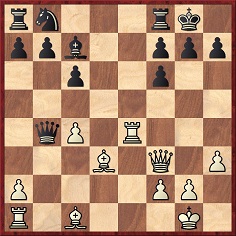
15 Bh6 Be5 16 Rxe5 fxe5 17 Qf5 Rd8 18 Qxh7+ Kf8 19 Bxg7+ Ke8 20 Qh8+ Kd7 21 Bf5+ Kc7 22 Bxe5+ Rd6 23 Qc8+ Kb6 24 Rb1 Resigns.
Source: Wiener Schachzeitung, March 1923, page 4.
(2295)
‘It is only a strong player who knows how weakly he plays.’
S. Tartakower, Chess Pie, 1922, page 28.
(2408)
Tartakower related an incident which occurred at Carlsbad, 1923:
‘… Teichmann, who did not like to overdo it, had accepted the draw offered by Réti when the tournament director, Mr Tietz, who considered that Teichmann had the better position and who “had his interests at heart”, refused to accept the decision and ordered the battle to continue. Teichmann then went for outright simplification … and soon sank. Was such a result not unfair?’
Source: Les Cahiers de l’Echiquier Français, issue 24, pages 244-245.
(2465)
‘Habe vor guten Zügen keine Angst.’ (‘Of good moves have no fear.’)
Savielly Tartakower, Deutsche Schachzeitung, December 1927, page 354.
(2513)
Bernd Graefrath (Mülheim an der Ruhr, Germany) raises the subject of wrong announcements of mate and quotes from pages 48-49 of Tartakower’s book Schachmethodik (Berlin, 1929):
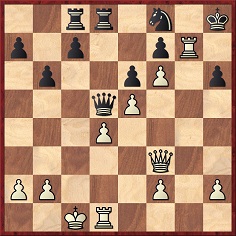
P. Johner-H. Mattison, Debrecen, 1925
White played 25 Qg4, and Tartakower wrote that here White incorrectly announced mate in six moves, whereas the winning line was 25 Rdg1 (‘!!’) Ng6 26 Qe3 or 25…Nh7 26 Qd3.
As the game went, White lost (after 25 Qg4 Ng6 26 Qh5 (‘?’) Qc6+ 27 Kb1 Qe4+ 28 Ka1 Qh4, etc.).
(Kingpin, 1999)
The above item on page 292 of A Chess Omnibus included this footnote:
The following analytical note was added by the editor of Kingpin: ‘Tartakower did not offer the strongest continuation for White after 25 Rdg1 Nh7, for 26 Qd3 allows Black to prolong the game by 26…Nxf6 27 exf6 Qc5+!. After 25…Nh7 White can force mate by 26 Rxh7+ Kxh7 27 Qh3+ Kh8 28 Qe3. In the diagram position White could have announced mate in ten: 25 Rdg1 Ng6 26 Qe3 Nf4 27 Qxf4 Qc4+ 28 Kb1 Qd3+ 29 Ka1 Qh3 30 Qe4 Qf5 31 Qh4 h5 32 R1g5 Qh7 33 Rxh7+ Kxh7 34 Qxh5 mate.’
An excerpt from an article on pages 1-4 of Ajedrez, January 1930 by Tartakower (in which he referred to himself in the third person):
‘In the great tournament in Pistyan, 1922, Tartakower managed to win his games against the two winners of the event, Bogoljubow and Alekhine.
In the game Alekhine-Tartakower, played in the early stages of the tournament, the loser stated after the game that he had been influenced by the indecisive way Tartakower played many of his moves. (In effect, having won a pawn but unable to find conclusive continuations, Tartakower was far from satisfied with his moves.) The battle should have finished in a draw, and it was only because of a serious mistake – extremely rare for him – that Alekhine lost the game.
Not wishing to incur further reproaches of the same kind, Tartakower then resolved to exercise even more self-control with all his moves. However, in Tartakower v Bogoljubow the loser claimed after the game that he had been influenced by the resolute way Tartakower played his moves.
As may be seen, it will never be possible to conduct the battle to the full satisfaction of the loser, who will always find some claim or other to make.’
(2540)
When asked to name the best annotator, Tartakower replied (Wiener Schachzeitung, June 1929, page 169):
‘Kostić, who always pours out his soul, which is most amusing and instructive.’
Kostić was hardly illustrious as an annotator, but the exact point of Tartakower’s apparent quip is unclear.
(2545)
A few extracts from an article ‘Secrets of San Remo, 1930’ by S. Tartakower on pages 421-424 of CHESS, 20 August 1939, starting with a characteristic piece of whimsy:
‘Now for some words on the Committee at San Remo. They promised an annual tournament but this promise was forgotten among subsequent events. In 1930 fascism did not show itself externally – except by the strictness with which the railway officials forbade travellers to put their feet on the seats! But inwardly the attentive observer was able to see that the regime sought to change, little by little, the Italian spirit.
… The tournament itself was, of course, an unparalleled triumph for Alekhine, who increased his prestige enormously and also his dictatorlike position in the chess world. Showing an extraordinary mastership of theory, strategy and technique, he won 13 games out of 15 and, without a loss, had only two draws. Even these two – playing Black against Spielmann and Bogoljubow – were annoying to his conquering spirit and for half a year afterwards he was showing in his travels how he could have obtained a decisive advantage in these two games also!
… Alekhine’s “will to win” was well shown in the last round by his game against Grau, which lasted until late at night – the last contest of the tournament! – for it was a numerically equal ending with bishops of different colours. The poor Argentine master could not understand the reason for all this persistence but, as Alekhine explained later, he wished not only to better his score but continued also for the artistic reason of realizing a hidden advantage that he had seen for a long time.
… In the game Alekhine-Rubinstein played in the fourteenth round – the one before the last – it appeared to be to Alekhine’s advantage to try for a draw, which would give him first prize, rather than chase an uncertain win. When somebody suggested to Rubinstein before the game that he would do well to accept such a pacific situation the great Akiba replied: “A Rubinstein always plays to win!”
Lacking thus a quiet and objective outlook, Rubinstein fell into an opening trap which cost him a pawn and, despite a heroic resistance, the game.’
(2587)
Christian Sánchez (Rosario, Argentina) queries statements of Tartakower’s about the game between Grau and Alekhine, i.e. that it was a middle-game, rather than an endgame, with bishops of opposite colours and that although Tartakower spoke of a ‘hidden advantage’ Alekhine was a pawn ahead. Our correspondent also wonders why the game was ‘the last contest of the tournament’, given that Grau resigned after Alekhine’s 38th move.
(2604)
See too C.N. 10489 below.
Euwe gave an assessment of Tartakower on pages 106-107 of the April 1956 Chess Review:
‘Tartakower was all action – in gestures and in words. He possessed within him all the good, and perhaps also a few of the bad qualities. He did occasionally appear quarrelsome and once, by overstrictly applying the letter of a regulation, incurred an unsportsmanlike odium. He raised or made up controversies. But, personally, he usually remained in the background, taking sides with one or the other, but without showing partiality to friends. Just as passionately as he at one time championed the interests of “X”, he would next time combat the opinions of that same “X”.
Tartakower had a special word of encouragement for the newcomers who underwent a trying time when their debut fell short of being overwhelmingly convincing. “All of us required a lot of time to learn the game.”
Tartakower was not a “joiner”, and he hated mass demonstrations When the case “Alekhine” came up, following the 1946 London Tournament, Tartakower held aloof. “Everybody now criticizes Alekhine’s anti-semitism. For all that, didn’t we know about it all of 15 years ago?” And Tartakower proceeded to take up a collection for Alekhine who was then in destitute circumstances in Portugal. He signed himself up for a pound sterling. He took up the cudgels for the underdog, but he defended himself personally against those holding the upper hand, also and specifically on the chessboard. A remark such as “Alekhine is unbeatable” could drive him into a rage and provoke him to such a degree that, in his next encounter, he played a class above his own strength, against which the unsuspecting Alekhine could not hold his own.
In the 1922 Pistyan tournament, as Black, he commenced his game with Alekhine in the following defiant fashion: 1 d4 d5 2 c4 c6 3 Nf3 Nf6 4 cxd5 cxd5 5 Nc3 Nc6 6 Bf4 Ne4?! – and won in 31 moves.’
In an interview he gave towards the end of his life, Euwe had the following exchange with Hans Bouwmeester:
‘Euwe: Tartakower was a very interesting man – a paradox. A fine, often trenchant, writer. When, in London in 1946 Alekhine’s collaboration with the Nazis came into question, Tartakower maintained that it was not for us but for the French Government to judge the case. That Alekhine was anti-semitic, we have all known since 1934, he said.
Bouwmeester: Some say that Tartakower was organizing a collection for Alekhine around that time?
Euwe: I recall that – but with Tartakower you never knew whether he was serious or not.’
Euwe also stated: ‘Alekhine may have hoped the Germans would win because he owned several houses in Leningrad. As things went, he lost everything …’
Source: CHESS, September 1981, page 199.
Finally, to return to the Chess Review article, Euwe concluded with a reminiscence about Tartakower at the Hastings, 1945-46 tournament:
‘In every phase he performed the most wonderful feats; for example, winning an endgame of two rooks and two pawns apiece even though his opponent, Denker, had the advantage of a dangerous, passed pawn. “Are you playing to win?”, Denker asked. “The position plays for a win”, Tartakower replied in his peculiar, mystic style. He continued the game and won, unendangered.’
We have asked Arnold Denker whether such an exchange occurred as described, and he has replied to us as follows:
‘It is all correct and the good doctor gave me a lesson I will never forget.’
(2605)
Posted at the top of the main C.N. page on 8 August 2025:
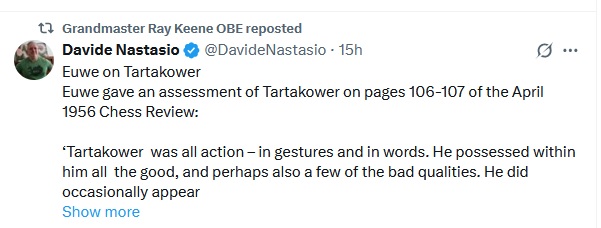
And in today’s Copying news, on X/Twitter Davide Nastasio lifts without credit an entire C.N. item (over 500 words) on Tartakower, and Raymond Keene reposts it.
Tartakower on Najdorf and Tartakower:
‘As for me, I am unfortunate enough not to possess a happy temperament like Najdorf, who views every happening in a rosy light and avoids every possibility of self-criticism.
I am one of those unlucky skeptics who never overlook the dark side of even the happiest experience.’
Source: Chess Review, June 1951, page 170.
(2685)
A game extensively (and generously) annotated by Tartakower on pages 1075-1077 of the December 1930 issue of L’Echiquier:
J. Cukierman – Savielly Tartakower
Paris (City Championship), 1930
Queen’s Indian Defence
1 d4 Nf6 2 Nf3 b6 3 c4 Bb7 4 g3 c5 5 d5 e6 6 Nc3 exd5 7 cxd5 b5 8 Bg5 b4 9 Ne4 d6 10 Bxf6 gxf6 11 Qa4+ Ke7 12 Nh4 Bc8 13 Bg2 Qb6 14 Rc1 Na6 15 Qb3 Bh6 16 Qf3 f5
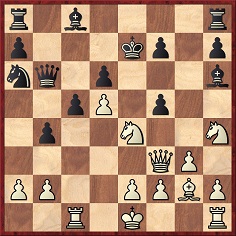
17 Rc4 (Tartakower called this ‘une réponse foudroyante’ and appended two exclamation marks.) 17…fxe4 18 Rxe4+ Kf8 19 Qf6 Bg7 20 Qe7+ Kg8 21 Qe8+ Bf8 22 Re7 Be6 23 dxe6 Rxe8 24 exf7+ Kg7 25 fxe8(Q)+ Resigns.
(3106)
Giordano Bergamo (Cavareno, Italy) writes:
‘I have noticed that in Réti’s Masters of the Chess Board Tartakower is the only grandmaster criticized personally. Had there been enmity between Réti and Tartakower?’
What criticism the book contains seems quite covert. The best-known account of bad blood between the two masters is probably Golombek’s on pages 67-68 of Chess Treasury of the Air edited by T. Tiller (Harmondsworth, 1966). Golombek quoted Tartakower as telling him, ‘Réti was a dreadful liar’.
When Réti died, Tartakower published an article about him on pages 212-214 of the July 1929 Kagans Neueste Schachnachrichten, but it focussed on Réti’s hypermodern opening play. Did the two masters write about each other elsewhere in more personal terms?
(3176)
Tartakower told a story of attempted bribery on page 1 of My Best Games of Chess 1905-1930 (London, 1953). It concerned Barmen, 1905, where he had finished equal first in his group with G. Shories.
‘Although I had beaten him in our individual encounter, I had nothing against playing off a deciding match with him; in this, however, the tenacity of my rival proved to be superior.’
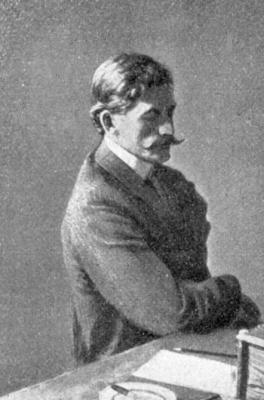
Georg F.W. Shories (Barmen, 1905 tournament book, page 486)
Tartakower then added this footnote:
‘For many a long year I considered myself as frustrated in my efforts – amongst the causes for this being the fact that Shories, after he had lost the first game of the match, made me a proposition by which he was to “cede” me the title of master – an offer that I naturally rejected (since it was not to “buy” but to “conquer” the title of master that I had come to Barmen), but this beyond doubt had an unfavourable influence on me in the subsequent course of the match. Nevertheless, viewing the events from the historical perspective (and therefore more objectively), I now deem that at that time my play was not yet sufficiently mature to be crowned with complete success.’
After the Shories Pecuniary Solatium Declined, the match continued and, as noted on page 261 of the September 1905 Deutsche Schachzeitung, Tartakower lost by an overall score of two games to one with one draw.
(3219)
When he published the following light game on pages 21-22 of Winke für die Schachstrategie (Berlin and Leipzig, 1927), Tartakower commented:
‘A player with the forename of the great Lasker and the surname of the great Akiba is certainly predestined to brilliant achievements.’
P. – Emanuel Rubinstein
Cracow, 1924
Kings’s Gambit Declined
1 e4 e5 2 f4 Bc5 3 Nf3 d6 4 Bc4 Nf6 5 Qe2 Nc6 6 fxe5 dxe5 7 Bxf7+ Ke7 8 Bb3 Nd4 9 Nxd4 Qxd4 10 d3 Bg4 11 Qd2 Rad8 12 h3
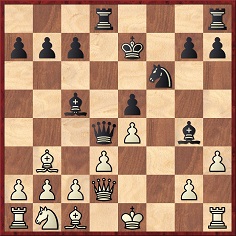
12…Nxe4 13 dxe4 Qf2+ 14 Qxf2 Rd1 mate.
Information about Emanuel Rubinstein will be gratefully received.
(3267)
See the subsequent item C.N. 3499.
The following quote comes from an article by Hans Kmoch and Fred Reinfeld on pages 9-11 of the January 1951 Chess Review:
‘… Tarrasch was given short shrift by Mijnheer te Kolsté of Holland in the Baden-Baden tournament held in 1925. Te Kolsté had turned up as a rather inadequate substitute for Dr Max Euwe. Approximately seven feet tall, weighing 250 pounds and with hands the size of a chessboard, te Kolsté presented a formidable appearance. His accomplishments were by no means so formidable, and te Kolsté represented little more than a bye in the tournament. For example, during his game with te Kolsté, Tartakower spent most of the time chatting with Alekhine, and, at one point, seeing that te Kolsté had made a move, Tartakower interrupted the conversation with the remark: “Excuse me, I have to see whether my opponent has left his queen en prise.” And, sure enough, he had done just that.’
Whether Jan Willem te Kolsté (1874-1936) was really about 2.13 metres tall we are unable to say, but the well-known group photograph taken at Baden-Baden, 1925 does not give that impression. As regards the Tartakower game, it may be thought that a more likely, and less derisive, comment would be (after 16…Qe7), ‘Excuse me, I have to see whether my opponent has left his queen to be trapped’.
(3308)
‘Tartakower has probably played more tournament games than any three masters alive.’
So wrote Reuben Fine on page 169 of Chess Marches On! (New York, 1945), but the remark is a considerable exaggeration, whichever cut-off point is taken. For example, the table on pages xv-xvi of Tartakower’s first Best Games collection indicated that from 1906 to 1930 he played 880 tournament games, and his second volume (pages xi-xii) gave the total as 714 for the period 1931-55.
(3353)
C.N. 3377 asked why, on page 65 of Ideas modernas en las aperturas de ajedrez (fifth edition, Buenos Aires, 1967), Tartakower referred to 1 e4 Nf6 2 Nc3 as the ‘Variante del Yatagán’. A subsequent item (C.N. 3392) noted that page 107 of the same book affirmed that the pawn formation e3-d4-c3 was known as ‘the Juncosa triangle’ in Spain and as ‘the Brake triangle’ in England. The explanation for ‘Brake’ has yet to be found.
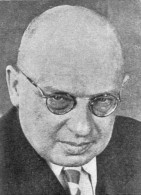
Savielly Tartakower
(3516)
Below is a photograph of the participants in Spa, 1926:
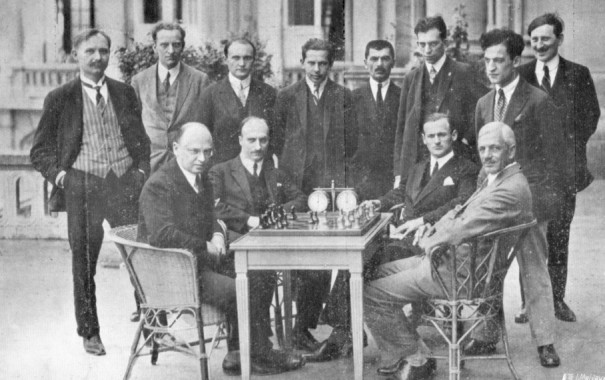
From left to right (standing):
A. Lenglez, M. Varlin, A. Tackels, A. Dunkelblum, V.
Soultanbéieff, I. Censer, G. Koltanowski, J. Davidson.
Seated: S. Tartakower, M. Romih, F. Sämisch, Sir George
Thomas.
(3554)
On page 109 of the May 1956 Chess World M.E. Goldstein stated that Savielly Tartakower (‘a many-sided genius’) had been ‘a competent poet in Russian, German and French’. Wanted: further information.
(3787)
From Hans Kmoch’s obituary of Tartakower on pages 123-125 of Chess Review, April 1956:
‘Few people knew how much he liked poetry – poetry in all the three languages of which he had perfect command: Russian, German and French, to say nothing of Latin and Greek. Translating poems was his secret hobby.’
(3833)
From Alexei Shirov (Riga):
‘Towards the end of the 1990s, or possibly in 1995-96, the Russian magazine Shahmatny Vestnik published an article on Tartakower’s poetry in Russian, giving the text of some poems (which were rather average in my view, but by no means bad) and also citing Nikolai Gumilev (a well-known Russian poet), who expressed a rather high opinion of Tartakower’s literary abilities.’
Can a reader trace the article in question and kindly send us a copy?
(3863)
From Richard Forster and Tomasz Lissowski (Warsaw):
‘Sergei Voronkov discussed Tartakower’s poetic achievements in an article on pages 45-47 of the 3/1998 Shakhmatny v Rossii. He also referred to another article on Tartakower by Yuri Arkhipov in 64 – Shakhmatnoe Obozrenie, 5/1987, pages 24-26.
In 1911 Tartakower had a 56-page booklet Neskol’ko stikhotvorenii (“A few poems”) published in the edition “Nauka i zhizn’” in Rostov-on-Don. It consisted of two parts: “Dissonansy” (22 eight-line compositions) and “Accordy” (13 longer poems). The well-known critic Nikolai Gumilev reviewed it in the literary magazine Apollon (No. 10, 1911; the review was subsequently reprinted in Gumilev’s “articles and notes on Russian poetry”). He found that Tartakower was a true poet, with focussed thoughts and great inner experience. On the other hand, he noted: “But he has no feeling for the Russian language; worse still, he does not know it! His syntax is impossible, his vocabulary preposterous.” Gumilev concluded that Tartakower would do better to write his poems in Yiddish, “and then his poems would be much more interesting to read in translation”.
Voronkov further showed that, contrary to what most (Western) sources state, the pogrom in which Tartakower’s parents were killed occurred not in 1899 but in 1911 (although the infamous and best-known Jewish pogroms in Rostov took place in 1905). Tartakower refers to this in one of his own poems (our translation):
One More, The Final Dissonance
(on the death of the parents)
A whole century of surrenders, tears, and strains.
And for whom? For children, who live safe
In foreign lands. If you ask them:
“Easy life, eh, old men?”, “Yes” – they answer.
Returning home in the early morning
I took and opened the telegram: “Your parents killed.”
I hurried. I buried. The iron plates
of two bloody graves lie on my heart.The fact that Tartakower’s poems were published in Rostov in 1911 suggests that despite attending a college in Geneva and spending much of the first decade of the twentieth century in Vienna, he was still maintaining ties with his native city at that time.
Tartakower translated numerous Russian poems into French and German for various journals. In 1922 and 1923 he had two anthologies published in Berlin with poems which he had translated into Russian. Another one (Das russische Revolutionsgesicht, published around 1923) was devoted to contemporary Russian poetry translated into German. In later years, when publishing poems of his own Tartakower assumed the name “Rewokatrat”, i.e. Tartakower in reverse.
With his obscure Russian brochure Antologiya lunnykh poetov (“Anthology of lunar poets”) “Rewokatrat” even attracted the attention of Vladimir Nabokov. The great writer’s final verdict, however, was quite devastating: “Write, but do not think it is poetry.” (Review in the Russian-language paper Rul’ (Berlin), 6 June 1928. See also Nabokov’s collected Russian-language works in five volumes, St Petersburg 1999-2000, volume 2, pages 660-661.)
Voronkov’s article gave a number of Tartakower’s poems from 1911 and discussed his whereabouts during the First World War. He also mentioned Tartakower’s brother Artur (cf. C.N. 3946), who was one year his junior and also a law student at Vienna University. He died on 19 November 1914 on the battle-ground near Katowice (in Silesia, then a part of the German Empire and nowadays in Southern Poland).’
(4089)
Two chess poems by Tartakower in German were published on page 74 of Kagans [or sometimes, as here, Kagan’s] Neueste Schachnachrichten, January 1922 and on page 170 of the April 1922 issue:
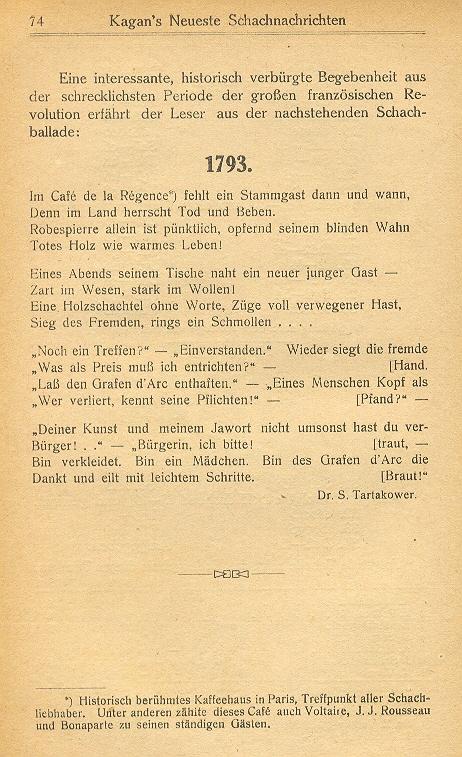
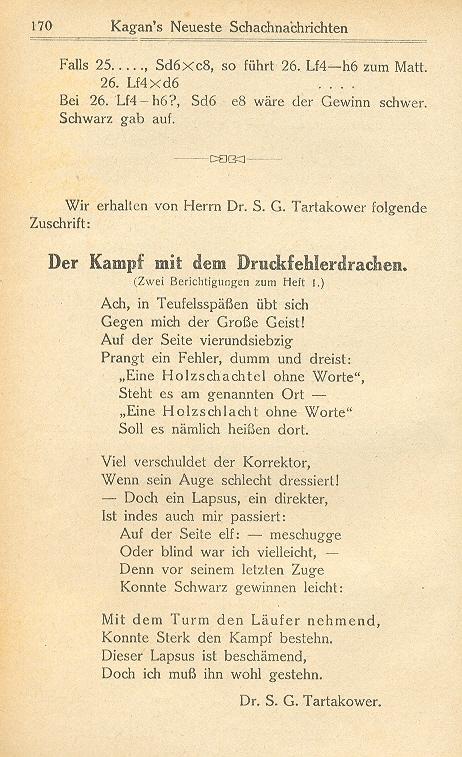
(4278)
Tartakower’s poetry has been discussed in C.N.s 3787, 3833, 3863, 4089 and 4278, but what is known about his non-chess prose output? Perhaps a reader can expand upon what Harry Golombek wrote on page 69 of Chess Treasury of the Air by Terence Tiller (Harmondsworth, 1966):
‘He produced monographs on all kinds of philosophic and scientific subjects. I remember that once, for instance, he was engaged on a work dealing with the relationship between colours and sounds.’
(4464)
David Lovejoy (Mullumbimby, NSW, Australia) suggests that the Robespierre item given in C.N. 4467 may have been the source for Tartakower’s poem ‘1793’ presented in C.N. 4278.
(4486)
A contribution from Michael Negele (Wuppertal, Germany) concerns a non-chess book by Tartakower, Das russische Revolutionsgesicht (Vienna, 1923).
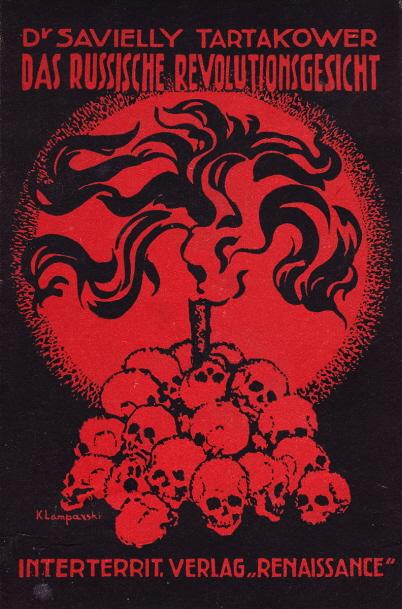
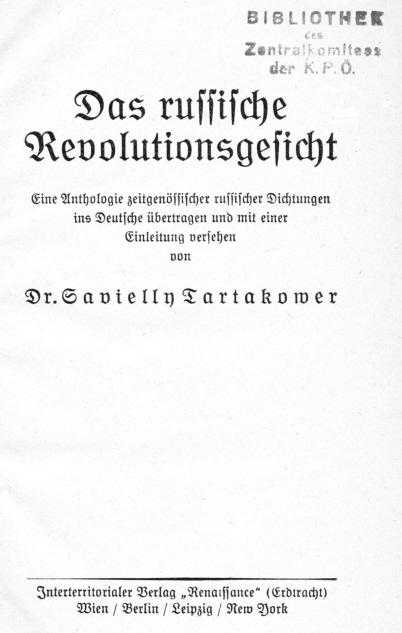
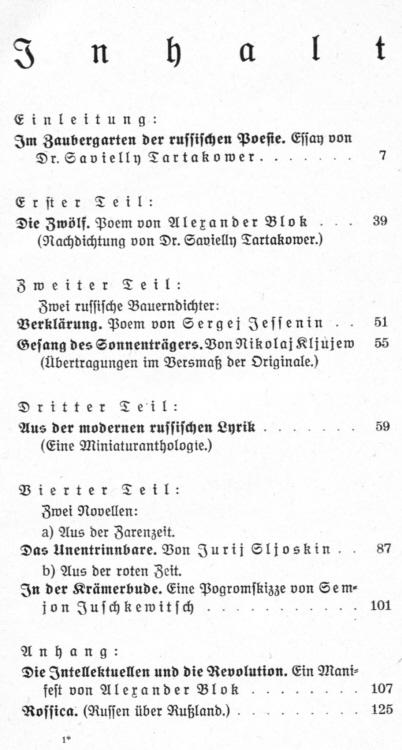
(7870)
David Lovejoy asks whether anything substantial has been written about the life of Savielly Tartakower, beyond his own two-volume collection of best games. We believe not. There is a small monograph on him, Ksawery Tartakower by Stefan Witkowski (Warsaw, 1994), but little else.
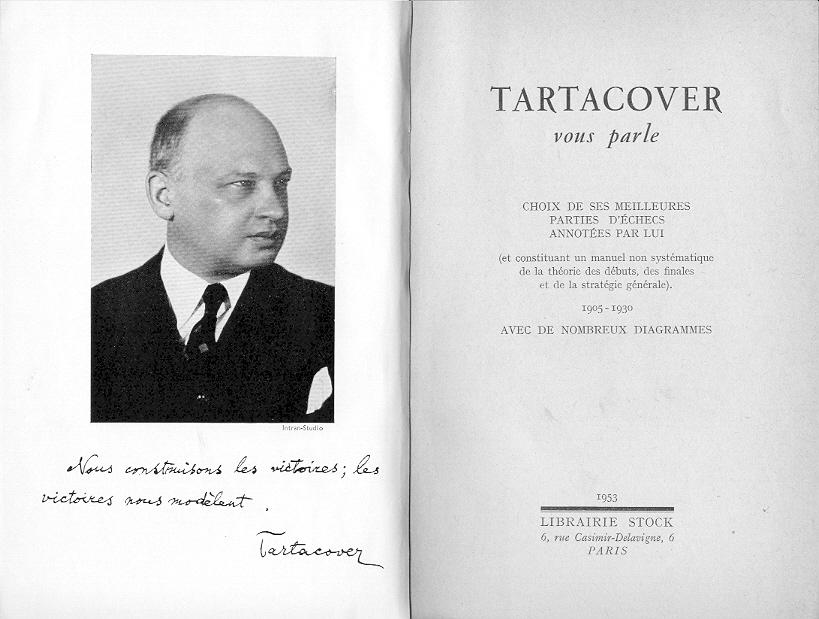
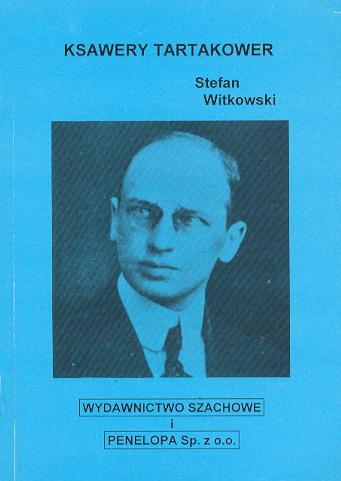
As regards Tartakower’s own extensive writings, some of his most interesting reminiscences appeared in a series of articles in Chess Review in the early 1950s. They included forgotten specimens of his play, and below is an excerpt from ‘End-game secrets’, on pages 328-329 of the November 1951 issue:
‘This position is from a skittles game played recently in Paris:
Fleck v Tartakower
Fleck has attacked furiously, but I have managed to reach a position in which, paradoxically enough, the win is impossible. There follows:
1 Rd7+ Ke8 2 Kh3 (White’s last hope is to arrive at a Zugzwang position in which he can win [Black’s] sole remaining – and very annoying – pawn.) 2...Re3! Drawn.
“How unlucky the amateurs are”, Monsieur Fleck complained after the game. “Even when they succeed in winning material against the master, their efforts are not crowned with ultimate success.”
“We are saved by routine”, was my reply.
This example (from a simultaneous exhibition in Barcelona, 1935) is a companion piece to the previous position. Black plays with amazing resourcefulness and self-control.
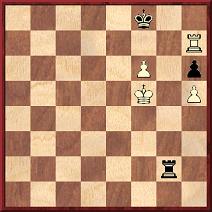
Tartakower v Amateur
1...Rf2+ (And not the plausible 1...Rg5+? 2 Ke6, after which White wins.) 2 Kg6 Rg2+ 3 Kxh6 (Now White is two pawns up, but his king is marooned.) 3...Rg1 4 Re7 (The continuation 4 Rg7 Rxg7 5 fxg7+ Kg8 6 Kg6 results in stalemate.) 4...Rf1 (But not 4...Kg8 5 Rg7+ Kh8 {if 5...Rxg7 6 fxg7 Kf7 7 Kh7 and White wins.} 6 Rg5 {not 6 Rxg1?? with stalemate, likewise after 6 f7?? Rg6+} 6...Rf1 7 Kg6 and White wins.) 5 Re6 Kf7. (The game was given up as a draw. Bravo, Amateur!)
These miraculous examples of last-minute salvation remind me of a miraculous ending, never previously published, that turned up in a skittles game played by Dr Alekhine and myself at the Palais Royal Chess Club in Paris on 23 July 1925.
Tartakower v Alekhine
1...Ra5+ (Or 1...Kb3 2 Ke5 Kb2 3 d5 c1(Q) 4 Rxc1 Kxc1 5 d6 Kd2 6 d7 Ra8 7 Ke6 Ke2 8 Ke7 Kf3 9 d8(Q) Rxd8 10 Kxd8 Kg3 {or 10...h5 11 Ke7 Kg3 12 Kf6 Kxh4 13 Kg6 Drawn}11 h5! Kxh3 12 Ke7 Kg4 13 Kf6 Kxh5 14 Kf5 and White draws!) 2 Ke6! Rh5 3 d5 Rxh4 4 d6 Rxh3 5 d7 Rd3 6 Ke7
6...h5 (Or 6...Kb3 7 d8(Q) Rxd8 8 Kxd8 Kb2 9 Ke7 c1(Q) 10 Rxc1 Kxc1 11 Kf6 drawing.) 7 d8(Q) Rxd8 8 Kxd8 h4
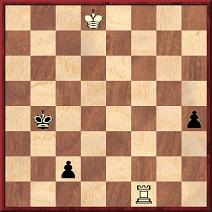
(Now the black pawn seems out of the white king’s reach; yet, by what seems nothing short of a miracle, the king can catch up to the pawn. A similar theme has been utilized by several endgame composers, among them Réti.) 9 Ke7 h3 10 Kf6 h2 (Again, if 10...Kb3 11 Kg5 Kb2 12 Kg4, drawing. Now that the rook pawn has advanced to its seventh rank, however, White is in a position to demonstrate a more piquant drawing method, in which his rook does most of the work. His king’s cooperation is no longer required.) 11 Ke7 (Also possible, of course, is 11 Kg5 Kc3 12 Kg4 Kb2 13 Kg3 c1(Q) 14 Rxc1 Kxc1 15 Kxh2, drawing. But the method selected by White is more amusing.) 11...Kc3 12 Rh1 Kd3 13 Kd8 Ke3 14 Ke7 Kf3 (Black threatens 15...Kg2.) 15 Rc1! Ke3 (Now he threatens 16...Kd2.) 16 Rh1! Drawn.’
(3900)
Claes Løfgren (Randers, Denmark) writes:
‘An addition worth mentioning to the sparse Tartakower literature is Schack-parad 2: Stormästaren Tartakower (Stockholm, 1987) by Erik Lundin. This fine book is based on autobiographical articles by Tartakower published in Tidskrift för Schack between 1947 and 1955, bound together with comments by Lundin and others. It features many wonderful games, anecdotes and reminiscences about tournaments and fellow masters throughout his career of almost 50 years.’
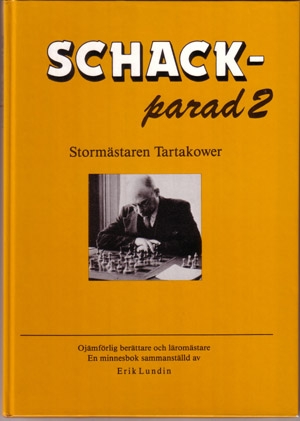
(3904)
To the small number of volumes on Tartakower mentioned in C.N.s 3900 and 3904 Yakov Zusmanovich (Pleasanton, CA, USA) adds:
‘There was a 32-page Czech booklet “Remízové” vĕžovky S.G. Tartakowera by Josef Hladík (Brno, 1995). It contains 60 rook endings by Tartakower played between 1907 and 1951.’
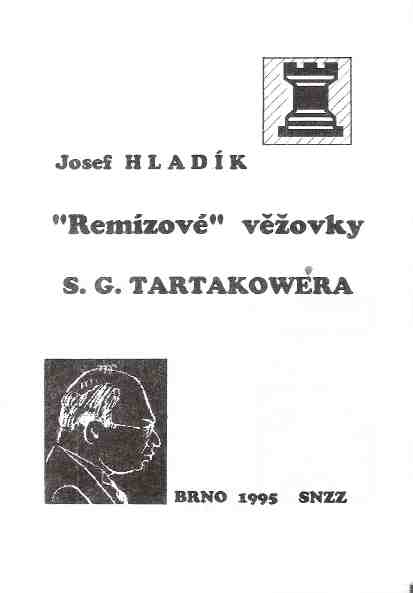
(4147)
A group photograph from London, 1927:

Seated from left to right: F.J.
Marshall, W. Winter, E. Bogoljubow, A. Nimzowitsch, W.A.
Fairhurst, S. Tartakower.
Standing: W.H. Watts, M.E. Goldstein, H. Kmoch, M. Vidmar,
R.C. Griffith, Sir George Thomas, E. Busvine, F.D. Yates, J.
Schumer, E. Colle, V. Buerger, R. Réti
(3959)
In a short item on pages 78-79 of All About Chess (New York, 1971) Al Horowitz wrote:
‘If any game is to be dubbed the “Immortal Zwischenzug”, it is this one, played in the great tournament of New York in 1924.’
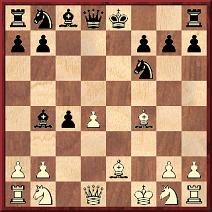
After Tartakower’s 9 Bxb8 Capablanca played his famous move 9...Nd5.
(4107)
In the late 1930s Julius du Mont was preparing, jointly with Tartakower, the 665-page book 500 Master Games of Chess. Although it was not published until 1952, the manuscript was delivered in 1939 (see the BCM, April 1952, page 105 and May 1952, page 133). It would be exceptional if, in 1938-39, du Mont were able to work concurrently on both that huge project and a translation of the Alekhine book, quite apart from finalizing in 1938 The Basis of Combination in Chess.
(4436)
Richard Hervert (Aberdeen, MD, USA) notes that 500 Master Games of Chess by S. Tartakower and J. du Mont (London, 1952) did not refer to ‘Boden’s Mate’ in connection with Schulder v Boden; the finish was described on page 200 as a ‘diagonal cross-mate’. Can instances of the term ‘Boden’s Mate’ be found prior to publication of L’art de faire mat by G. Renaud and V. Kahn (Monaco, 1947)?
As mentioned in C.N. 4436, the manuscript of 500 Master Games of Chess was delivered in 1939. C.N. 626 also discussed the book’s genesis and noted the final paragraph of the authors’ Preface, where thanks were expressed:
‘Also, and in particular, to Miss Joan Kealey, now Mrs Ronald Smith, who, out of over 8,000 games, copied and in part translated well over 2,000 for final selection, an undertaking which she carried out with exemplary thoroughness and accuracy.’
In C.N. 626 we wondered why such a lengthy process was necessary. Joan Kealey was acknowledged for playing a similar role in 200 Miniature Games of Chess by J. du Mont (London, 1941); see the book’s Preface. On 2 June 2011 Leonard Barden wrote about her at the English Chess Forum.
In 1954 Tartakower and du Mont brought out 100 Master Games of Modern Chess. Virtually all the games were played in the 1940s and 1950s.
(8504)
As any random survey of chess bibliographies will show, reprints often result in the provision of confusing information, even when there is no change of title. To take one well-known work:
Any bibliography which lists 500 Master Games of Chess is, of course, at liberty to cite any of these editions, as long as the details are correct and it is specified that the book was first published in 1952. Instead, this kind of thing is offered:
Page 248 of The Complete Chess Addict by M. Fox and R. James (London, 1987).
Page 371 of Frank Marshall, United States Chess Champion by A. Soltis (Jefferson, 1994).
Page 147 of Winning with Reverse Chess Strategy by W. Reuter (Davenport, 1998).
Page 256 of The 100 Best Chess Games of the 20th Century, Ranked by A. Soltis (Jefferson, 2000).
Page 3 of Play the Ponziani by D. Taylor and K. Hayward (London, 2009).
Page 5 of The Rules of Winning Chess by N. Davies (London, 2009).
Page 6 of Giants of Innovation by C. Pritchett (London, 2011).
Unable to write ‘du Mont’, Soltis wrote him out. From page 93 of The Wisest Things Ever Said About Chess (London, 2008):
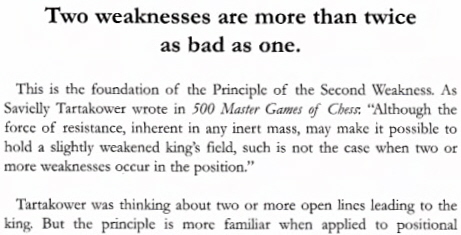
The passage cited is on page 55 of Tartakower and du Mont’s book.
(8827)
Much writing on chess history is wishful thinking or name-dropping, but careful authors sidestep the trap of what we propose to call ‘figurehead romanticism’. This includes, for example, claims or assumptions that most of the contents of Lasker’s Chess Magazine and Capablanca-Magazine were written by Lasker and Capablanca themselves. (The case of the International Chess Magazine is different, since Steinitz specified that it was largely a solo enterprise.)
A similar practice was mentioned in C.N. 8827: attributing a book by Tartakower and du Mont to Tartakower only. When there is assisted authorship (such as Kasparov books involving Donald Trelford or Mig Greengard, both of whom receive a ‘with’ credit), some writers need no second bidding to prefer without; they mention Kasparov alone. We can see a case for that in brief bibliographies, but not in reviews or discussions of the book.
(12043)
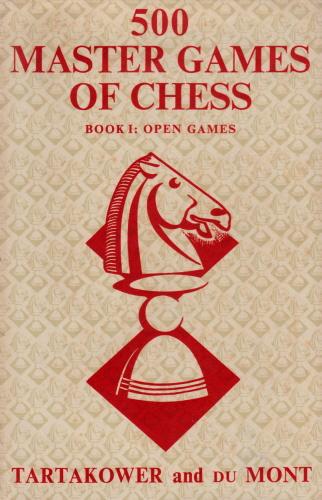
Further to C.N. 8824, another example of the approach to chess literature adopted by CHESS is provided on page 138 of the April 1952 magazine (the issue after the one asserting that with The Chess Mind Gerald Abrahams had ‘crashed between two stools’). Reviewing 500 Master Games of Chess, B.H. Wood began by referring to the size of his library:
‘We too find ourselves gazing at new books with a more and more jaundiced eye and are wondering whether our libraries have something to do with it. Have we seen too many chess books? Is originality becoming rarer, or are we only beginning to realize how rare it always was? As we ransack book after book in vain for a spark of real newness and our disappointment mounts into fury, we retain just sufficient self-control to ask “If this were the fifth chess book we had handled instead of the five-thousandth, mightn’t we be enjoying it enormously?”Could the value of a book to the average reader better be assessed – by an average reader? Would you go to a jaded old roué for an opinion on the delights of romance?
Here is a book, 500 Master Games of Chess, written by two old friends whose feelings we hate to hurt, about which we can hardly find a good thing to say. To some it may be a wonderful anthology of the richnesses of the past century and more. To us it is only a laboured rehash of games which have appeared in print before, some of them ten, 20 or 30 times in as many different publications.’
After examining some games and notes Wood continued:
‘... knowing the furious rate of development of theory today, what strong player will pay £2 10s 0d for a collection of 500 games, most of which date from the eighteen hundreds? ...
The extensive proof-reading has been tackled hardily, but we found an inaccuracy or an ambiguity in the text of each of the first three games we played through ...
All in all, a sad waste of time, energy, paper and print. A lamentable acceptance of the idea that 500 elephants or Roman gladiators must be better drama than 50.
That is how we feel about it. Is it only our misfortune? Perhaps! Where ignorance is bliss, ’tis folly to be wise!’
The May 1952 issue (page 160) had brief responses from B. Goulding Brown and J. du Mont, and there was a further short letter from du Mont on page 194 of the July 1952 CHESS. The first of du Mont’s letters read as follows (in full):
‘You state: “What strong player will pay £2 10s for a collection of games most of which date from the eighteen hundreds?”, as damaging a statement as could well be made. The fact is that, of the 500 games 153 come from the pre-1900 period, and no fewer than 347 relate to the years 1900-38 (a further volume covering the period 1938 to the present day is in active and advanced preparation).’
(8828)
Tartakower’s oft-quoted commentary on Lasker, Capablanca and Alekhine (see, for instance, pages 3, 18 and 29 of the Baden-Baden, 1925 tournament book published by Caissa Editions in 1991) was presented as follows by Koltanowski on page 52 of the Chess Digest Magazine, March 1972:
‘Tartakower, when Alekhine was stunning the chess world in 1930-33, made this witty remark: “Lasker was world champion, Capablanca is world champion, and Alekhine plays like a world champion.’
Since Alekhine became world champion in 1927, this is just another example of Koltanowski’s difficulty with elementary facts.
(4279)
From an article by the pitifully undependable George Koltanowski, on page 52 of the Chess Digest Magazine, March 1972:
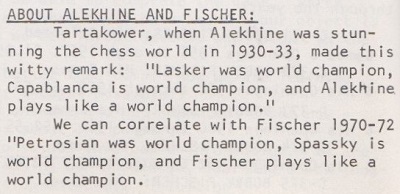
Koltanowski’s reference to Tartakower was given in C.N. 4279, which pointed out that in the 1930s Capablanca was no longer the world champion. We gave mid-1920s references for the remark, and below is what Bernhard Kagan wrote, without identifying the speaker, on page 344 of Kagans Neueste Schachnachrichten, 1 July 1925:

A similar observation (‘Capablanca has the title, Lasker has the results, but only Alekhine has the style of a real world champion’) appeared in an article by Tartakower in issue 4-5 of Shakhmaty, 1925. It was reproduced on page vii of the Baden-Baden, 1925 tournament book by N.I. Grekov (Moscow, 1927):

Elsewhere, Tarrasch has been named in place of Tartakower. From pages 176-177 of The Great Chess Masters and their Games by Fred Reinfeld (New York, 1952):
‘It was the St Petersburg International Tournament [in 1914] that catapulted Alekhine to world fame as a grandmaster and not merely a brilliant player. The main object of attention was of course the duel between Lasker and Capablanca, but Alekhine came very near to stealing the show by thrusting Rubinstein, Nimzowitsch and Bernstein aside and then outpacing Tarrasch and Marshall and coming a fine third to Lasker and Capablanca. It was in this famous tournament that Alekhine first displayed that white-hot fusion of logic and fantasy that was to enthrall chessplayers for three decades; that was to prompt Tarrasch to declare later on that “Lasker used to be the world champion, Capablanca is the world champion, but Alekhine plays as a world champion should play.”’
Given that Alekhine, aged 21, finished well behind Lasker and Capablanca at St Petersburg, 1914 (by a margin of 3½ points and 3 points respectively), it is odd to suggest that he ‘came very near to stealing the show’. What Reinfeld termed ‘a fine third’ was called ‘a poor third’ in the entry on Alekhine in the Oxford Companion to Chess (1984 and 1992 editions) and ‘a bad third’ on page 46 of Championship Chess by P.W. Sergeant (London, 1938).
An earlier claim that Tarrasch made the remark about the three world champions was published on page 86 of Chess World, 1 May 1946, in an article, ‘Glimpses of Alekhine’, by M.E. Goldstein:
‘Before Alekhine defeated Capablanca, Dr Tarrasch, a man not given to fulsome praise, wrote that “Lasker was world champion, Capablanca is world champion, but Alekhine plays as a world champion should play”. To the man in the street, Alekhine was the man to watch – the sacrifice of the queen for a mating attack represented the triumph of mind over matter, which everyone could appreciate. On the other hand, the positional cavortings of a Capablanca or a Rubinstein were beyond the ken of ordinary men.’
When presenting Réti v Alekhine, Baden-Baden, 1925 (under the heading ‘The Gem of Gems’) on pages 110-111 of the 1 June 1946 issue of Chess World, C.J.S. Purdy wrote:
‘We disagree with Mr Goldstein when he says that Alekhine’s chess is easier for the ordinary player to understand than Capablanca’s. Capablanca’s moves may often surprise, but usually their logic is soon apparent after examination. But many of Alekhine’s moves depend on some surprise that comes far too many moves ahead for an ordinary mortal to have the slightest chance of foreseeing it. Alekhine’s chess is like a god’s. One can revere, but never hope to emulate.’
(9384)
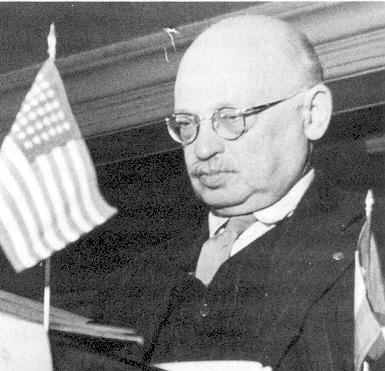
Savielly Tartakower
Concerning the famous ‘Tartakowerism’ about an isolated pawn spreading gloom all over the chess board, readers are invited to use a search-engine for a little test:
a) How many webpages have the quote?
b) How many webpages have it with a source?
(4329)
C.N. 4329 referred to the famous remark about an isolated pawn spreading gloom all over the chess board, a ‘Tartakowerism’ so often seen on the Internet without any source.
Hassan Roger Sadeghi (Lausanne, Switzerland) points out that the remark appeared on page 113 of the second edition of Tartakower’s book Schachmethodik (Berlin, 1929):
‘Ein isolierter Bauer verbreitet Trübsinnigkeit übers ganze Brett.’
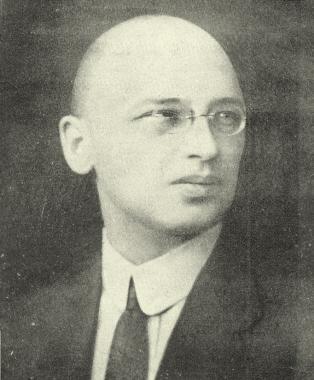
Savielly Tartakower
(5120)
From W.E. Napier’s Amenities and Background of Chess-Play (published in three ‘units’, the first two in 1934 and the third the following year). The figure refers to the item number, given that the pages were unnumbered:
128. ‘A genial disposition shines in all Tartakower’s chess. It is infectious fun. And when he loses a game, he writes sincere eulogies, fit for an epitaph, of the victor.
He is very unusual.’
An extract follows from page 5 of volume one of Chess Characters by G.H. Diggle (Geneva, 1984). Entitled ‘Tartakower saves the day’, it was originally published in the March 1975 Newsflash. As usual, Diggle referred to himself in the third person, as ‘the Badmaster’.
‘Towards the end of the War, the Badmaster (then stationed at an RAOC Depot in London) went along to the Lud-Eagle Chess Club to watch a friendly match between the Club and the “Combined Forces”. Playing top board for the latter was the renowned Tartakower (then known as Lieut. Cartier of the FFF). In those uncertain days picking a “Forces” Team was a precarious operation; sudden unavoidable absence was rife – substitutes had to be roped in at a moment’s notice – and “fools who came to watch remained to play”. Thus the BM found himself in the match, playing White against an opponent about a class and a half stronger than himself. But luckily the time for play was rather short; and at adjudication time the BM was only a pawn down – his remaining pieces, though wretchedly deployed, were still in the shop window. His courteous and easy-going opponent did not immediately proceed to demonstrate a dozen ways of winning, but merely said, “Oh, well, let the bright boys have a look at it” (though there were not so many “boys” brighter than himself present).
When the “bright boys” arrived, they swore to a man that the Badmaster had “had it”. But the result of the match depended on this game, and someone suggested – “Let Cartier have a look at it”. The Great Master, having been fetched, sat down at the board very simply and unaffectedly, and drank in through his spectacles the fruits (and probably the whole deplorable history) of the BM’s afternoon strategy. First he shook his head in silence, but presently (like Dr Johnson) he was perceived to be “rolling himself, as about to speak”, and sentence might well have been instantly pronounced, when the BM was unexpectedly saved by the gong.
The “gong” in question was a blasé voice from the crowd. Just as Cartier was about to speak, the voice pipped him at the post by murmuring in an audible drawl: “BLARK AWBVIOUSLY WINS”. The Great Master paused. Was he merely to nod his head in agreement like a puisne judge, leaving everyone to infer that he, the expert, had only just arrived at a conclusion that had been “awbvious” all the time to the owner of the blasé voice? Instead, he rose to the occasion. “It is difficult”, he began slowly. “It is not quite a clear win for White – I say for WHITE.” (Incredulous sensation among “bright boys”.) “I SAY FOR WHITE”, reiterated the inexorable Cartier, and proceeded to rush through half-a-dozen variations at lightning speed – under his magic touch the white pieces became coordinated in no time, and white passed pawns sprang up like crocuses. Then, before the “bright boys” had got their second wind, the great man looked at his wristwatch, rose from his chair, exclaimed, “Well, perhaps a draw” and departed. Draw duly recorded. The BM staggered back to Barracks in a sort of stupor, vaguely muttering “Thank God for British Justice”.’
(4331)
From Pierre Bourget (Beauport, Canada):
‘Tartakower’s My Best Games of Chess 1931-1954 was translated from French by Golombek, but I have never seen a book in French by Tartakower for that second period. I am aware of a French edition only for 1905-1930, under the title Tartacover vous parle.’
Tartacover vous parle was published by Librairie Stock, Paris in 1953 and is readily available today, having been re-issued by Payot, Paris in 1992. In common with our correspondent, we have no knowledge of a French edition on the years 1931-54.
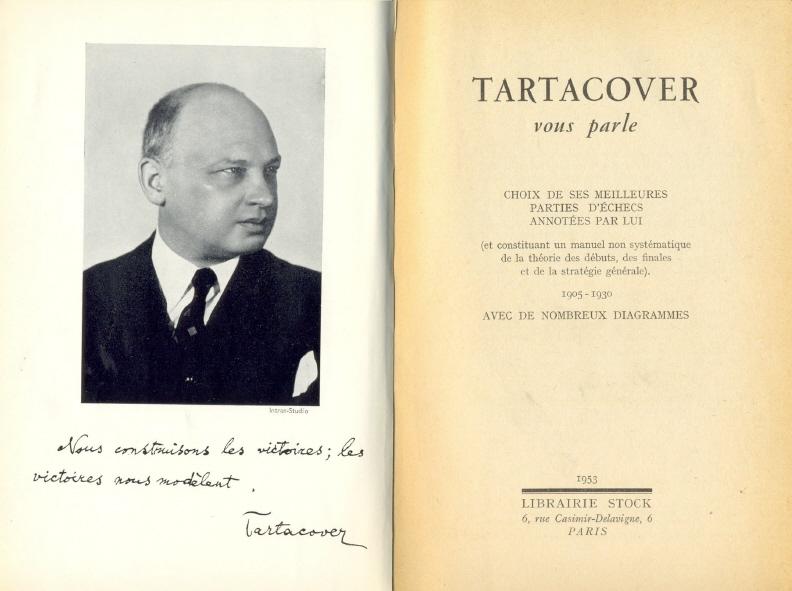
Some further remarks may be added here. My Best Games of Chess 1905-1930 and Tartacover vous parle are not identical. Most notably, the French book had four additional Tartakower games, against Alapin (Munich, 1909), Wolf (Vienna, 1922), Golmayo (Barcelona, 1929) and Font (Barcelona, 1929).
Tartakower is one of the most difficult chess writers to translate into English (among others are A. Nimzowitsch and F.K. Young), but on one relatively straightforward matter Golombek seems to have gone astray. It concerns the conclusion of Tartakower v Rubinstein, The Hague, 1921. The English edition (page 96) reads:
‘In his obstinate search for a saving clause Black here exceeded the time limit, but play continued, and White’s victory was achieved without taking notice of this disagreeable circumstance in the following way: ...’
The idea that play went on after Rubinstein’s flag had fallen is strange, and Tartacover vous parle (page 139) has something altogether different:
‘Dans la recherche obstinée d’un sauvetage, les Noirs dépassèrent ici le temps de réflexion, mais la victoire des Blancs s’obtenait même sans cette circonstance fâcheuse de la façon suivante: ...’
There is nothing about ‘play continued’ in the French version. A revised English translation would read:
‘In his obstinate search for a saving clause, Black here exceeded the time limit, but even without that disagreeable circumstance White would win, as follows: ...’
Golombek appears to have misunderstood ‘s’obtenait’ and to have set off down a wrong path which prompted him to add the words ‘play continued’.
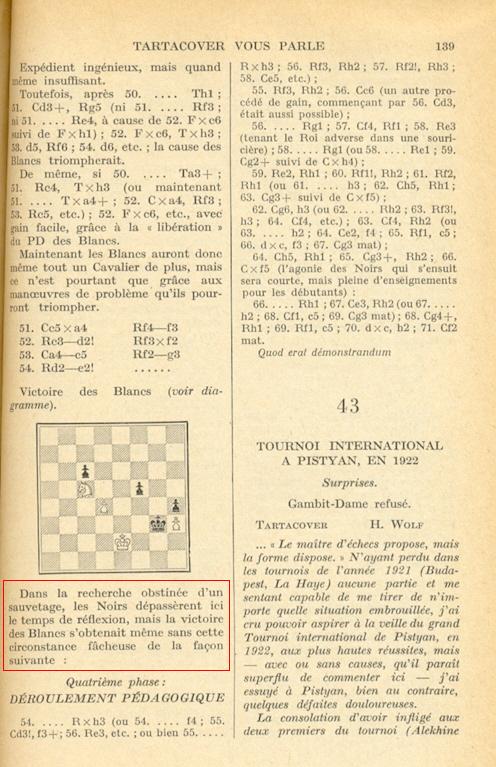
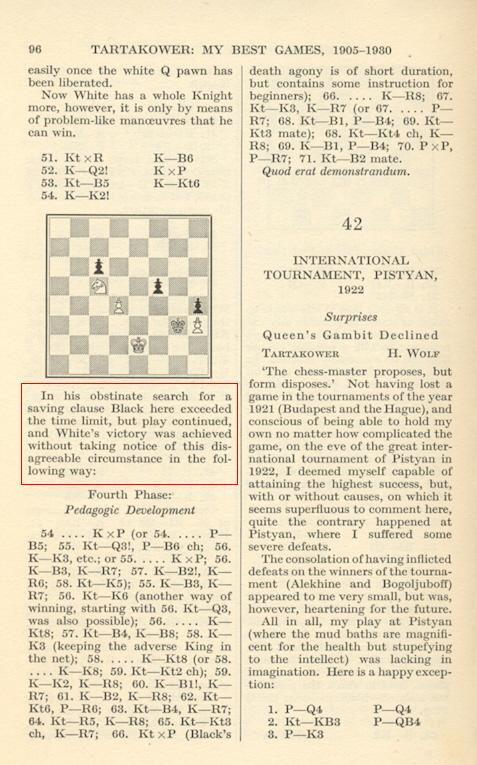
However, one complication still needs to be considered. There exists a German translation, by Rudolf Teschner, of Tartakower’s book, under the title Tartakowers Glanzpartien, 1905-1930. Since it specifically billed itself as a translation from the French original, it would hardly be expected to follow the Golombek version rather than what appeared in Tartacover vous parle, yet it did exactly that:

We have found no contemporary (1921) source which suggests that the game continued to 71 Nf2 mate. On page 461 of the December 1921 BCM Sir George Thomas wrote after 53...Kg3, ‘At this stage, Black lost by over-stepping his time-limit. The game could not be saved in any case. A likely continuation would be 54 Ke2 ...’, after which he gave some 20 lines of analysis. See also page 25 of the tournament book by B. Kagan, page 215 of Schachjahrbuch 1921 by L. Bachmann (Ansbach, 1923), page 43 of 500 Master Games of Chess by S. Tartakower and J. du Mont (London, 1952), page 9 of the tournament book by A. Becker and page 19 of Akiba Rubinstein: The Later Years by J. Donaldson and N. Minev (Seattle, 1995).
(4437)
Christophe Bouton (Paris) reverts to the question of the second volume of Tartakower’s Best Games, of which an English translation by Harry Golombek was published by G. Bell in 1956. Given that no French edition has ever appeared, our correspondent asks if any information is available as to the whereabouts of Tartakower’s manuscript (e.g. in the archives of Golombek or of Bell).
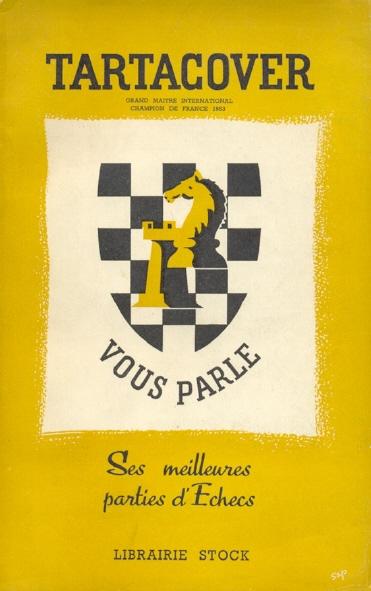
The front cover of the original (1953) edition of Tartakower’s book on the period 1905-1930.
(4768)
A photograph taken at Łódź, 1935:
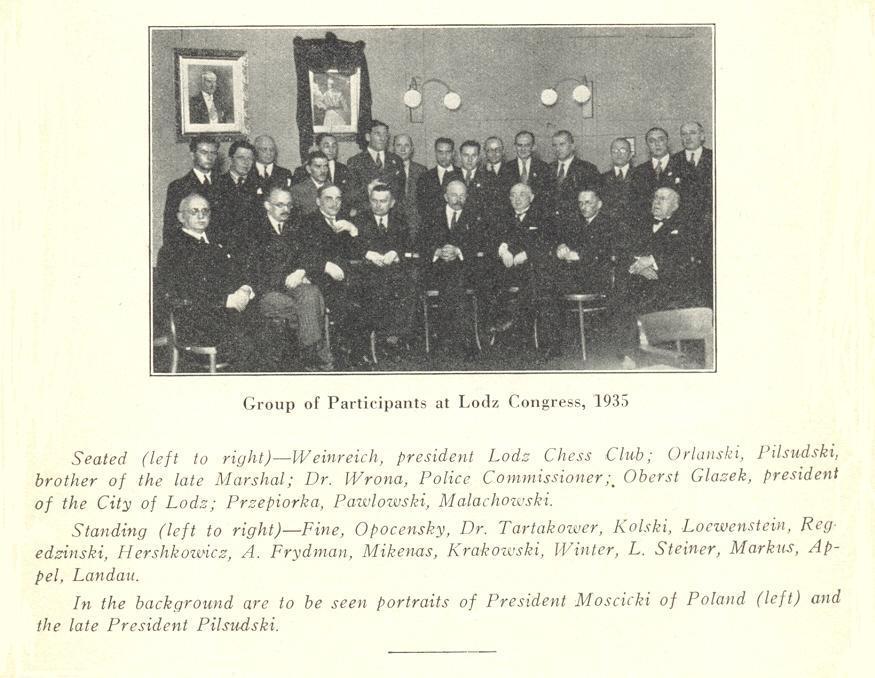
Source: American Chess Bulletin, September-October 1935, page 131.
(4734)
From Nathan Bauman (Seoul, South Korea):
‘Regarding the first chess computer, a king and rook versus king problem-solving machine invented by Leonardo Torres y Quevedo (1852-1936), I would draw your attention to a recent article I have written, “A New Photograph of ‘El jugador ajedrecista’, the World’s First Chess Computer”.
I wonder whether any other pictures or clips can be found. There is very little visual material available on the Internet, and what does exist seems to have been conflated with a machine invented by Torres y Quevedo some years later.’
Any references that readers can provide will be appreciated. In the meantime, we note that some illustrations of Torres’ invention (a photograph and four diagrams) appeared on pages 227-229 of that much-neglected book Chess: Man vs Machine by B. Ewart (London, 1980).
Although Ewart noted that Torres’ machine (‘the first purely mechanical chess player’) was introduced to the public at the Sorbonne in Paris in November 1915, a number of chess computer books give the date of its invention as 1890. See, for example, page 11 of Computer Chess by L. Pachman and V.I. Kühnmund (London, 1986) and page 20 of I giocatori artificiali by P. Ciancarini (Mursia, 1992).
Concerning the subsequent generation (in terms of both computers and the Torres family), below is an item from page 94 of the February 1951 CHESS:
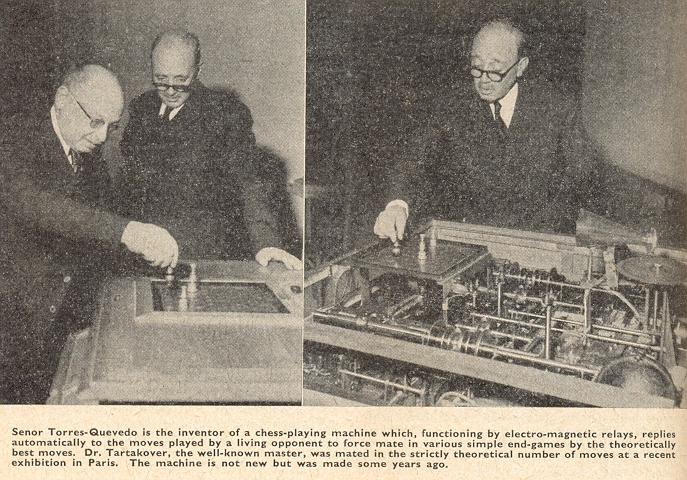
(4470)
David Lovejoy asks whether anything is known about the final disposal of Tartakower’s papers and effects after his death in Paris in 1956.
(4636)
From Dominique Thimognier (St Cyr sur Loire, France):
‘I have examined the last French magazine to which Tartakower contributed, L’Echiquier de France. His death was announced on page 46 of the February 1956 issue, with a brief report on his funeral. The March 1956 number (page 51) had a more detailed article on his career, by Gabriel Authier, the magazine’s managing director. I merely note that Tartakower had no family and that he was living at the Hôtel Mazagran in Paris. L’Echiquier de France continued to publish articles by Tartakower posthumously, but there is nothing to suggest that anyone from the magazine took possession of the master’s papers.’
(4674)
Many ‘chess quotes’ of the masters are unsubstantiated and unsubstantiatable, but at least the game’s lore contains few instances of alleged last words. Buckle’s purported cry about being unable to finish his book is well known, but are there other cases? Page 60 of Mille et une anecdotes by Claude Scheidegger (Tirana, 1994) claimed to know what Tartakower said on his death-bed (a quip, of course), but, in keeping with the rest of the book, no corroboration was offered.
(4704)
There were tandem displays of simultaneous chess by Tartakower and Znosko-Borovsky, as shown by the photograph below from page 287 of Alt om Skak by B. Nielsen (Odense, 1943):

(4783)
A comment by B.H. Wood on page 19 of CHESS, November 1944:
‘Najdorf is a born chess genius and, with a little of the self-discipline which he so strikingly lacks, capable of winning any world championship. At lightning chess he scintillates; we once saw him beat Tartakower (who is quite a doughty exponent of this game himself) 14 times in succession at “five-minute” play. This could not be a normal result, but it illustrates the extraordinary swing of his temperament.’
(4802)
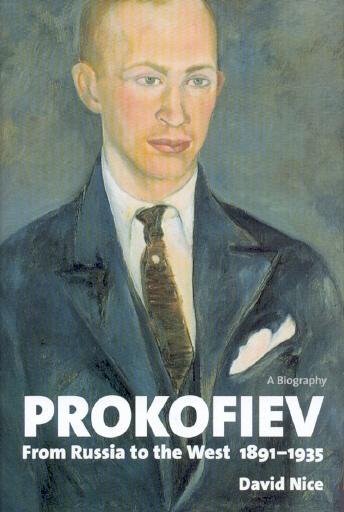
Chess also features extensively in Prokofiev From Russia to the West 1891-1935 by David Nice (New Haven and London, 2003). The plates section has a photograph of Prokofiev ‘playing chess with former neighbour Morolev at Nikopol, 1909’. From page 292 (concerning the early 1930s):
‘There was a good chess companion in Mischa Elman, though it would have been better still to have had the company of Capablanca, whose participation in the Paris congress he had been following with interest – “congratulations for the games you won, but you’re too lazy and you must win more.” [Page 354 states that this comes from a letter from Prokofiev to Capablanca dated 26 July 1931.] Capablanca duly obliged by losing not a single match.’
For ‘Paris congress’ read, presumably, ‘match with Euwe in the Netherlands’, although that contest had ended on 10 July 1931.
Pages 311-312 of the biography have the following information regarding Prokofiev in 1933:
‘As for chess, which he was still enjoying regularly at Napoleon’s old haunt of the Café de la Régence, he played two games with the famous Saviely Tartakower, winning the first and drawing the second. There seemed no reason why he should not exploit his triumph for publicity purposes in America. “Tartakower is one of the strongest players in the world”, he told Gottlieb in an extended version of the news he had already passed on to Haensel, “and has the title of ‘Grossmeister’ – so you can imagine how proud I was to win. When, after the game was over, I asked Tartakower to show me what mistake he made to lose it, he answered: ‘I made no mistake; simply you played well’.”’
We add that Tartakower annotated the finish on pages 426-427 of L’Echiquier, 17 February 1934:
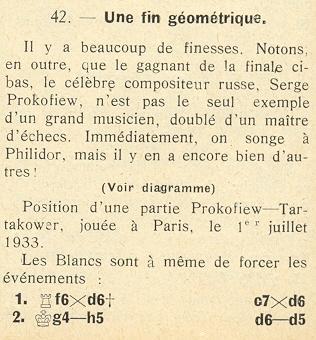
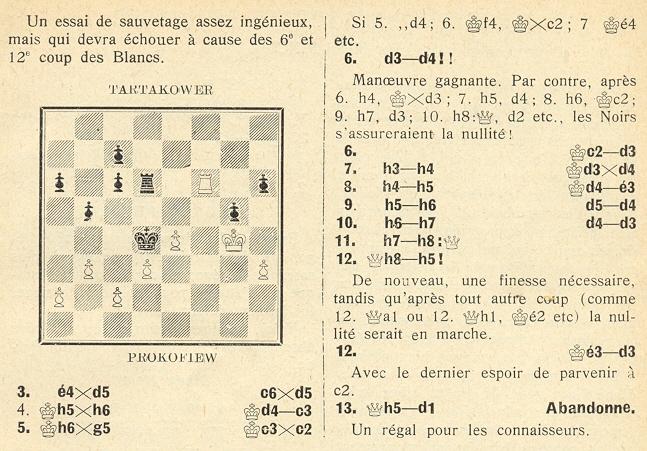
It may be recalled that Tartakower included a victory over Prokofiev (Paris, February 1934) on pages 46-47 of his second volume of Best Games.
(4928)
See too Sergei Prokofiev and Chess.
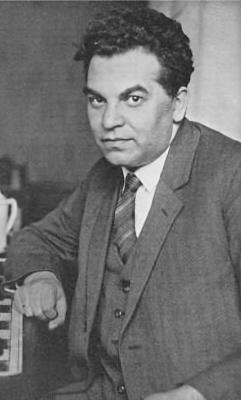
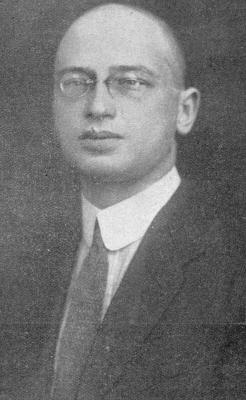
Richard Réti and Savielly Tartakower
David Lovejoy mentions a claim by Tartakower that Réti tricked him out of an engagement for a simultaneous display in South America, as reported by Harry Golombek (in 14 lines) on pages 67-68 of Chess Treasury of the Air by T. Tiller (Harmondsworth, 1966). Our correspondent asks when exactly Tartakower and Réti were both in South America.
(4983)
From page 23 of The Bright Side of Chess by Irving Chernev (Philadelphia, 1948):
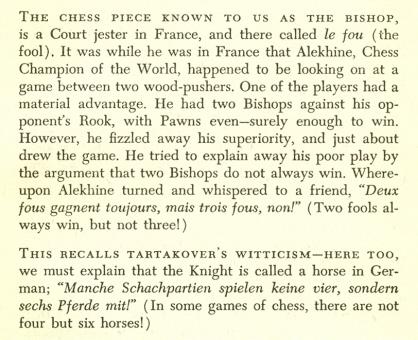
Earlier sources for these quips are sought. Regarding the Alekhine one, the following appeared on page 49 of CHESS, January 1942:
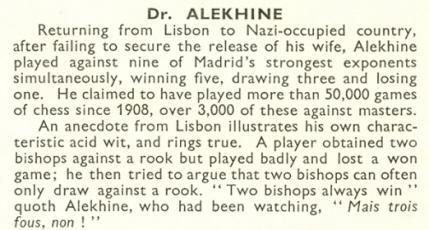
(5044)
The full alleged sentence in French appeared on page 91 of Chess World, 1 May 1946:
‘In French the piece we call the bishop is called “le fou” (the fool).
A Lisbon player who had just lost a game was explaining volubly how he should have won because he had the bishops. Alekhine was looking on. He said:
“Deux fous gagnent toujours – mais trois fous, non.”
(Two fools always win, but not three.)’
(10152)
Further to G.H. Diggle’s reference to Savielly Tartakower in C.N. 4331, Hassan Roger Sadeghi asks if more information is available about Tartakower’s service in the Fighting French Forces during the Second World War under the pseudonym ‘Cartier’.
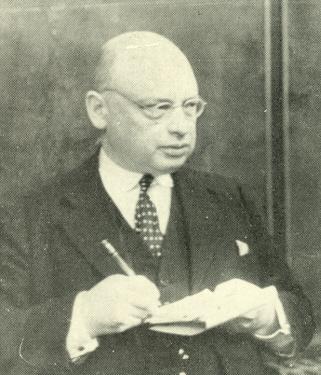
Savielly Tartakower
We offer some notes, beginning with a paragraph by Harry Golombek on page iii of his Translator’s Foreword to the second volume of Tartakower’s Best Games:
Coming through the war unscathed, he resumed his chess activities with undiminished vigour.’
In that source, as well as on page 67 of Chess Treasury of the Air by Terence Tiller (Harmondsworth, 1966), Golombek related his wartime meeting with Tartakower in England. The following appeared in the Tiller book:
The chess match was played at the Borough Club, Nottingham on 15 November 1941, as reported on pages 305-306 of the December 1941 BCM, and the score of the game between ‘2nd/Lt. G. Cartier’ and ‘Bdr H. Golombek’ was supplied. The BCM wrote:
Below is the complete page 306:
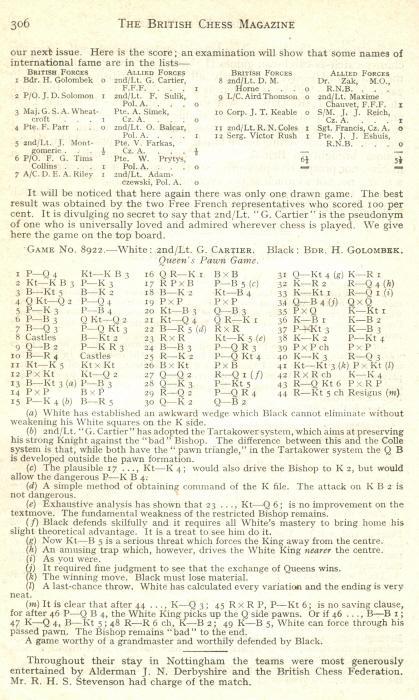
In all, the BCM published about a dozen games by Lieutenant Cartier during the War. The match described by G.H. Diggle took place in London on 22 April 1944 and was reported on pages 107-109 of the May 1944 BCM. His opponent was G. Wood. The pseudonym ‘Cartier’ was no secret; for instance, page 268 of the December 1942 BCM referred to ‘Lt. G. Cartier of the Fighting French, better known in the chess world as Dr Tartakower, the great international’.
We still seek substantiation of the claim that Tartakower was several times ‘dropped by parachute behind enemy lines on secret missions’ (see page 331 of Kings, Commoners and Knaves). More generally, what else is known about Tartakower’s activities during the Second World War?
(5140)
From page 2 of Staunton Centenary Tournament 1951 by H. Golombek (published in London later that year):
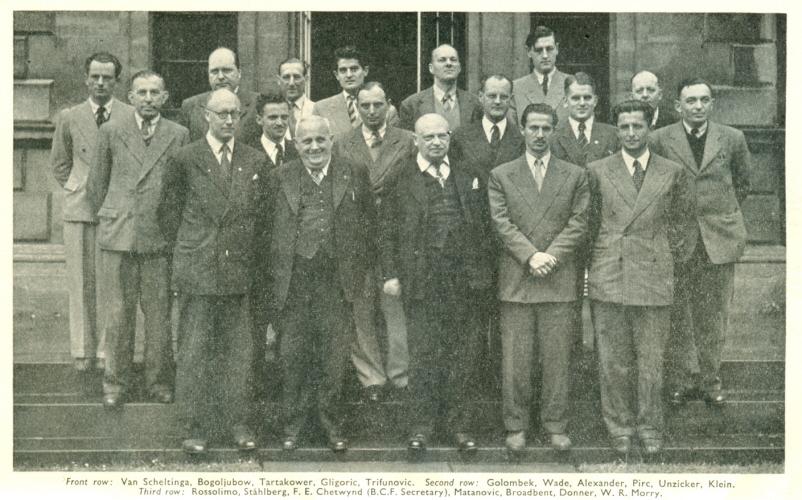
(5202)
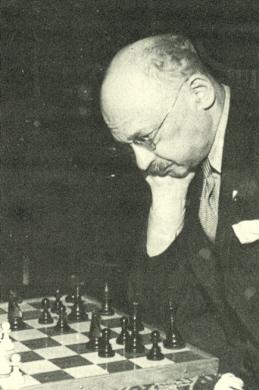
Savielly Tartakower
Below are all the games played by Tartakower under the pseudonym ‘G. Cartier’ that we have found in the BCM during the Second World War.
G. Cartier (Savielly Tartakower) – Harry Golombek1 d4 Nf6 2 Nf3 e6 3 Bg5 Be7 4 Nbd2 d5 5 e3 c5 6 c3 Nbd7 7 Bd3 b6 8 O-O Bb7 9 Qc2 h6 10 Bh4 O-O 11 Ne5 Nxe5 12 dxe5 Nd7 13 Bg3 f6 14 exf6 Bxf6 15 e4 Bh4 16 Rae1 Bxg3 17 hxg3 c4 18 Be2 Nc5 19 exd5 exd5 20 Nf3 Qf6 21 Nd4 Rae8 22 Bh5 Rxe1 23 Rxe1 Ne4 24 Bf3 a6 25 Re2 b5 26 Bxe4 dxe4 27 Qd2 Rd8 28 Qe3 b4 29 Rd2 a5 30 Qe2 Qf7 31 Qg4 Kh8 32 Kh2 Rd5 33 Kg1 Rd8 34 Qf4 Qxf4 35 gxf4 Kg8 36 Kf1 Kf7 37 g3 Kf6 38 Ke2 g5 39 fxg5+ hxg5 40 Ke3 Rd6
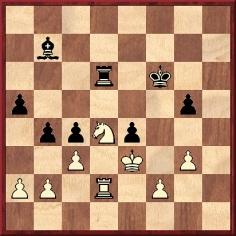
41 Nb3 cxb3 42 Rxd6+ Ke5 43 Rb6 bxa2 44 Rb5+ Resigns.
(Source: BCM, December 1941, page 306.) See C.N. 5140 for the magazine’s annotations.
The next game was played during a visit by Tartakower to ‘part of the Royal Netherland Brigade’.
Zak – G. Cartier (Savielly Tartakower)1 e4 Nf6 2 Nc3 e5 3 Bc4 d6 4 Nf3 Be7 5 d3 c6 6 a4 O-O 7 O-O Bg4 8 Bg5 h6 9 Bxf6 Bxf6 10 h3 Bd7 11 Nh2 Kh7 12 Qf3 Be6 13 Ng4 Bg5 14 Ne3 Nd7 15 Ne2 g6 16 g4 Qe7 17 Ng3 Nc5 18 Qe2 Bd7 19 b4 Ne6 20 Bxe6 Bxe6 21 c4 Rad8 22 Ng2 d5 23 c5 dxe4 24 Nxe4 Rd4 25 b5 Bd5
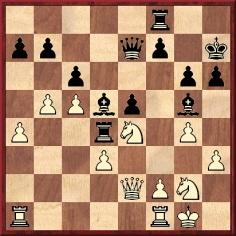
26 Nd6 b6 27 bxc6 bxc5 28 Nc4 Bxc6 29 Qxe5 Rxd3 30 Qxe7 Bxe7 31 Ne5 Bxg2 32 Kxg2 Rd5 33 Nc6 Bf6 34 Rad1 Bd4 35 Nxa7 f5 36 f3 Re8 37 Rfe1 Rde5 38 Rxe5 Rxe5 39 Rd2 Re1 40 Nc6 Bf6 41 a5 Ra1 42 Rd7+ Kg8 43 Ra7 Ra2+ 44 Kg3 c4 45 a6 c3 46 Nb4 f4+ 47 Kxf4 Ra4 and wins.
(Source: BCM, October 1942, pages 240-241.) There was a correction to the score from Tartakower on page 253 of the November 1942 issue, to the effect that the game in fact went ‘37...RxR 38 RxR B-B3’, but it is unclear to us how those moves fit into the game.
On the same visit the following game was played:
G. Cartier (Savielly Tartakower) – Zak and Traudmann1 e4 e5 2 Nc3 Nf6 3 Bc4 Nxe4 4 Qh5 Nd6 5 Bb3 Nc6 6 Nf3 g6 7 Qh3 e4 8 Ng1 Bg7 9 Nge2 O-O 10 O-O Ne8 11 Qe3 Nf6 12 Nxe4 d6 13 d4 Nxe4 14 Qxe4 Bf5 15 Qe3 Qd7 16 c3 Rae8 17 Qd2 Na5 18 Ng3 d5 19 Nxf5 Qxf5 20 Bc2 Qd7 21 b3 Re6 22 Bd3 Nc6 23 Kh1 Rfe8 24 f4 f5
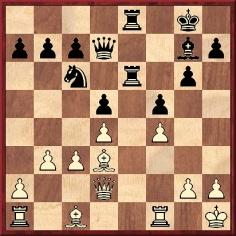
25 g4 fxg4 26 f5 Rf6 27 Qg5 Qf7 28 Ba3 Ne7 29 fxg6 Nxg6 30 Rxf6 Qxf6 31 Qxd5+ Kh8 32 Rf1 c6 33 Qh5 Qe6 34 Bc1 Rf8 35 Rxf8+ Bxf8 36 Kg2 Bd6 37 c4 Bf4 38 Bb2 Qe3 39 d5+ Kg8 40 Qxg4 Qxd3 41 Qe6+ Kf8 42 Qc8+ Ke7 43 Qxb7+ Ke8 44 Qc8+ Ke7 45 Qe6+ Kf8 46 Qf6+ Ke8 47 Qxc6+ Kf7 48 Qe6+ Kf8 49 Qf6+ Ke8 50 Qc6+ Kf7 Drawn.
(Source: BCM, October 1942, page 241.)
Julius du Mont and Zak – G. Cartier (Savielly Tartakower) and M. Chauvet1 e4 e5 2 Nc3 Nf6 3 Bc4 Nxe4 4 Qh5 Nd6 5 Bb3 Be7 6 d3 Nc6 7 Nge2 g6 8 Qf3 O-O 9 Bh6 Re8 10 Ne4 Nf5 11 Bxf7+ Kxf7 12 g4 d5 13 gxf5 Bxf5 14 O-O–O Kg8 15 Rhg1 Qd7 16 h4 Bxh4 17 Qh5 Be7 18 Rg2 Kh8
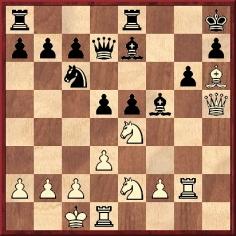
19 Ng5 Bxg5+ 20 Bxg5 Qf7 21 Qh4 Re6 22 Rh1 Rg8 23 Nc3 Ne7 24 Nb5 Nc8 25 Nxc7 Qxc7 26 Bf6+ Rxf6 27 Qxf6+ Qg7
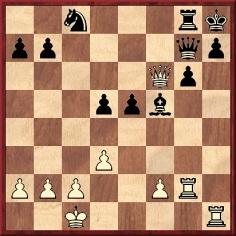
28 Rgh2 h5 29 Qxf5 Qh6+ 30 f4 gxf5 31 Rxh5 Qxh5 32 Rxh5+ Kg7 and wins.
(Source: BCM, December 1942, page 268.) There can be few games in which the loser made so many queen offers.
John Montgomerie – G. Cartier (Savielly Tartakower)1 d4 f5 2 g3 e6 3 Bg2 Nf6 4 Nd2 c5 5 c3 Nc6 6 e3 Be7 7 Ne2 O-O 8 O-O Qe8 9 e4 cxd4 10 cxd4 d5 11 exf5 exf5 12 Nf4 Qf7 13 Nf3 Ne4 14 Nd3 Bf6 15 Nde5 (Incorrectly given as ‘15 QKt-K5’.) 15...Qe7 16 Qb3 Rd8 17 Nxc6 bxc6 18 Bf4
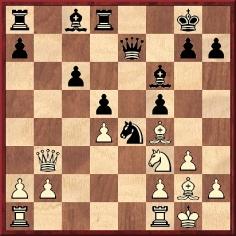
18...g5 19 Be3 g4 20 Ne1 Ba6 21 Nd3 Rab8 22 Qc2 Bxd3 23 Qxd3 Rxb2 24 f3 Nd6 25 fxg4 fxg4 26 Rae1 Qg7 27 Bc1 Bxd4+ 28 Kh1 Rf2 29 Rxf2 Bxf2 30 Rf1 Bb6 31 Rf4 Rf8 32 Rxf8+ Qxf8 33 Bf4 Qf5 34 Qe2 Ne4 35 White resigns.
(Source: BCM, December 1942, page 269.)
The next contest was described as ‘the second game from a private match’.
G. Cartier (Savielly Tartakower) – Zak1 d4 Nf6 2 Nf3 g6 3 g3 Bg7 4 Bg2 d5 5 c4 c6 6 O-O O-O 7 Nc3 Nbd7 8 cxd5 cxd5 9 Ne5 e6 10 f4 Nxe5 11 fxe5 Ne8 12 e4 dxe4 13 Nxe4 f5 14 exf6 Bxf6 15 Nxf6+ Rxf6 16 Rxf6 Qxf6 17 Bf4 Qe7 18 Qd2 Nd6 19 Re1 Nc4 20 Qc3 Nb6
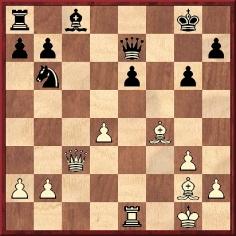
21 d5 Qf7 22 Bh6 e5 23 Rf1 Bf5 24 Qxe5 Re8 25 Qd4 Qd7 26 Qf6 Nc4 27 d6 Qf7 28 Bd5 Resigns.
(Source: BCM, March 1943, page 64.)
G. Cartier (Savielly Tartakower) – W.G. Sugden1 e4 Nf6 2 e5 Nd5 3 c4 Nb6 4 d4 d5 5 c5 N6d7 6 e6 fxe6 7 Bd3 Nf6 8 Nf3 g6 9 h4 Bg7 10 Ne5 Nbd7 11 Nf3 O-O 12 Ng5 Nb8 13 h5 Ne4 14 Nxh7 Nxf2
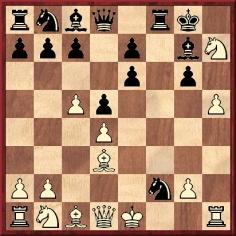
15 Nxf8 Nxd1 16 Nxg6 Bxd4 17 Kxd1 Nd7 18 h6 Nf6 19 Nc3 Bd7 20 Bg5 Kf7 21 h7 Kg7 22 h8(Q)+ Qxh8 23 Rxh8 Rxh8 24 Nxh8 Kxh8 25 Kd2 ‘and Black is a rook down’.
(Source: BCM, August 1943, page 173.)
G. Cartier (Savielly Tartakower) – Cunningham1 e4 e5 2 f4 exf4 3 Nf3 Be7 4 Bc4 Bh4+ 5 g3 fxg3 6 O-O gxh2+ 7 Kh1 Be7 8 Bxf7+ Kxf7 9 Ne5+ Ke8 10 Qh5+ g6 11 Nxg6 Nf6 12 Rxf6 Bxf6 13 Ne5+ Ke7 14 Qf7+ Kd6 15 Nc4+ Kc5 16 Qd5+ Kb4 17 a3+ Ka4 18 b3 mate.
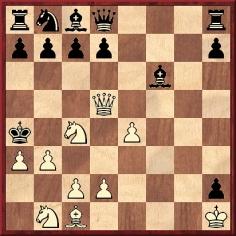
(Source: BCM, August 1943, page 174.)
G. Cartier (Savielly Tartakower) and P.H. Hazzard – J.C. Waterman and R.G. Gray1 e4 e5 2 Nf3 Nc6 3 Bc4 Nf6 4 Ng5 d5 5 exd5 Na5 6 d3 h6 7 Nf3 e4 8 Qe2 Nxc4 9 dxc4 Bc5 10 Nfd2 O-O 11 Nb3 Bg4 12 Qf1 Bd6 13 h3 Bh5 14 g4 Bg6 15 Be3 Re8 16 Nc3 Bb4 17 O-O–O Bxc3 18 bxc3 a5 19 Qe2 Nd7 20 h4 Ne5 21 Nd2 Qd6 22 Kb2 a4 23 Ka1 Qa6 24 Rhg1 Qa5 25 Bd4 Nf3 26 Nxf3 exf3 27 Qxf3 Bxc2
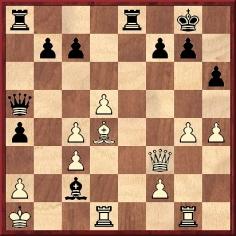
28 g5 Bxd1 29 Qxd1 Ra6 30 gxh6 Rg6 31 h5 Rxh6 32 Bxg7 Resigns.
(Source: BCM, May 1944, pages 102-105.)
G. Cartier (Savielly Tartakower) – Maurice Ellinger1 e4 c6 2 Nc3 d5 3 Nf3 dxe4 4 Nxe4 Bf5 5 Ng3 Bg6 6 h4 h6 7 Ne5 Bh7 8 Qh5 g6 9 Qf3 Qd5
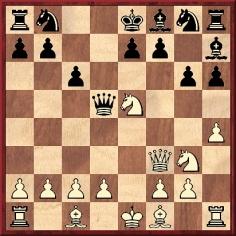
10 Qxd5 cxd5 11 Bb5+ Nc6 12 Nxc6 a6 13 Ba4 Resigns.
(Source: BCM, July 1944, page 155.)
T.J. Beach – G. Cartier (Savielly Tartakower)1 e4 c5 2 Nf3 Nf6 3 Nc3 d6 4 d4 cxd4 5 Nxd4 g6 6 f3 Bg7 7 Be3 O-O 8 Qd2 Nc6 9 O-O–O Bd7 10 g4 Rc8 11 Kb1 Ne5 12 h4 Nc4 13 Bxc4 Rxc4 14 h5
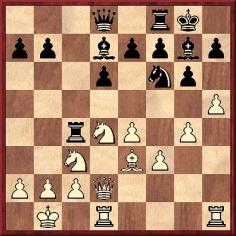
14...b5 15 hxg6 fxg6 16 Ndxb5 Bxb5 17 Nxb5 Qb8 18 Nd4 Rfc8 19 Rc1 d5 20 e5 Qxe5 21 c3 Qd6 22 g5 Nh5 23 f4 a5 24 f5 Bxd4 25 Bxd4 Ng3 26 fxg6 Qxg6+ 27 Ka1 Nxh1 28 Rxh1 R4c6 29 Qh2 Re6 30 a3 Rf8 31 Qg2 Qe4 32 Qh3 Rf3 33 Qh5 Qd3 34 White resigns.
(Source: BCM, March 1945, page 59.)
The final game is from a 27-board simultaneous exhibition:
G. Cartier (Savielly Tartakower) – J.T. Keable1 e4 Nc6 2 d4 d5 3 Nc3 e6 4 Nf3 Bb4 5 e5 Nge7 6 Bd3 Nf5 7 Bxf5 exf5 8 Qd3 Be6 9 O-O O-O 10 Ne2 Be7 11 c3 Nb8 12 Nf4 Nd7 13 Kh1 c5 14 Be3 c4 15 Qd2 Kh8 16 b3 Nb6 17 Nxe6 fxe6 18 Bg5
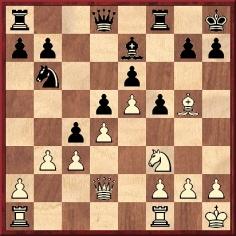
18...a5 19 Bxe7 Qxe7 20 Ng5 cxb3 21 axb3 a4 22 bxa4 Rxa4 23 Rxa4 Nxa4 24 f4 h6 25 Nf3 Rc8 26 Ra1 Nxc3 27 g3 Ne4 28 Qb2 Qf7 29 Ra7 Qh5 30 Kg2 Rc3 31 White resigns.
(Source: BCM, June 1945, page 139.)
(5210)
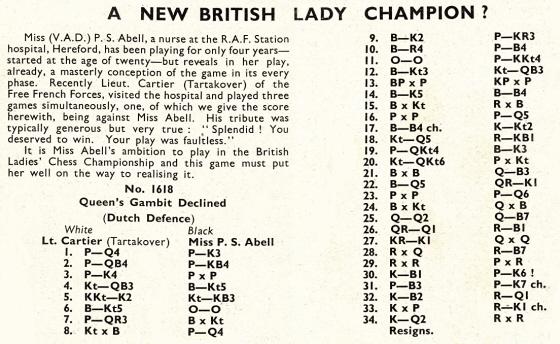
Source: CHESS, September 1943, page 185.
1 d4 e6 2 c4 f5 3 e4 fxe4 4 Nc3 Bb4 5 Nge2 Nf6 6 Bg5 O-O 7 a3 Bxc3+ 8 Nxc3 d5 9 Be2 h6 10 Bh4 c5 11 O-O g5 12 Bg3 Nc6 13 cxd5 exd5 14 Be5 Bf5 15 Bxf6 Rxf6 16 dxc5 d4 17 Bc4+ Kg7 18 Nd5 Rf8 19 b4 Be6 20 Nb6 axb6 21 Bxe6 Qf6 22 Bd5 Rae8 23 cxb6 d3 24 Bxc6 Qxc6 25 Qd2
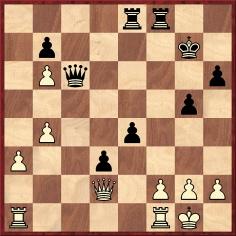
25...Qc2 26 Rad1 Rc8 27 Rfe1 Qxd2 28 Rxd2 Rc2 29 Rxc2 dxc2 30 Kf1 e3 31 f3 e2+ 32 Kf2 Rd8 33 Kxe2 Re8+ 34 Kd2 Rxe1 35 White resigns.
(7539)

Hassan Roger Sadeghi sends this photograph, taken on 7 October 2007, of the Hôtel Mazagran in Paris. As noted in our feature article Where Did They Live?, Tartakower was a resident there already in the 1920s, and it was also his address at the end of his life.
Below we add a letter written by Tartakower to John C. Owen (who sent us a copy many years ago) from Paris on 28 January 1956, i.e. about a week before the master died. He provided information about the strongest chess club in Paris and mentioned that his second Best Games volume would be appearing in the first half of 1956.
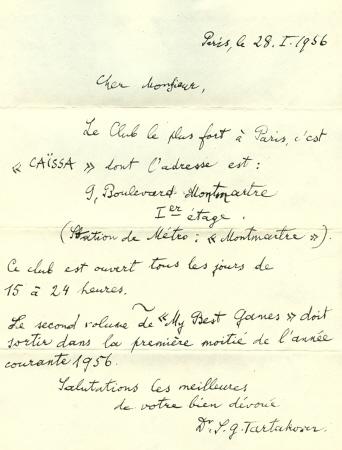
(5211)
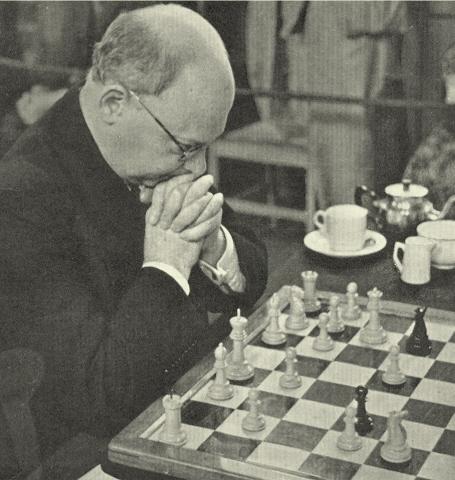
Savielly Tartakower
From Leonard Barden (London):
‘Tartakower played me in his Free French uniform and, a decade later, we met in the Cercle Caïssa in Montmartre.
The first occasion was in early 1945 when I visited Julius du Mont’s house and found the doctor there discussing 500 Master Games of Chess. I was already helping du Mont with checking proofs for the BCM and his columns and books, so he gave me some work while they finished their talk and then persuaded Tartakower to play me. He was the first world-class grandmaster I ever met, an imposing figure in the uniform. There were no clocks. He was Black in a Dutch Defence. He sortied his queen to a5, then blocked its retreat, allowing me to trap it in elementary fashion by b4. He resigned promptly, and suggested a second game. I had been reading My System so tried the Nimzowitsch Sicilian with an early d5, but was swiftly outplayed. I did not take a game-score.
In July 1955 I visited Paris, was told of the Caïssa café so went to the Boulevard Montmartre hoping to play for stakes and help finance my trip. There were around a dozen to 20 patrons each afternoon, presided over by a charming elderly lady, Madame Le Bey Taillis. My hopes of unsuspecting victims were soon dashed as Madame found out that I was British champion and introduced me gushingly as such to prospective opponents. So most days I ended up playing five-minute games with the café professional Sherbakov, who competed in one or two minor international tournaments of the time. We were evenly matched, and after several hours there were only a few centimes in it.
Tartakower used to visit daily and play almost exclusively with an old gentleman to whom he gave odds (I forget whether a knight or substantial time-odds). The amateur was accommodating, lost virtually every game, and paid up after two or three hours. One afternoon the doctor was late and the old gentleman was en prise, so I took the opportunity to become his opponent and to collect from him. After an hour or so Tartakower arrived and looked aghast at what was probably his rent and roulette money being usurped. He sat down on the same side of the table as the amateur and fixed me with a cold stare. I soon took the hint and gave way.
We left the café together later that evening and it seemed that Tartakower had not fully forgiven me. He was too polite to reproach me directly, but began a gentle probe. My French was poor, but he rarely uttered English words. “You have been an undergraduate. What did you study?” “History, doctor.” “Ah good, can you help me with a historical question?” “I’ll try.” “In what year was the Battle of Hastings?” “1066.” “Bravo, felicitations!” It was well-known that the doctor liked to use this last phrase sarcastically to people he thought had overstepped the mark. We said our farewells, I left for London the next day, and seven months later wrote a sympathetic obituary for the Guardian.’
(5226)
Jan Kalendovský (Brno, Czech Republic) submits a caricature of Tartakower [and one of Tarrasch], from Schach Karikaturen aus der internationalen Schachwelt by E. Gőndőr (Vienna, 1922):
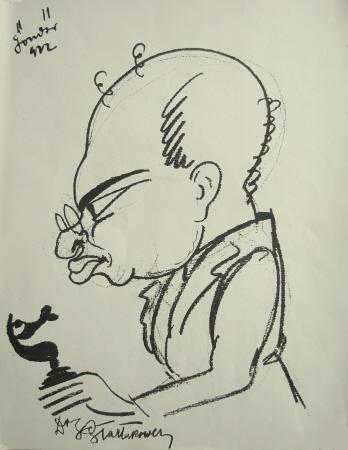
(5247)
David Lovejoy notes that chess sources are inconsistent as to the publication date of Tartakower’s Die Hypermoderne Schachpartie and asks for clarification of the correct year.
The usual options (1924, 1924-25 and 1925) all seem valid, although we now tend to regard 1924 as the best choice. There were two editions of the book, dated 1924 and 1925:
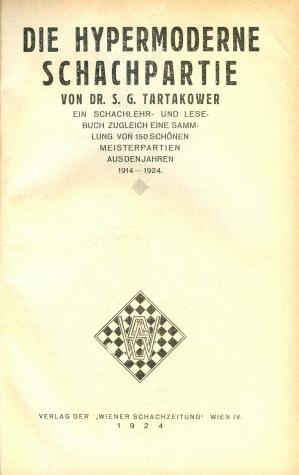
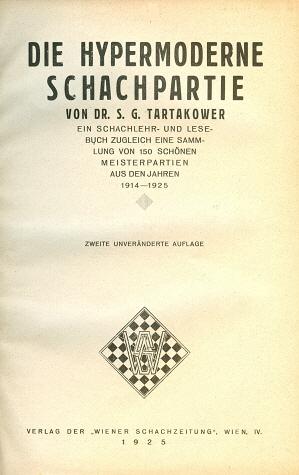
The latter (‘zweite unveränderte Auflage’ – the second unaltered edition) was reproduced by Edition Olms, Zurich in 1981.
In addition, our collection contains instalments 1-6 of the book (pages 1-384), all of which are dated 1924.
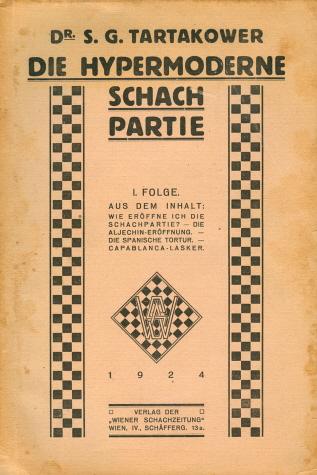
(5279)
This Nice, 1930 group photograph was published on page 68 of the April 1930 American Chess Bulletin:
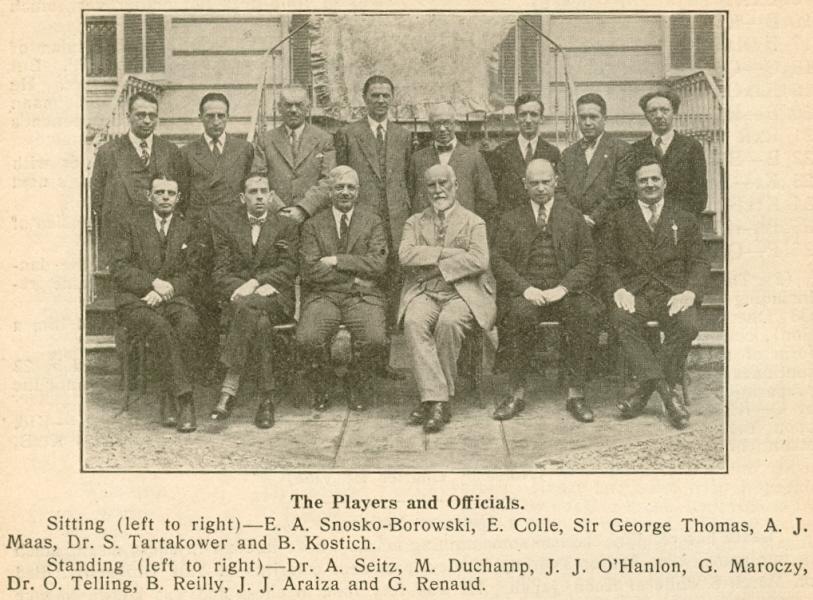
(5319)
As reported on page 331 of Kings, Commoners and Knaves, it was claimed on page 100 of The Sorcerer’s Apprentice by D. Bronstein and T. Fürstenberg (London, 1995) that during the Second World War Tartakower was several times ‘dropped by parachute behind enemy lines on secret missions’.
No evidence for the assertion has ever been traced, and now we note the following passage on page 278 of Moral Victories by David Lovejoy (Mullumbimby, 2008):
‘Bronstein subsequently told me that his source was a French journalist who talked to him many years earlier. Bronstein was inclined to doubt the story, but his editor insisted on including it for colour. (Telephone conversation with Bronstein, March 2006.)’
This appears in the book’s factual End Notes. Subtitled, ‘The Story of Savielly Tartakower’, Moral Victories is an historical novel (a 285-page paperback).

(5519)
Page 159 of The Chess Scene by D. Levy and S. Reuben (London, 1974) ascribed to Tartakower the remark, ‘Matches prove less than tournaments; and tournaments don’t really prove anything either.’
What more is known about the origins of this observation (or its converse)?
(5792)
The only progress to report is that the identical wording appeared in a set of eight alleged Tartakowerisms on page 178 of CHESS, 25 February 1956. Since the magazine furnished sources for none of them, the progress is minuscule.
(8152)
From page 22 of Relax with Chess by Fred Reinfeld (New York, 1948):
‘It was that exuberant phrase-maker and paradox-monger Dr Tartakower who once remarked that a pawn sacrifice requires more skill than does a queen sacrifice. The reason? Sacrificing the queen calls for exact calculation of a quick finish. The pawn sacrifice, on the other hand, involves an intuitive flair possessed as a rule only by the great masters.’
Where did Tartakower make such a remark?
(6104)
See also C.N. 9859 below.
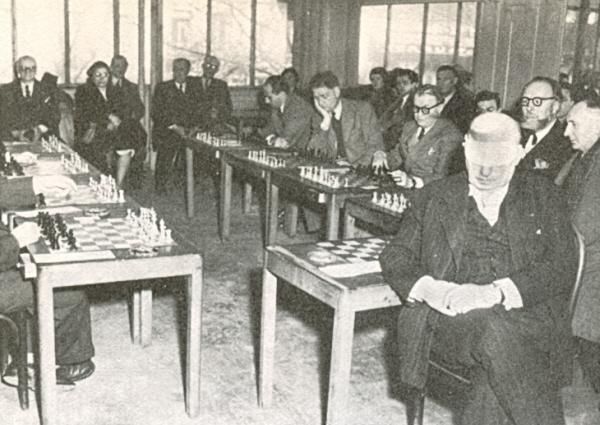
This photograph comes from page 92 of Objectif mat! by R. Bertolo and L. Risacher (Paris, 1978). Is any information available about the occasion?
(6562)
Olimpiu G. Urcan (Singapore) has forwarded the following from page 408 of the Illustrated London News, 14 March 1953:
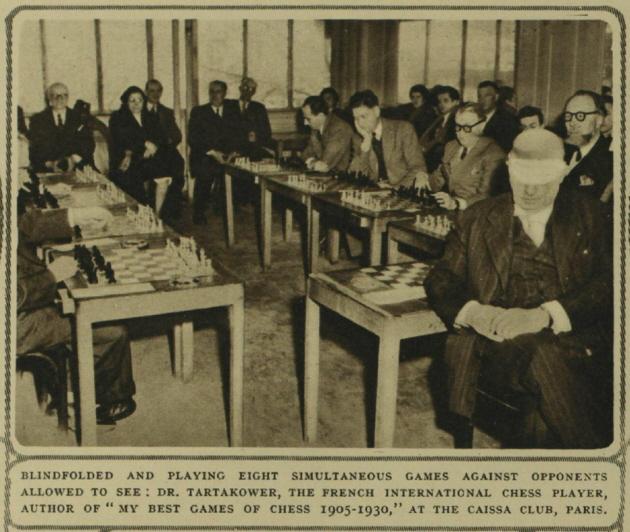
(7503)
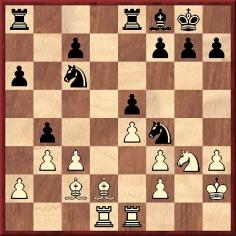
This position occurred after 21 Rfe1 in Tartakower v Réti, New York, 1924. Black played a rook to d8, but which rook?
The question has been put to us by Charles Sullivan (Davis, CA, USA), who comments that although various sources, including databases, give the next move as 21...Rad8, The Book of the New York International Chess Tournament 1924 by A. Alekhine (New York and London, 1925) put ‘KR-Q’ on page 191 and appended this note on the next page:
‘The queen’s rook stays at its own square in order eventually to make a demonstration on the queen’s side (P-QR4).’
We note, though, that page 267 of the German edition of Alekhine’s tournament book (Berlin and Leipzig, 1925) stated that the move played was 21...Rad8. Alekhine wrote that moving the king’s rook to d8 would have been an improvement:
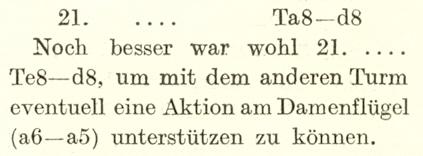
Tartakower annotated the game, which he lost, on pages 220-222 of the August 1924 Wiener Schachzeitung. 21...Rad8 was the move given, with an exclamation mark. It may therefore be strongly suspected that 21...Red8 in the English edition of the New York, 1924 book was wrong, possibly owing to a misunderstanding and/or translation error, but the matter has yet to be put beyond doubt.
Notwithstanding the quality of Alekhine’s annotations, the book was a lax production. C.N. 2131 (see page 283 of Kings, Commoners and Knaves) mentioned that W.H. Watts added a nine-page errata supplement (to the British edition, of which he was the publisher). The list sheds no light on the ‘Which rook?’ puzzle but is, of course, indispensable in connection with any English-language edition of Alekhine’s book.
(5954)

Position after 21 Rfe1
Concerning Tartakower v Réti, New York, 1924, David DeLucia (Darien, CT, USA) informs us that he owns Réti’s score-sheet, which clearly indicates that 21...Rad8 was played. Since that was also the move given by Tartakower (as shown in C.N. 5954), it seems evident that the English-language edition of the tournament book by Alekhine was wrong.
Regarding the nine-page errata supplement issued by W.H. Watts in 1925, see C.N.s 5954 and 5955.
(6009)
Taken at Debrecen, 1925, this photograph was published in Tartakower’s Das entfesselte Schach (Kecskemét, 1926):
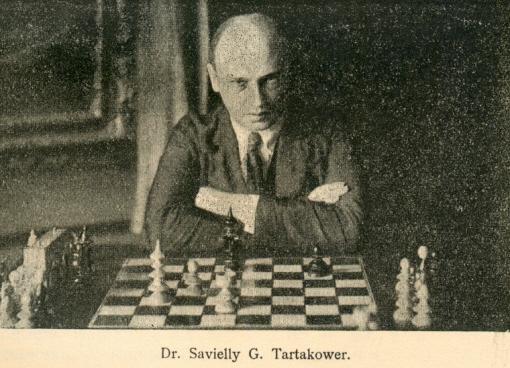
(6675)
‘A draw can be obtained not only by repeating three moves, but also by one weak move.’
Wanted: further particulars about this remark. It was ascribed to Tartakower on, for instance, page 28 of Secrets of Chess Training by Mark Dvoretsky (London, 1991).
(6781)
Information is requested on two items given by Irving Chernev on page 14 of the October 1974 CHESS:
In the latter citation, ‘castle’, instead of ‘capture’, is sometimes seen.
(6829)
An addition to the many entries on castling in the Factfinder comes from page 108 of Tartakower’s Bréviaire des échecs (Paris, 1934):
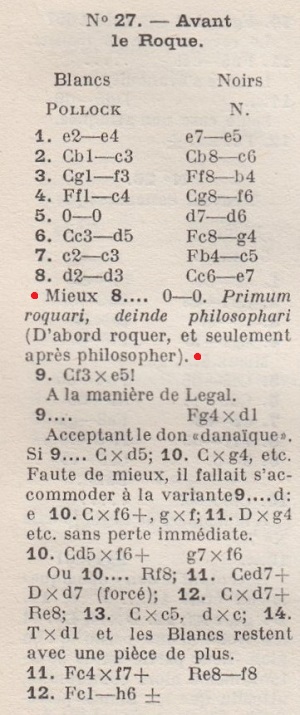
The note to Black’s eighth move in the English translation, A Breviary of Chess (London, 1937), page 83:
‘Better would be 8... castles.
Primum roquari, deinde philosophari (First castle, and then philosophize).’
(The Pollock game has been widely published, with inaccurate or incomplete details. Olimpiu G. Urcan, who is co-writing with John Hilbert a monograph on Pollock for McFarland & Co., Inc., informs us that it was a skittles game played in Baltimore on 5 October 1889 against J. Hall and was published by Pollock in his column in the Baltimore Sunday News, 13 October 1889.)
‘First castle, and then philosophize’ may seem enticing as a snappy Tartakower quote, but caution is needed. Below is a note (after 1 e4 e5 2 Nf3 Nc6 3 Bb5 a6 4 Ba4 Nf6 5 O-O Be7 6 Re1 b5 7 Bb3 d6 8 c3 O-O – Bronstein v Panov, Moscow, 1946) on page 22 of 100 Master Games of Modern Chess by S. Tartakower and J. du Mont (London, 1954):
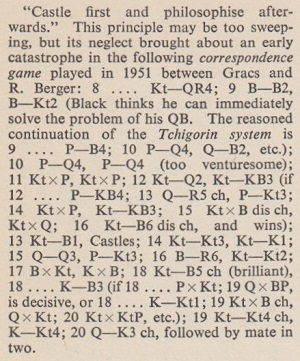
C.N. 6829 noted that Irving Chernev ascribed to Tartakower the remark ‘Capture first and philosophize later’.
(9185)
From page 91 of The Chess Masters on Winning Chess by Fred Reinfeld (New York, 1960):
‘Tartakower had a fluent pen; he wrote voluminously, often annotating a game for a newspaper or magazine while he was playing it.’
Is any further information available about this alleged practice?
(6930)
No information has yet been found on the practice ascribed by Reinfeld to Tartakower (the annotation of games during play). Daniel King (London) asks whether such writing would have been legal in many events of Tartakower’s time.
(6983)
From Leonard Barden:
‘I witnessed Tartakower making notes during at least one game, at one or more of the Southsea tournaments of 1949, 1950 and 1951, where we both participated. His game against Ravn at Southsea, 1951, which is in his Best Games collection, sticks in my mind.
On one occasion I was curious enough to creep up behind him to see exactly what he was doing. There was a dense sheet of variations and quite small writing, and I think he had some difficulty in reading his own material, pushing his spectacles back on his forehead, screwing up his eyes, and peering closely. I feel fairly sure that nobody objected. He was a legend, and the rules on consulting written material during play were more relaxed then than now.’
(6990)
From an article by Lajos Steiner on pages 212-213 of Chess Review, September 1938:
‘Probably no-one can play more strongly than Tartakower. There are better players, more perfect masters. Tartakower has faults, and the greatest of them is that he does not care to avoid getting into difficult positions. Sometimes his ability enables him to extricate himself safely, other times he is left without recourse. Nobody can handle such positions more cleverly, no matter how they may have happened to come about. If he would put forth such efforts in more suitable positions, he would hardly know his superior. But either he cannot succeed in eliminating this fault (it is very difficult to eliminate fundamental faults) or he does not care to – which amounts to the same thing in the end.’
(6977)
Olimpiu G. Urcan notes a Pathé news item on the London, 1946 tournament, featuring Arturo Pomar in play (with the black pieces) against Ossip Bernstein, as well as footage of some other players, including Savielly Tartakower (briefly) and William Winter. The technical quality is good, with a commentary which is quintessentially English.
(6978)
Tartakower wrote as follows in CHESS, May 1940, pages 188-189:
‘The conclusion of the tournament at Budapest in 1928, the one called the “Siesta” tournament, was marked by a dispute. When the last round started, Capablanca led, a point in front of Marshall. It became common knowledge that his game with Vajda had been agreed a draw before a move had been made, with the official consent of the tournament committee. Marshall protested violently, on the grounds that this arrangement deprived him of all chance of sharing in the second prize. The “chance” proved purely theoretical (when he lost to L. Steiner so could not have caught up with Capablanca in any case). Capablanca, moreover, had little reason to fear a defeat at Dr Vajda’s hands. Marshall, however, was badly put out by this incident and took particular pains to inflict on Dr Vajda, the next time he came up against him, a resounding defeat.’
Brief comments: a) Marshall won second prize; clearly, it was the first prize he was eager to share. b) L. Steiner did not play at Budapest, 1928, though ‘E.’ and ‘H.’ did. c) Marshall’s resounding defeat of Vajda was in fact a 35-move draw at the 1930 Hamburg Olympiad.
The above item (C.N. 987) appeared over 25 years ago, but we have yet to obtain clarification of Tartakower’s claims.
(7033)
In C.N. 5875 Olimpiu G. Urcan provided a link to a photograph of Chigorin at the website of the Bibliothèque nationale de France. He now points out three further pictures from the same collection:
On Alekhine’s left is Tartakower, whose opponent that day (11 February) was Znosko-Borovsky. The man standing between Tartakower and Znosko-Borovsky is the tournament director, Alphonse Goetz. Mr Urcan comments that by zooming in it is even possible to read the time on Alekhine’s watch.
(7131)
A fast game of chess (but what were the exact conditions?) was given on page 168 of the August 1923 Wiener Schachzeitung:
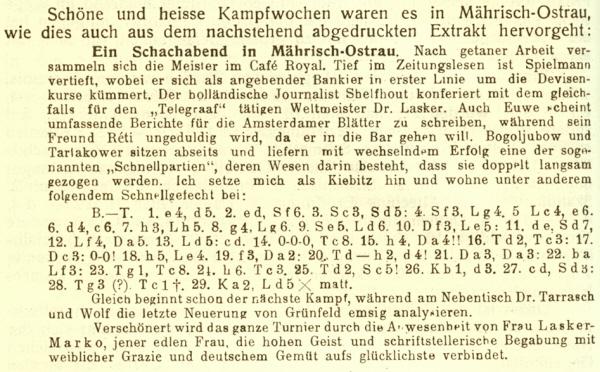
Efim Bogoljubow – Savielly Tartakower
Mährisch-Ostrau, 1923
Center Counter-Game
1 e4 d5 2 exd5 Nf6 3 Nc3 Nxd5 4 Nf3 Bg4 5 Bc4 e6 6 d4 c6 7 h3 Bh5 8 g4 Bg6 9 Ne5 Bd6 10 Qf3 Bxe5 11 dxe5 Nd7 12 Bf4 Qa5 13 Bxd5 cxd5 14 O-O-O Rc8 15 h4
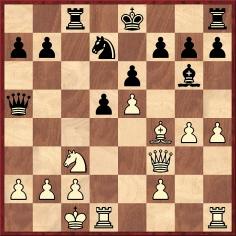
15...Qa4 16 Rd2 Rxc3 17 Qxc3 O-O 18 h5 Be4 19 f3 Qxa2 20 Rdh2 d4 21 Qa3 Qxa3 22 bxa3 Bxf3 23 Rg1 Rc8 24 h6 Rc3 25 Rd2 Nc5 26 Kb1 d3 27 cxd3 Nxd3 28 Rg3 Rc1+ 29 Ka2 Bd5 mate.
(7193)
A game from a simultaneous display in which Tartakower scored +17 –1 =0:
S.W. Dickens – Savielly Tartakower1 d4 d5 2 c4 e6 3 Nc3 Nf6 4 Bg5 Be7 5 e3 Nbd7 6 Nf3 O-O 7 Rc1 c6 8 a3 Ne4 9 Bxe7 Qxe7 10 Bd3 f5 11 O-O Rf6 12 Ne2 Rh6 13 Ng3
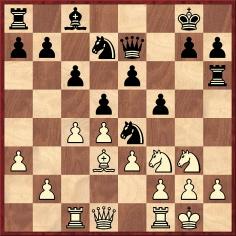
13...g5 (‘Fierce, but premature attack.’) 14 cxd5 (‘Initial move of a combination threatening to win two pawns and the exchange.’) 14...g4 15 dxe6 gxf3 16 Nxf5 Qxe6 17 Nxh6+ (‘17 Bc4, pinning the queen, would shorten the road to victory.’) 17...Qxh6 18 Bxe4 fxg2 19 Bxg2 Nf6 20 Qf3 Kh8 21 Rc5 Bg4 22 Qf4 Qxf4 23 exf4 Rd8 24 h3 Bh5 25 Rf5 Kg7 26 Re1 Rxd4 27 Re7+ Kg6 28 Rg5+ Kh6 29 Rxb7 Rxf4 30 Rc5 Bg6 31 Rxa7 Rd4 32 Rxc6 Nh5 33 Rac7 Rd1+ 34 Kh2 Rd2 35 Be4 (‘A good manoeuvre to gain freedom.’) 35...Rxf2+ 36 Kg1 Rxb2 37 Bxg6 hxg6 38 a4 Nf4 39 a5 Ra2 40 a6 Kh5 41 a7 Kh4 42 Rc4 g5 43 Rh7+ Kg3 44 Rc3+ Resigns.
Source: pages 19 and 68-69 of Chess in Bedfordshire by F. Dickens and G.L. White (Leeds, 1933).
(7224)
According to one of the most famous chess quotes, regularly attributed to Tartakower, the winner is the player who makes the next-to-last mistake.
We would point out that the observation pre-dates Tartakower. For example, the following was on page 313 of the October 1890 Deutsche Schachzeitung:
‘Es ging in den Turnieren ziemlich bunt her. Der erste Rang im Meisterturnier wurde nach dem bekannten Witzworte entschieden, wonach derjenige gewinnt, welcher den vorletzten Fehler macht (s. Partie Nr. 5391).’
The game in question was Makovetz v Lasker, Graz, 1890, which was given on page 305 of the same issue:
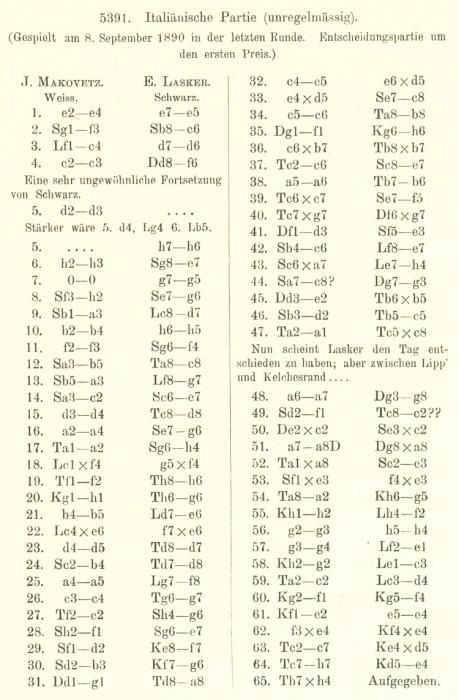
Another example of the remark is on page 167 of the June 1901 Deutsche Schachzeitung, in the notes by Alapin to Mieses v von Scheve, Monte Carlo, 1901:
‘Ein Fehler folgt dem anderen! Dieser hat aber den Vortheil, “der vorletzte” zu sein und muss deshalb gewinnen!’
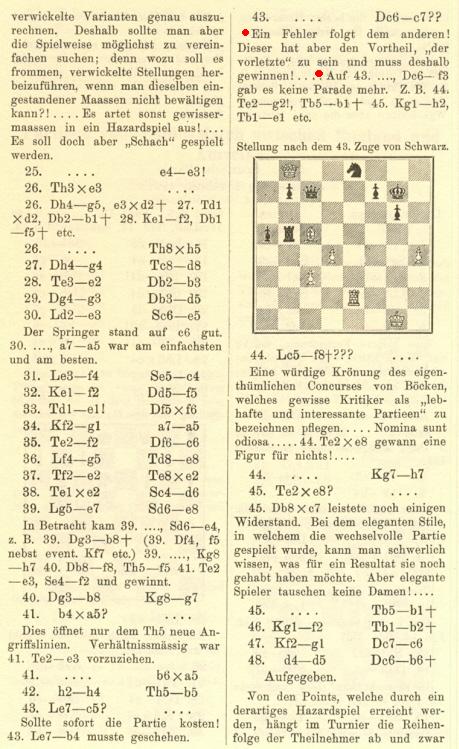
(7228)
On 25 March 2024 Ben Finegold posted on his YouTube channel a game with a complicated rook ending submitted by a viewer. Afterwards, starting at 13’17”, Finegold drolly commented that most games from viewers had seven blunders by one side and eight by the other.
C.N. 7228 gave two pre-Tartakower (1890 and 1901) occurrences of the observation that the winner is the player who makes the last mistake but one, but information is still sought on when it was first attached to Tartakower’s name, or to that of other masters.
In the latter category, Barnie F. Winkelman wrote on page 205 of Chess Review, September 1935:
‘To Lasker chess was (and remains) a contest, a personal encounter in which he frequently avoided the best variations, and sought to give battle on unfamiliar ground. “The winner of a game of chess”, he is reported to have said, “is he who makes the last mistake but one.”’
With terms like ‘is reported to have said’ (and ‘reportedly said’), the floodgates are open for anyone to write anything.
(11998)
On 28 April 1987 Olga Capablanca Clark offered for sale the score-sheet of an unknown game played by her late husband and Tartakower in Paris circa 1938. The text of her letter to us is given in The Genius and the Princess. The reserve price for the score-sheet was not met, and a footnote on page 181 of Kings, Commoners and Knaves mentioned that in 1998 we were unaware of the document’s whereabouts. Subsequently (see C.N.s 5323 and 6687) we learned that the score-sheet had become part of the collection of Mr David DeLucia (Darien, CT, USA).
It will be featured in Mr DeLucia’s forthcoming work, a two-volume set entitled In Memoriam, and we are most grateful to him for allowing the game to appear for the first time here, in the present C.N. item:
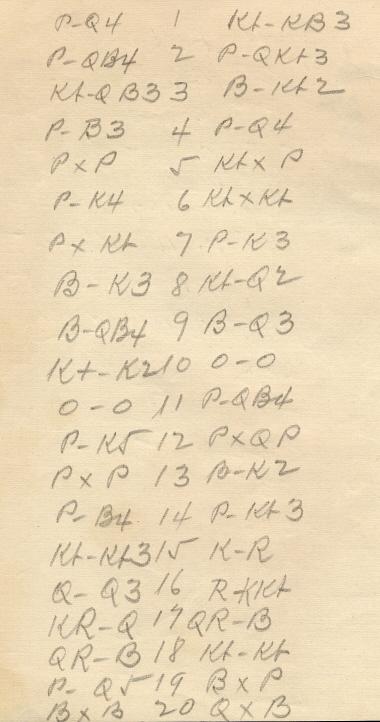
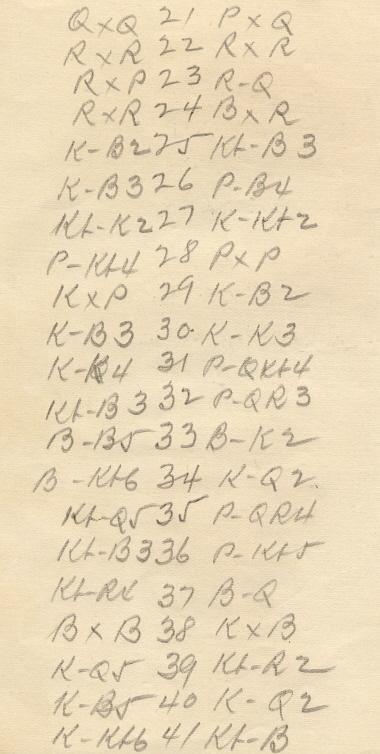
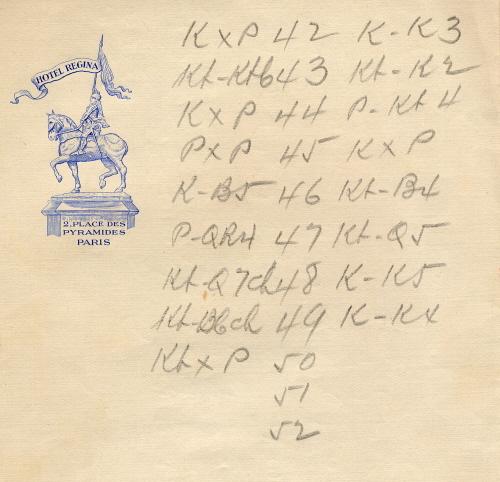
José Raúl Capablanca – Savielly Tartakower
Paris, circa 1938
Queen’s Indian Defence
1 d4 Nf6 2 c4 b6 3 Nc3 Bb7 4 f3 d5 5 cxd5 Nxd5 6 e4 Nxc3 7 bxc3 e6 8 Be3 Nd7 9 Bc4 Bd6 10 Ne2 O-O 11 O-O c5 12 e5 cxd4 13 cxd4 Be7 14 f4 g6 15 Ng3 Kh8 16 Qd3 Rg8 17 Rfd1 Rc8 18 Rac1 Nb8 19 d5 Bxd5 20 Bxd5 Qxd5 21 Qxd5 exd5 22 Rxc8 Rxc8 23 Rxd5 Rd8 24 Rxd8+ Bxd8
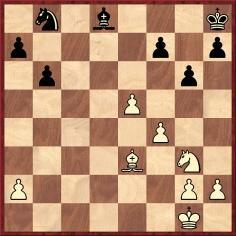
25 Kf2 Nc6 26 Kf3 f5 27 Ne2 Kg7 28 g4 fxg4+ 29 Kxg4 Kf7 30 Kf3 Ke6 31 Ke4 b5 32 Nc3 a6 33 Bc5 Be7 34 Bb6 Kd7 35 Nd5 a5 36 Nc3 b4 37 Na4 Bd8 38 Bxd8 Kxd8 39 Kd5 Na7 40 Kc5 Kd7 41 Kb6 Nc8+ 42 Kxa5 Ke6 43 Nb6 Ne7 44 Kxb4 g5 45 fxg5 Kxe5 46 Kc5 Nf5 47 a4 Nd4 48 Nd7+ Ke4 49 Nf6+ Ke5 50 Nxh7 1-0.
(7497)
Steve Wrinn (Homer, NY, USA) notes a discrepancy in the game-score Grünfeld v Tartakower, Semmering, 1926.
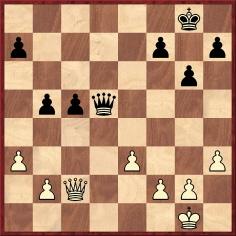
In this position, the question is whether play went 26 f4 c4 27 Qc3 Qe4 or 26 Qc3 c4 27 f4 Qe4. Our correspondent notes that Tartakower gave the former in the first volume of his Best Games but the latter when annotating the game at the time, in Kagans Neueste Schachnachrichten:
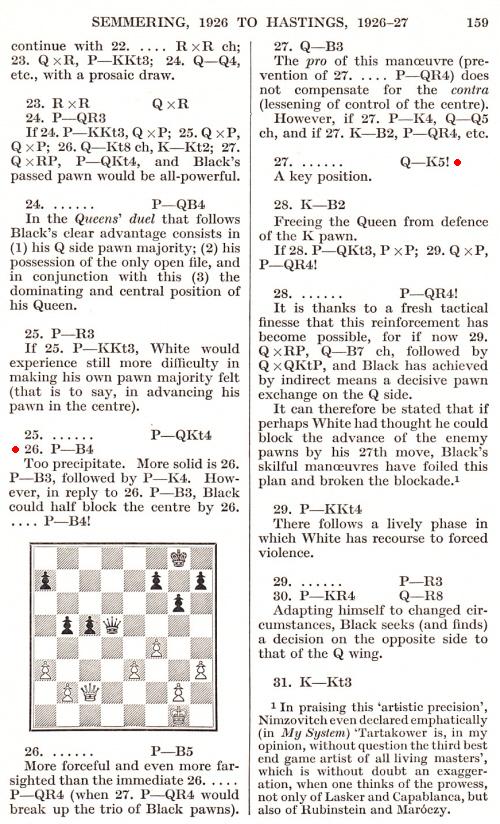
My Best Games of Chess 1905-1930 by S.G.Tartakower (London, 1953), page 159
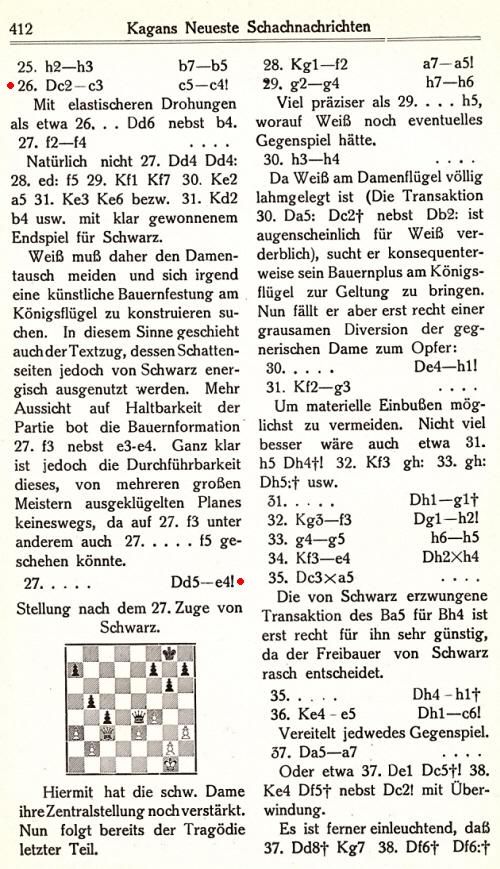
Kagans Neueste Schachnachrichten, July-September 1926, page 412
(7527)
Mike Salter (Sydney, Australia) notes the comment after 7...c6 in Tartakower’s notes to his game against Speijer (St Petersburg, 1909) in Tartakowers Glanzpartien 1905-1930. The following is from page 45 of the second edition (Berlin and New York, 1986), after the moves 1 d4 Nf6 2 Nf3 d6 3 b3 g6 4 Bb2 Bg7 5 e3 O-O 6 Be2 Nbd7 7 O-O c6:
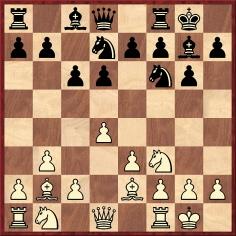
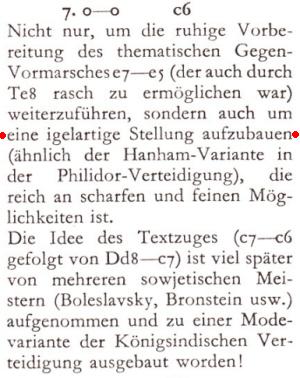
We add below the note as it appeared on page 59 of Tartacover vous parle (Paris, 1953):
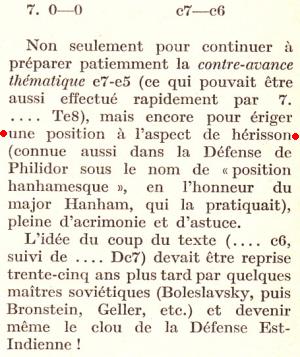
And from page 39 of Tartakower’s My Best Games of Chess 1905-1930 (London, 1953):
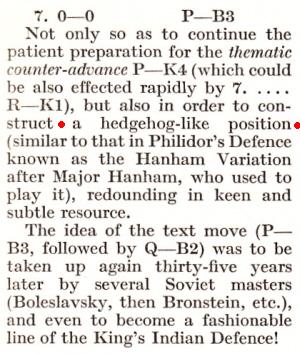
Mr Salter asks whether this is the first reference in chess literature to a ‘hedgehog’ formation. Citations from readers will be appreciated.
We note that on page 171 of the June 1951 Chess Review Tartakower annotated his win over Vidmar (Vienna, 1905). After 1 e4 c5 2 d4 cxd4 3 Nf3 Nc6 4 Nxd4 Nf6 5 Nc3 d6 6 Be2 g6 ...
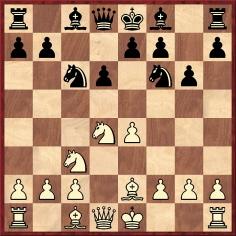
... Tartakower commented:
‘The Dragon Variation was very popular in those days and was in fact a favorite weapon of my own. I had for example won some impressive games in the Hauptturnier at Barmen in 1905.
Some 15 years later, with the rise of the Hypermodern School, the less obvious merits of the Scheveningen Variation began to be appreciated. This line, which calls for 6...e6, is characterized by the position of the black pawns at e6 and d6 and gives the player of the black pieces a kind of “hedgehog” position.’
(7574)
Brian Karen (Levittown, NY, USA) adds a citation from page 69 of 500 Master Games of Chess by S. Tartakower and J. du Mont (London, 1952):
‘In this, the normal position of the Steinitz Defence, Black occupies a “hedgehog” formation. All his minor pieces are in a state of expectant defence. White has now a large choice of good continuations, but none likely to upset Black’s defensive formation.’
The note came after 1 e4 e5 2 Nf3 Nc6 3 Bb5 Nf6 4 O-O d6 5 d4 Bd7 6 Nc3 Be7 7 Re1 exd4 8 Nxd4 O-O in Tarrasch v Lasker, second match-game, 1908.
The image of a curled-up hedgehog was used by Nimzowitsch on pages 70 and 115 of Die Praxis meines Systems (Berlin, 1930); see pages 100 and 163 of The Praxis of My System (London, 1936).
On page 202 of the September 1937 Chess Review Paul Hugo Little wrote regarding the game Pipiringos v Hahlbohm, Chicago, 1937:
‘[Pipiringos] got himself into a weird position resembling one of Steinitz’s hedgehog defenses, and quickly lost.’
(8211)
Christian Sánchez (Rosario, Argentina) points out hedgehog references on page 69 of El Ajedrez Americano, March 1931, concerning the line 1 e4 e5 2 Nf3 Nc6 3 Bb5 d6 4 d4 Bd7 5 Nc3 Nf6 6 O-O Be7 7 Re1 exd4 8 Nxd4 O-O:
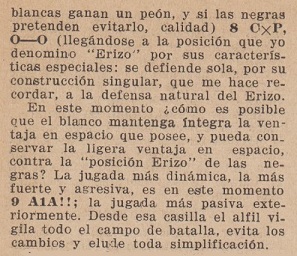
The text was in an extract from a lecture on openings which Tartakower gave in Buenos Aires on 3 March 1931, as specified by the magazine in its heading on the previous page:
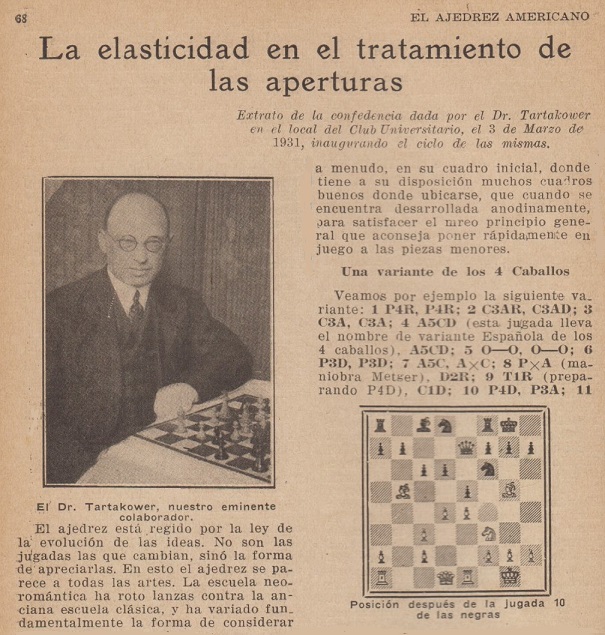
(9947)
See too The Chess Hedgehog.
A quote published on page 186 of Combinations The Heart of Chess (New York, 1960) by Irving Chernev:

No source was given, but the observation comes from an article by Tartakower on pages 362-363 of the December 1954 Chess Review:
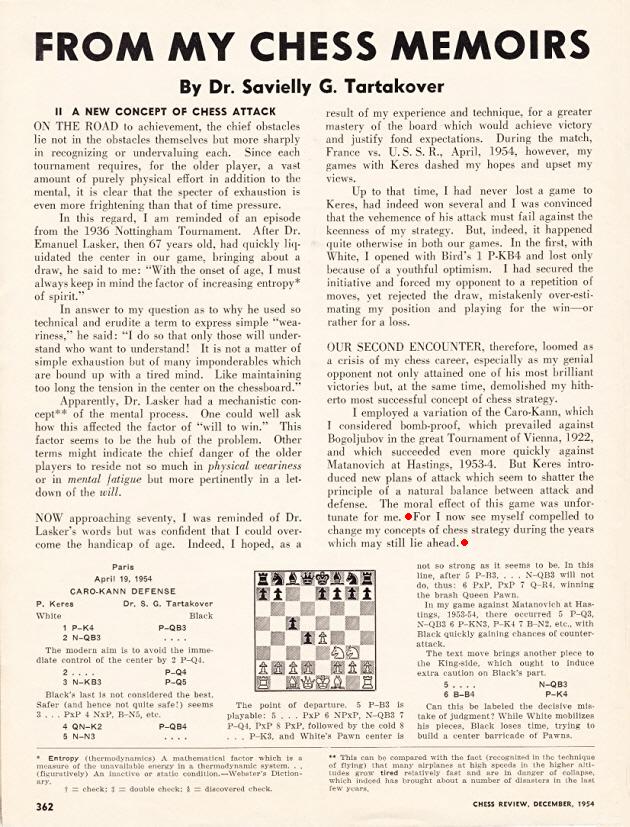
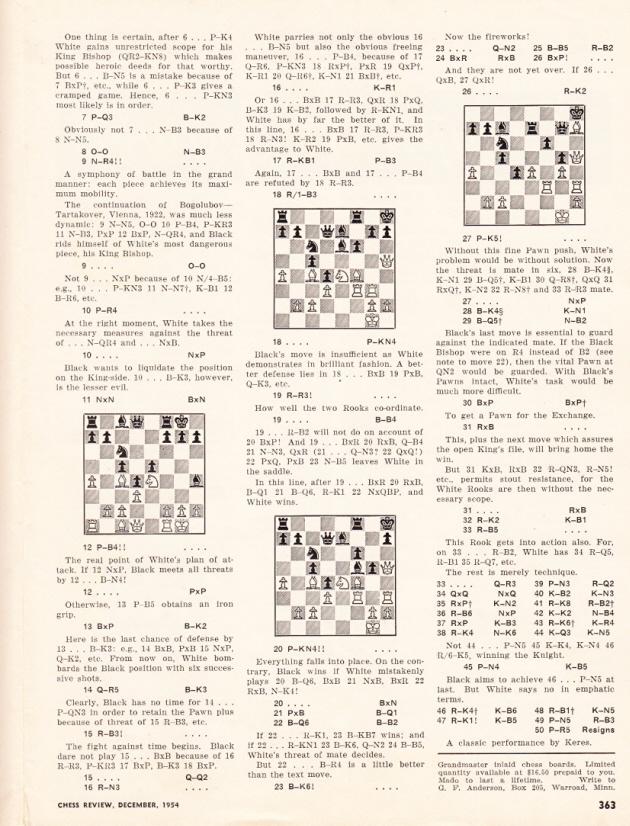
The Keres v Tartakower game was discussed by Fischer on page 172 of the July-August 1963 Chess Life:
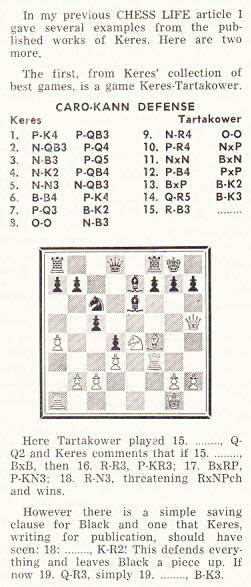
In the diagram White’s bishop is missing from c4.
In his previous article (Chess Life, June 1963, page 142) Fischer mentioned that he had been reading Keres’ ‘recent book of his best games (in Estonian)’. Below is the relevant note in the Keres v Tartakower game, from page 381 of that work, Valitud partiid 1931-1958 (Tallinn, 1961):
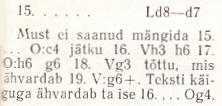
The position before Fischer’s discovery, 18...Kh7:
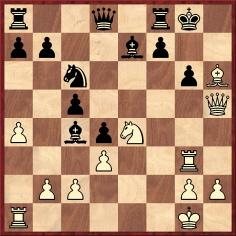
(7801)
Below is a photograph from Valitud partiid 1931-1958 by Paul Keres (Tallinn, 1961), page 37:
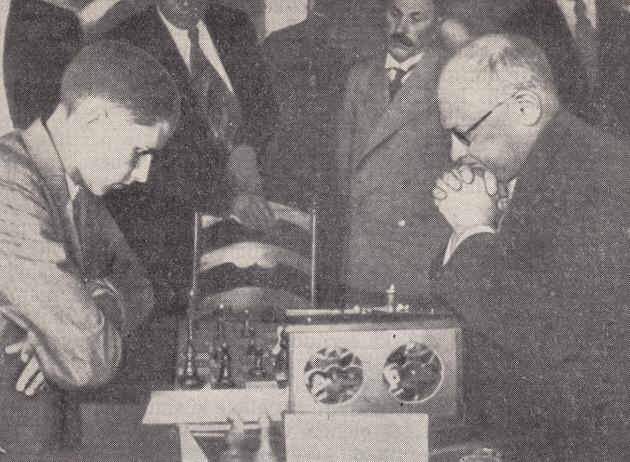
Paul Keres v Savielly Tartakower, Kemeri, 1937
(7802)
Marc Hébert (Charny, Canada) draws attention to an article by Tartakower, ‘Chess in Paris’ on pages 74-75 and 96 of the March 1953 Chess Review. The first page:
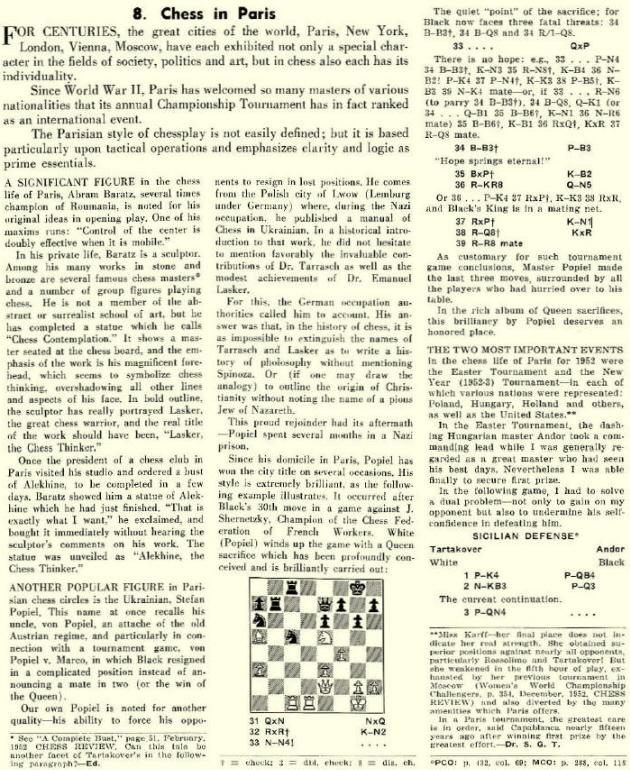
Further details about the various interesting points made by Tartakower will be welcome.
Stephan A. Popel subsequently moved to the United States and was on the front cover of the March 1958 Chess Review:
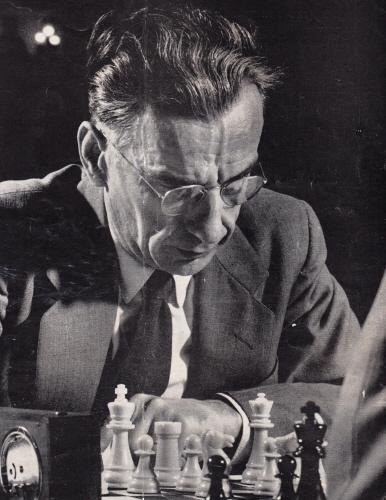
From page 68 of the same issue:
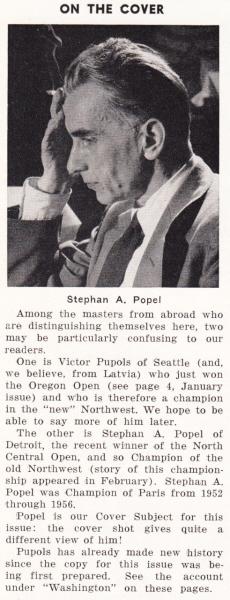
(7825)
Michael Negele has been looking into Tartakower’s date of birth, on the basis of the citations in Jeremy Gaige’s Chess Personalia (Jefferson, 1987). The consensus (e.g. Deutsche Schachzeitung, January 1918, page 23, and L’Echiquier, 2 December 1933, page 333) is that Tartakower was born on 21 February 1887 (Gregorian calendar), i.e. 9 February 1887 in the Julian calendar.
Our correspondent has raised the matter because the English and French editions of the first volume of Tartakower’s best games, published in 1953, gave 9/22 February 1887. For example, the following appeared in the Introduction to Tartakover vous parle:
‘Ami lecteur, voici ce que tu dois savoir sur moi:
Xavier Tartacover (Tartakower) est né le 9 février (ancien style, correspondant au 22 février du calendrier grégorien) 1887, à Rostoff-sur-le-Don (Russie).’
As mentioned in C.N. 4819, however, in the nineteenth century the gap between the two calendars was 12 days, and not 13.
(7836)
Two Tartakower witticisms from pages 23 and 109 of The Bright Side of Chess by Irving Chernev (Philadelphia, 1948):
Since quotes without sources are also without value, we reproduce pages 186-187 of Tartakower’s book Das entfesselte Schach (Kecskemét, 1926):
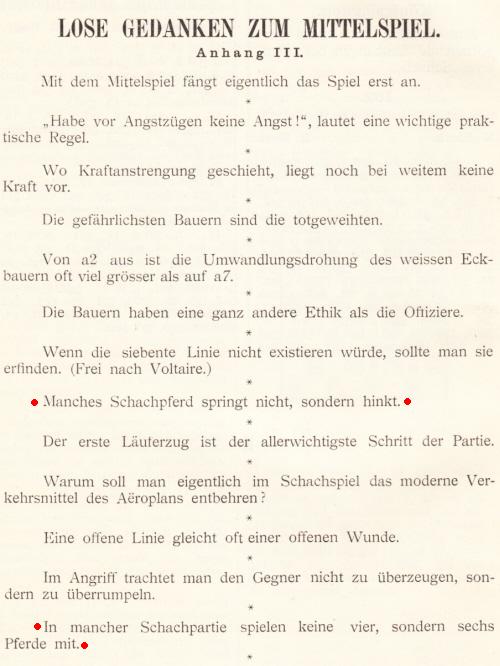
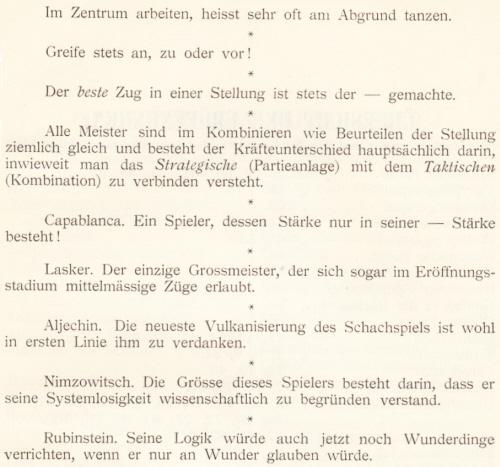
(7856)
C.N. 2381 (see page 39 of A Chess Omnibus) gave this position from Tartakower v Colle, San Remo, 2 February 1930:
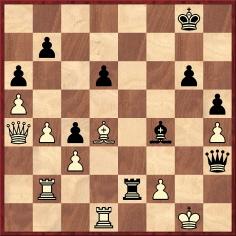
We wrote:
Tartakower has just set a little trap with 35 Rb1-b2. The game ended 35…Qh2+ 36 Kf1 Re7 37 Be3 (In the Lachaga tournament book Becker recommended 37 f3 Qxb2 38 Re1.) 37…Bxe3 38 fxe3 Qh1+ 39 Kf2 Rf7+ 40 Ke2 Qg2+ 41 Ke1 Rf1 mate.
From the diagram Colle could have given mate in six: 35…Bh2+ 36 Kh1 Be5+ 37 Kg1 Qh2+ 38 Kf1 Bxd4 39 Qe8+ Rxe8, etc., a line pointed out by W. Rivier in the Schweizerische Schachzeitung, January 1931 (pages 11-12) and March 1931 (page 45).
The position was discussed by Kurt Richter on page 113 of his book Kombinationen (Berlin and Leipzig, 1936), with a mention of Rivier:
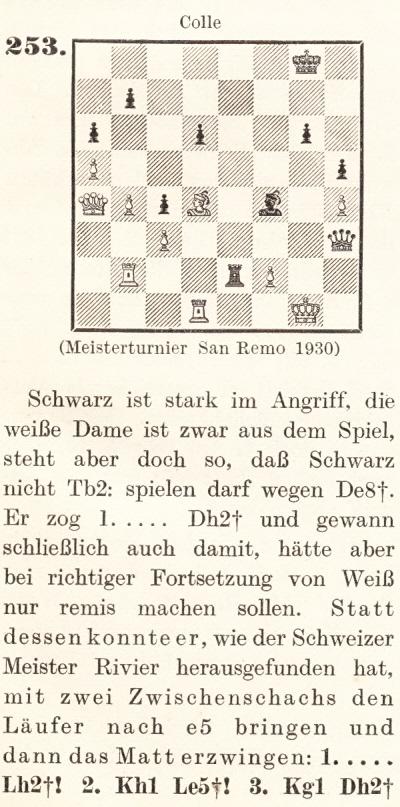
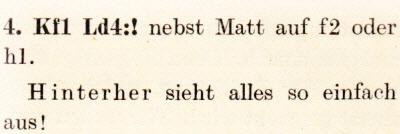
With a mention of Rivier, but not of Tartakower, because throughout the book the names of various (though not all) Jewish players were deleted. For instance:
The process was intensified in the second edition of Richter’s book (Berlin, 1940), as shown by position 66 on page 29:
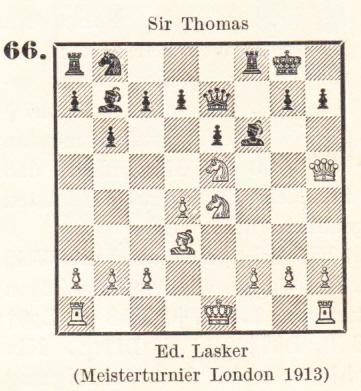
1936 edition
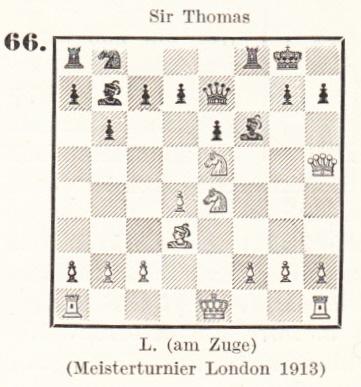
1940 edition
Similarly, in the 1936 edition ‘Dr Lasker’ was named as the opponent of Bogoljubow (Zurich, 1934, in position 107) and of Torre (Moscow, 1925, in position 237). Four years later, the former world champion’s name was reduced in both cases to ‘L.’.
Expurgations were even retained in the post-War translation Combinaciones en el medio juego (Buenos Aires, 1947):
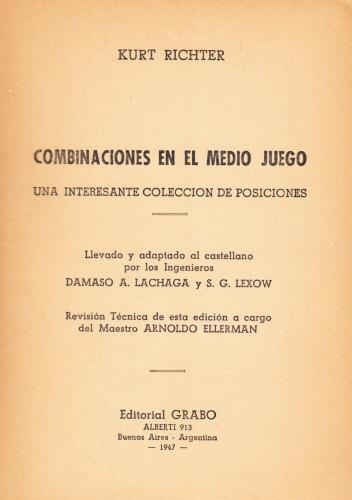
An example from page 158:
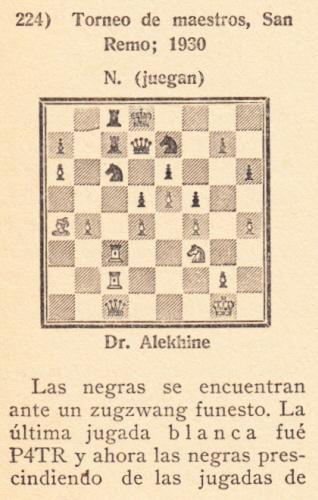
In the 1936 German edition Nimzowitsch had been identified in connection with this position, but there was only ‘N.’ in the 1940 volume.
Later editions of Kombinationen restored the masters’ names.
(7875)
Below is the text of C.N. 3048 (see page 54 of Chess Facts and Fables), concerning a familiar miniature:
Lukomsky – Pobedin
Moscow, 1929
Queen’s Fianchetto Defence1 d4 Nf6 2 c4 b6 3 Nc3 e6 4 e4 Bb4 5 e5 Ne4 6 Qg4 Nxc3 7 bxc3 Bxc3+ 8 Kd1 Kf8 9 Rb1 Nc6 10 Ba3+ Kg8 11 Rb3 Bxd4
12 Qxg7+ Kxg7 13 Rg3+ Resigns.
Some sources (including the Wiener Schachzeitung, June 1929, pages 184-185) gave Pobedin’s name as ‘Podebin’.
The game illustrates how prominent masters may differ in their appreciation of games and positions. Annotating the miniature on pages 122-124 of the June 1930 Ajedrez, Tartakower gave White’s 12th move two exclamation marks and referred to ‘this splendid queen sacrifice’. On page 178 of 1000 Best Short Games of Chess (New York, 1955) Irving Chernev reported that Marshall ‘was fond of this game’. In contrast, Réti found the combination ‘banal and uninteresting’. He was writing in Morgenzeitung, and his notes were reproduced on pages 218-219 of the July 1929 Deutsche Schachzeitung. See also page 5 of Réti’s Best Games of Chess by H. Golombek (London, 1954).
For ease of reference, we add here the Tartakower and Réti texts:
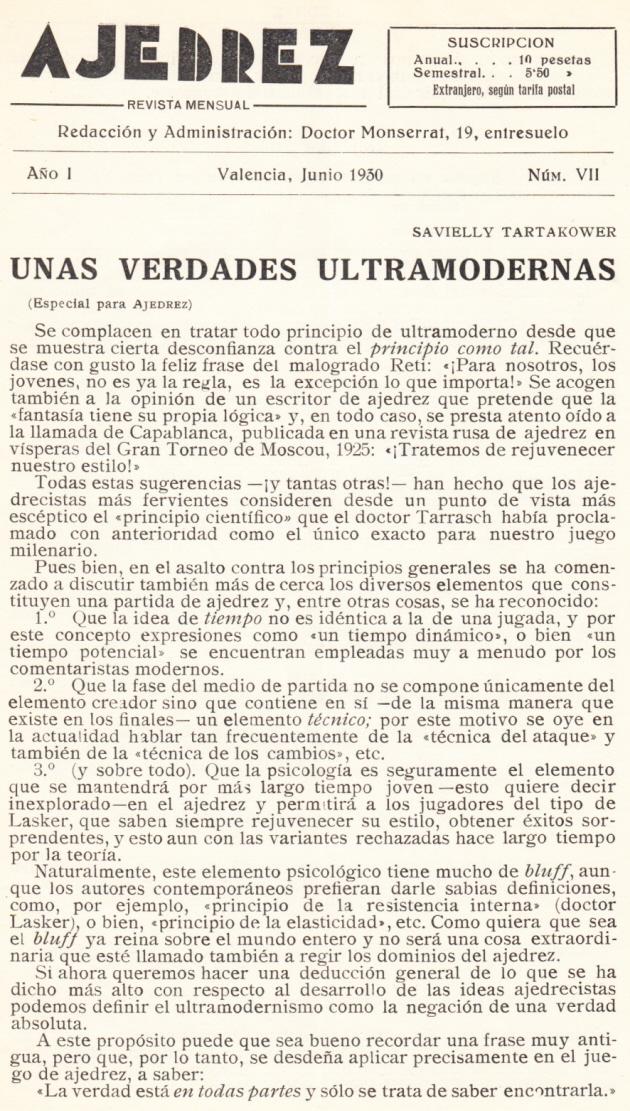
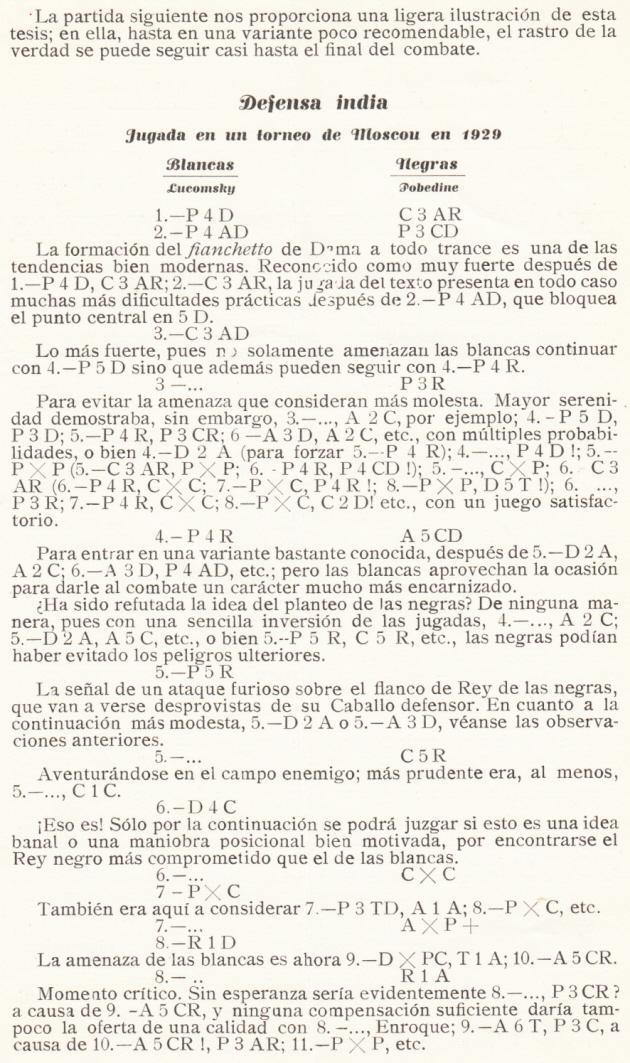
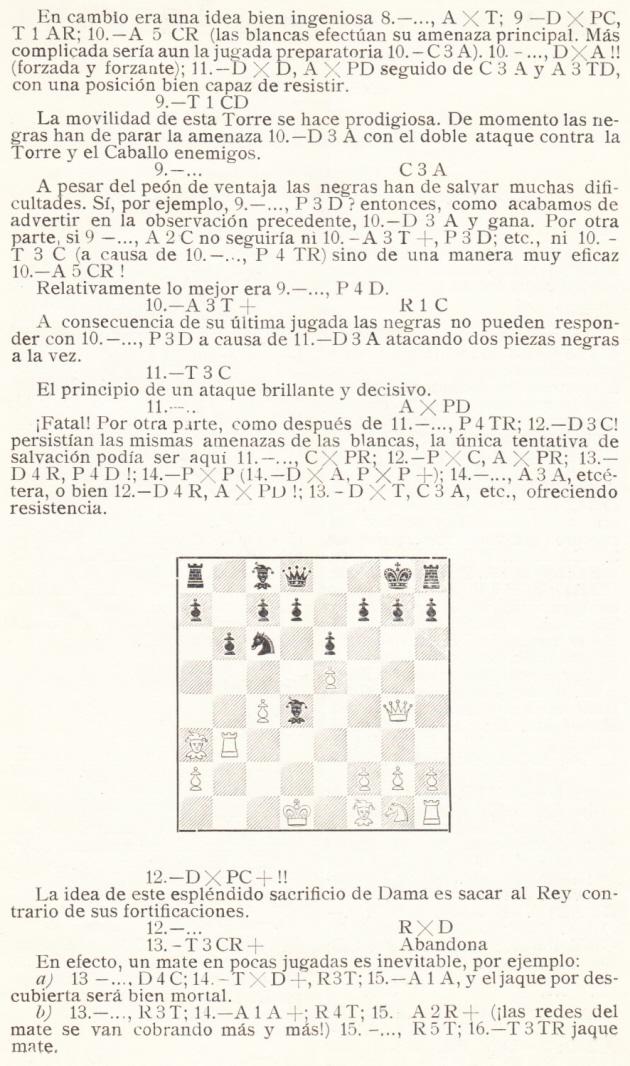
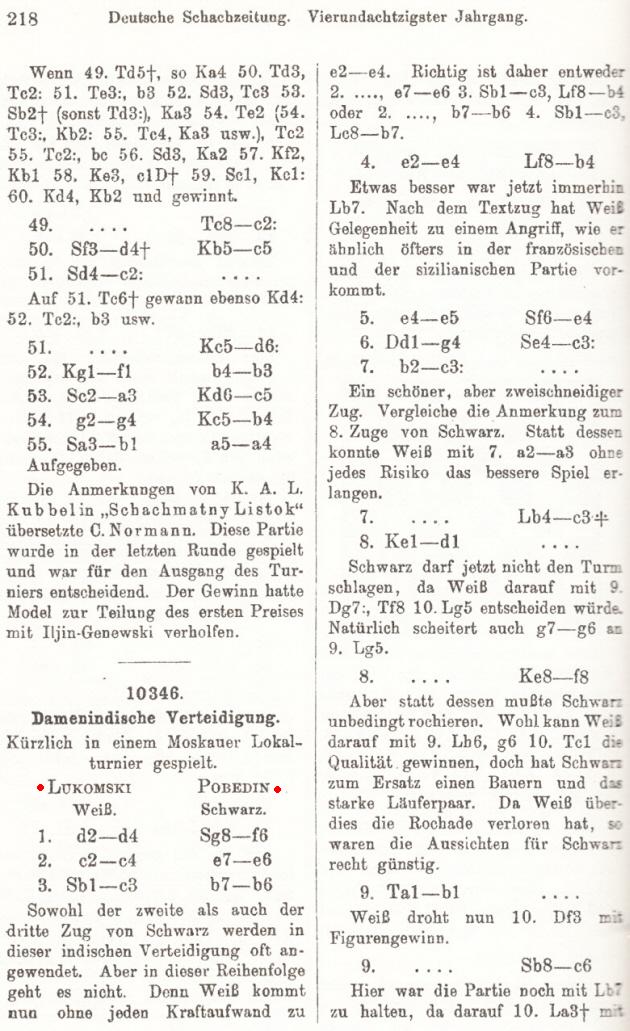
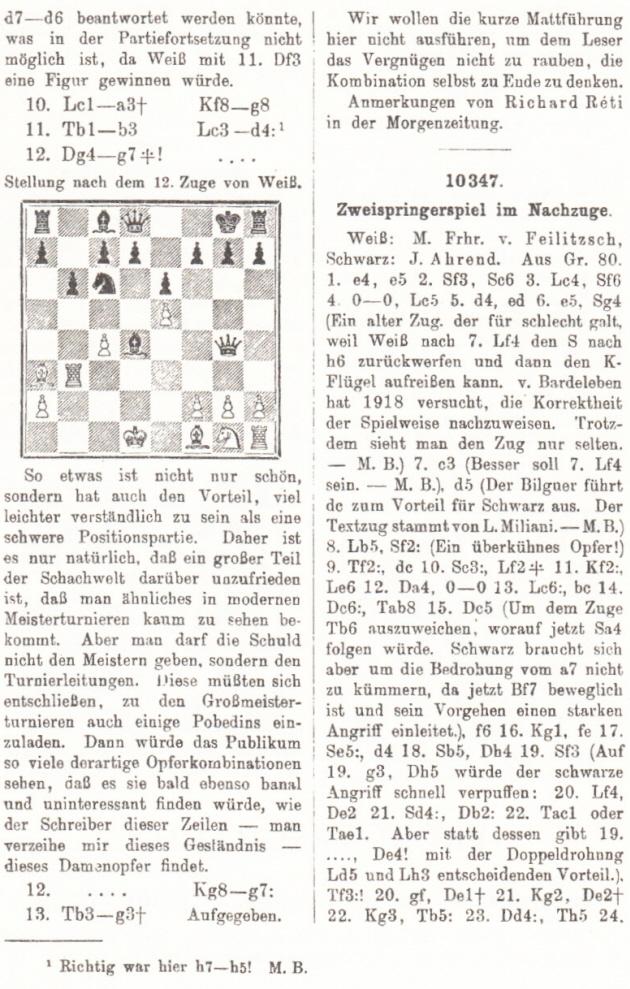
Finally, the text on page 5 of Golombek’s book on Réti:
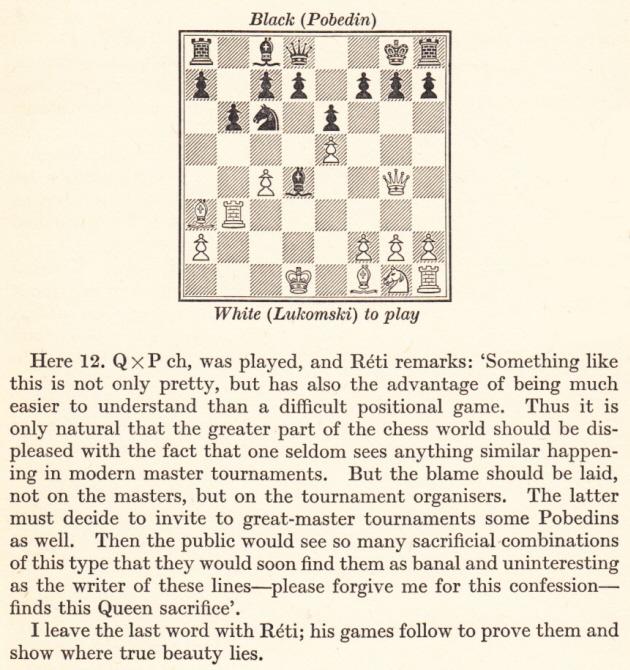
In some databases White was named as Lugowski or Lukowski. What is the earliest known publication of the game in a Soviet source?
(7900)
1 d4 d5 2 c4 e6 3 Nc3 Nf6 4 Bg5 Nbd7 5 e3 Be7 6 Nf3 O-O 7 Qc2 c6 8 a3 dxc4 9 Bxc4 Nd5 10 Bxe7 Qxe7 11 Ne4 N5f6 12 Bd3 Nxe4 13 Bxe4 h6 14 O-O e5 15 Rfe1 Qf6 16 Rad1 exd4 17 exd4 Nb6 18 Ne5 Be6 19 Re3 Rad8 20 Rf3 Qh4 21 g3 Qh5 22 h4 Bg4 23 Re1 Nd5 24 Rxf7 Rxf7 25 Bh7+ Kh8 26 Bg6 Qxe5 27 dxe5 Rff8 28 e6 Ne7 29 Bf7 Rd4 30 Qc5 Rfd8 31 Qxe7 Bf3 32 Qxd8+ Resigns.
This game was won by Salo Flohr against Karel Vaněk in a team match in Brno between Prague and Brno on 3 November 1929. He annotated it on pages 182-183 of the December 1929 Československý Šach, and a more detailed set of notes was provided by Tartakower on pages 9-11 of the January 1930 issue of Ajedrez (published in Valencia):
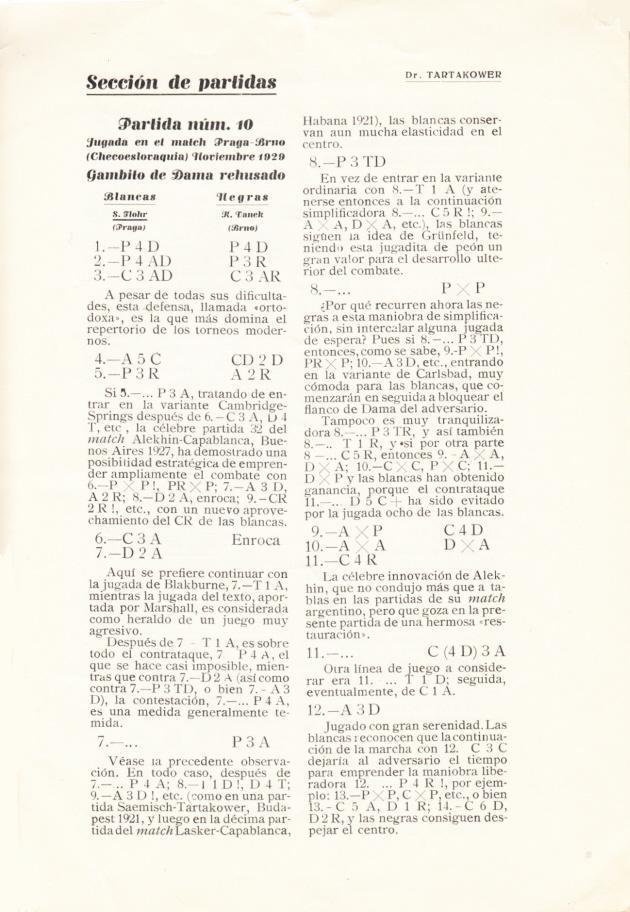
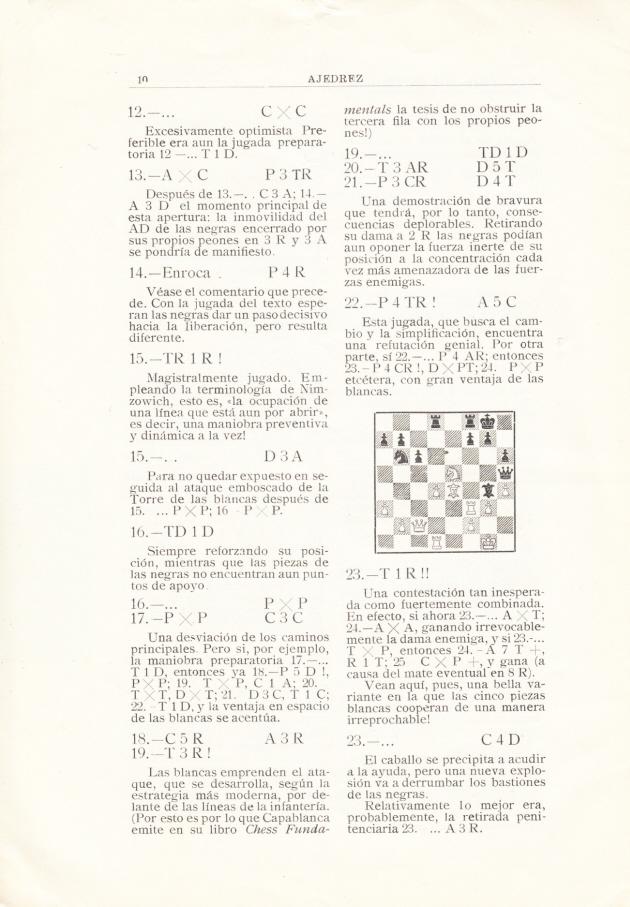
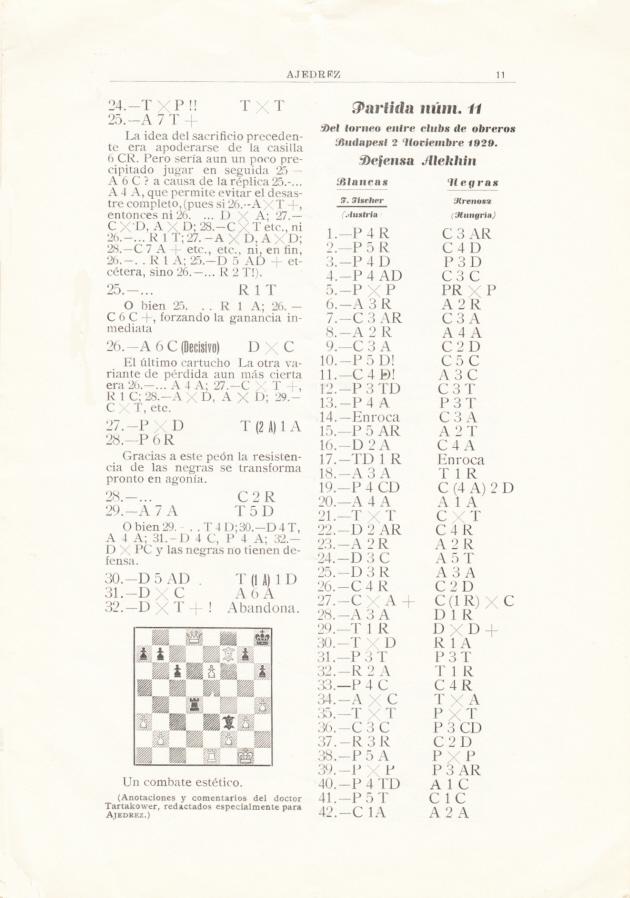
Readers are invited to compare Tartakower’s notes with those on pages 28-30 of Salo Flohr Master of Tactics, Master of Technique edited by Jimmy Adams (Nottingham, 1985).
(7918)
From page 30 of Kings of the Chess Board by Lajos Steiner (Roseville, 1948):
‘Tartakower is truly the grand (not old, as he is fresh, virile and very active) man of chess. He was always a symbol to me. I never knew an intrinsically stronger chessmaster. There were better players, as Tartakower deliberately chose inferior openings – for pure devilment at first and later as a habit. But, when he got into the inevitable jam, Tartakower played with the strength of steel, often extricating himself.’
(3098)
Tartakower was a prolific contributor to the magazine Ajedrez
(1929-30). An annotated game was given in C.N. 7918, and below
is an article on psychology in chess, on pages 1-4 of the
January 1930 issue:
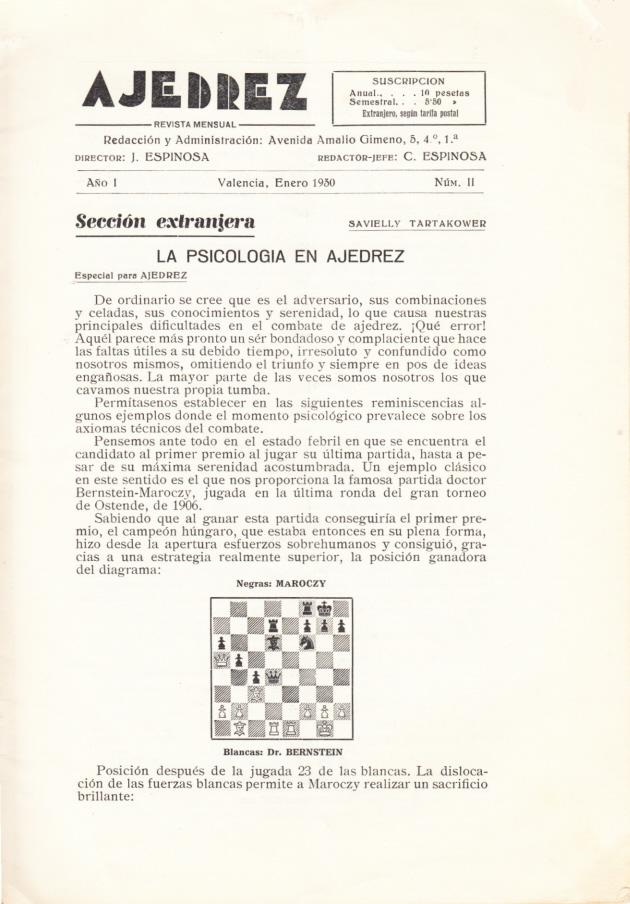
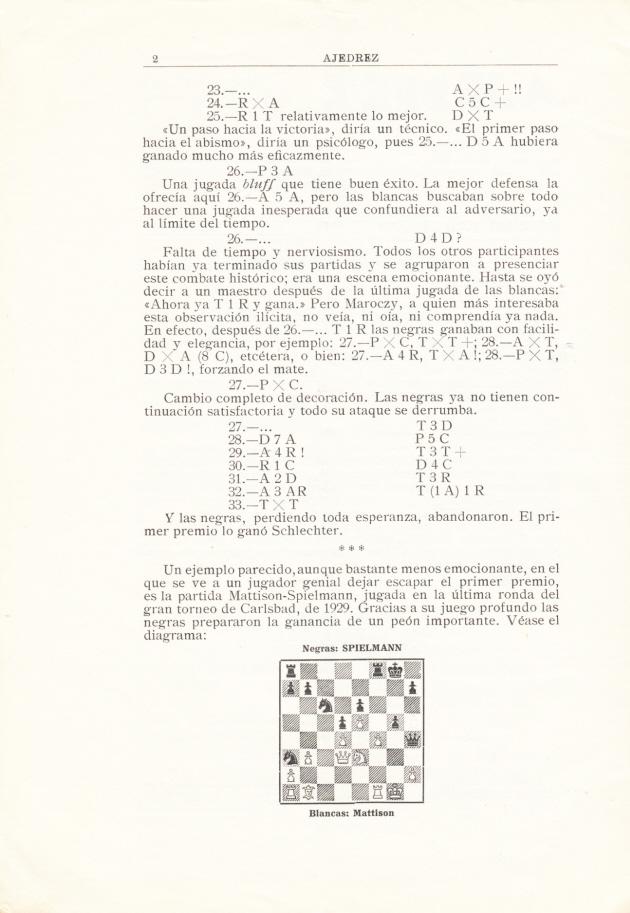
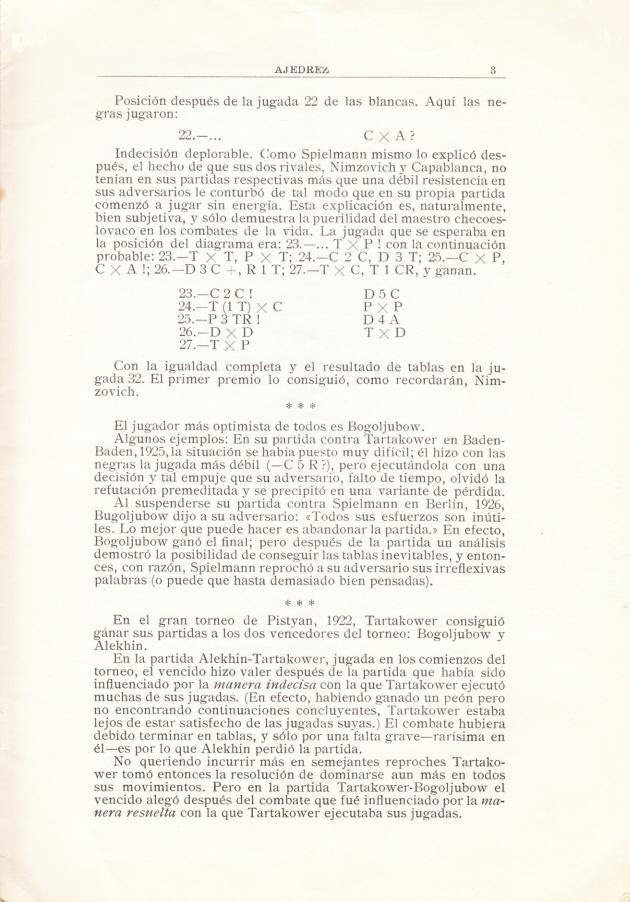
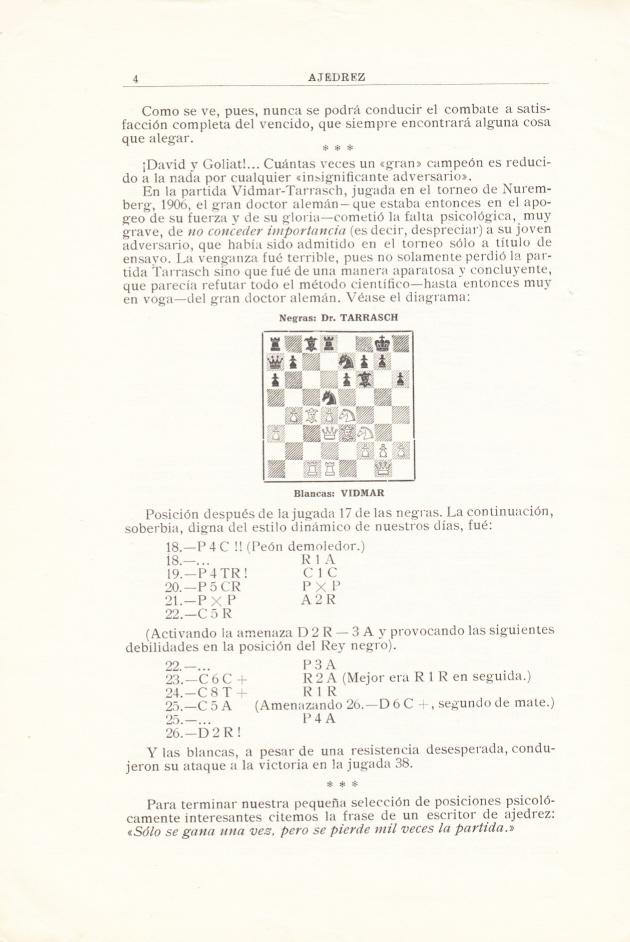
See too Chess and Psychology.
(7931)
Dominique Thimognier (Fondettes, France) writes that a CD-ROM on ‘Naturalisations en France entre 1900 et 1950’ records that Alekhine was naturalized on 5 November 1927, the same day as his wife (née Fabritsky, born in Odessa on 19 March 1884). The decrees were numbered 11670-27 and 11676-27 respectively.
We are also grateful to Stéphane Krebs (Cafquefou, France) for providing the same information, from the genealogie.com website.
(8058)
From the website mentioned in the previous item Mr Krebs also notes the following entries:‘Ossip Bernstein
Naturalisation
Numéro de décret: 3057-33
Sujet: Bernstein Ossip
Naissance: le 20 septembre 1882 à Jitomir (Russie)
Lieu de l’acte: France
Date de l’acte: le 15 mars 1933.’‘Vitaly Halberstadt
Naturalisation
Journal Officiel: Journal Officiel du 15 septembre 1957
Décret: Décret du 23 août 1957
Numéro de décret: 14275x39-75.
Article: Art. 1. Sont naturalisés Français:
Sujet: Halberstadt Vitali
Naissance: le 20 mars 1903 à Odessa (Russie)
Lieu de l’acte: France
Date de l’acte: en 1957.’‘Saveli Tartakower
Naturalisation
Numéro de décret: 8340-45
Sujet: Tartakower Saveli
Naissance: le 9 février 1887 à Rostoff sur Don (Russie)
Lieu de l’acte: France
Date de l’acte: le 13 décembre 1945.’
(8059)
From page 118 of La Stratégie, May 1924:
‘Paris. A son retour du Tournoi de New York, le maître Tartakover donne deux séances de chacune 10 parties sans voir: l’une aux Echecs du Palais-Royal le dimanche 7 mai, avec le résultat de 7 gagnées et 3 nulles; l’autre le mercredi suivant au Cercle Philidor avec le résultat de 9 gagnées et 1 nulle.’
There remains doubt about the dates of both séances, as 7 May 1924 was a Wednesday, and not a Sunday.
No game-scores were given by La Stratégie, and blindfold games by Tartakower are scarce. However, the draw in the second display was published, courtesy of his opponent, on page A3 of the Brooklyn Daily Eagle, 12 June 1924:
Savielly Tartakower (blindfold) – Reuben Goldsmith
Paris, May 1924
Scotch Game
1 e4 e5 2 Nf3 Nc6 3 d4 exd4 4 Nxd4 Bc5 5 Be3 Qf6 6 c3 Nge7 7 Nc2 Bxe3 8 Nxe3 d6 9 Nd2 O-O 10 Be2 Ne5 11 O-O N5g6 12 g3 Bh3 13 Ng2 Qe5 14 f4 Qc5+ 15 Rf2 Bxg2 16 Kxg2 f5 17 Bf3 Kh8 18 Qc2 fxe4 19 Nxe4 Qb6 20 h4 Nf5
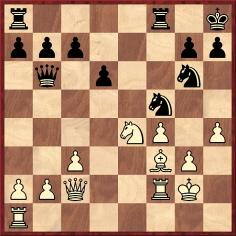
21 Re1 Ne3+ 22 Rxe3 Qxe3 23 Re2 Qb6 24 Ng5 Rf6 25 h5 Nf8 26 Bd5 c6 27 Nf7+ Kg8 28 Nh6+ Kh8 29 Nf7+ Kg8 Drawn.
(8118)
C.N. 8118 mentioned the rarity of blindfold games played by Tartakower. Below is a specimen (from a five-board display) published on page 138 of Schachjahrbuch für 1909 by Ludwig Bachmann (Ansbach, 1909):
Savielly Tartakower – Häusler
Augsburg, 14 September 1909
Queen’s Gambit Declined
1 d4 d5 2 c4 e6 3 Nc3 c5 4 cxd5 exd5 5 e4 dxe4 6 d5 Bf5 7 g4 Bg6 8 Bf4 Bd6 9 Qa4+ Kf8 10 Bxd6+ Qxd6 11 O-O-O Qf4+ 12 Rd2 Nf6 13 h4 h5 14 Nh3 Qxg4 15 Rg1 Qd7 16 Qc4 Na6
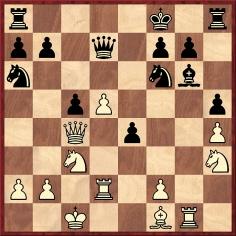
17 Rxg6 fxg6 18 Ng5 Re8 19 Bh3 Ng4 20 Ne6+ Kg8 21 Qxe4 Qf7 22 f3 Nf6 23 Qc4 Nc7 24 Ng5 Re1+ 25 Kc2 b5 26 Nxf7 (The Schachjahrbuch does not mention the possibility of 26 Qxc5.) 26...bxc4 27 Nxh8 Kxh8 28 d6 Na6 29 a3 Re8 30 d7 Rd8 31 Ne4 Nxe4 32 fxe4 Kg8 33 e5 Kf8 34 e6 Nc7 35 Rf2+ Ke7 36 Rf7+ Kd6 37 e7 Rxd7 38 e8(Q) Nxe8 39 Rxd7+ Ke5 40 Re7+ Resigns.
(8418)
Concerning the time-limit at Nottingham, 1936, the following report appeared on page 71 of Schach-Grossturnier Nottingham 1936 by Hans Kmoch (Vienna, 1938):
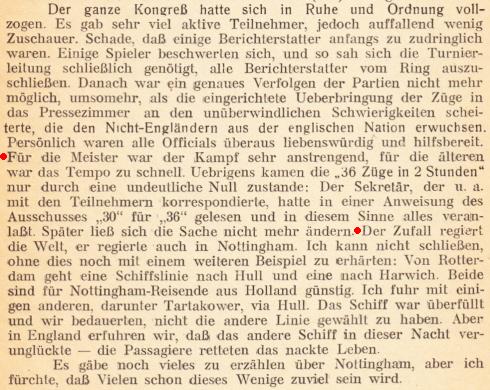
(8161)
Tartakower’s account of the journey to Nottingham from Rotterdam, referred to by Kmoch at the end of the previous item, was given in an article on pages 330-331 of the November 1952 Chess Review:
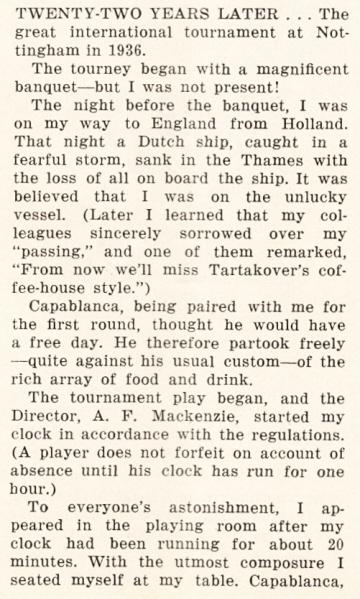
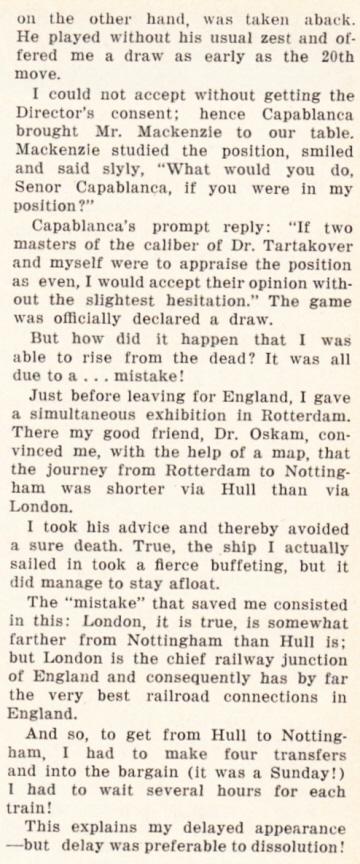
When A. Soltis availed himself of that narrative (without specifying his source, naturally) on pages 162-163 of The Great Chess Tournaments and Their Stories (Radnor, 1975) Capablanca’s phrase ‘without the slightest hesitation’ became ‘with the slightest hesitation’.
It is, though, difficult to reconcile Tartakower’s account (including its reference to ‘Sunday’) with that of W.H. Watts on page xviii of Alekhine’s book on Nottingham, 1936:
‘The Opening Ceremony took place in the main Assembly Hall of the University at noon on 10 August; there was a very large attendance, all the masters, with the exception of Capablanca, who was indisposed, being present.’
The full schedule is given below from a 16-page ‘General Information’ brochure on Nottingham, 1936:
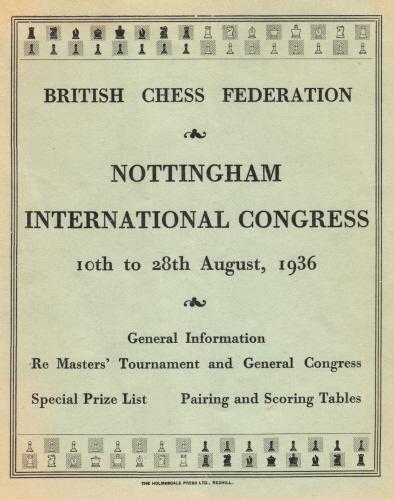
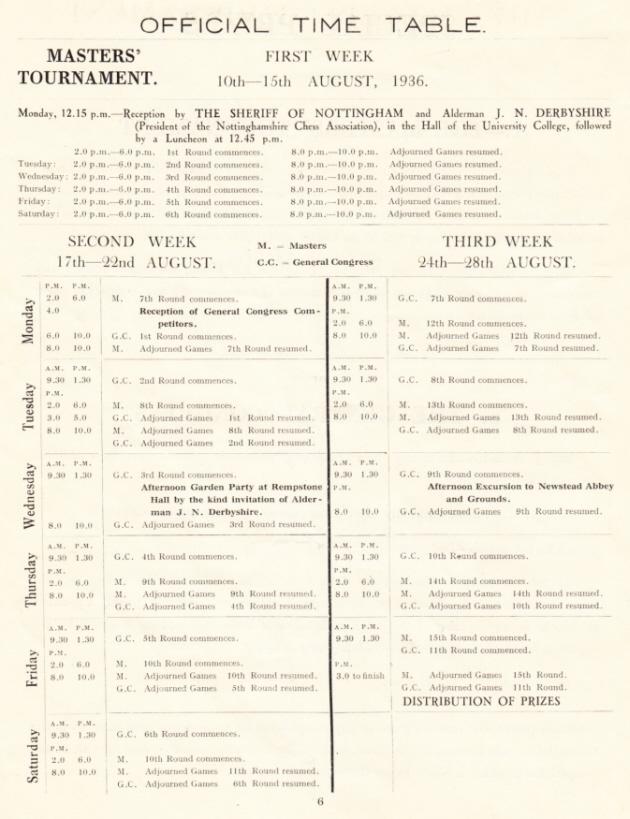
On the subject discussed in C.N. 8161, the brochure contains no information about the time-limit. Alekhine’s tournament book (see page 1) confirms that it was indeed 36 moves in two hours, and at the bottom of the score-sheets for the event ‘two hours’ was stipulated after move 36. In the late 1980s the Manhattan Chess Club sent us photocopies of a number of Capablanca’s score-sheets, including this one:
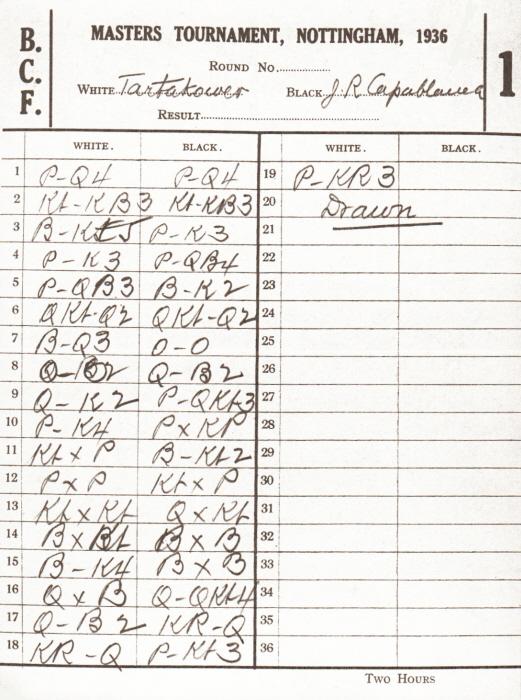
There was no reference to any special circumstances (relating to Tartakower’s late arrival) in Capablanca’s notes to this game on page 3 of the Russian Tournament Bulletin (special issue of 64), No. 2, 17 August 1936. For an English translation, see page 277 of our book on the Cuban.
(8162)
Further to C.N. 8162, with its reference to A. Soltis, another writer who used the Tartakower article (for its account of a conversation with Capablanca in 1938) without identifying any source was R.E. Fauber, on page 60 of Chess Digest Magazine, March 1973 and on page 165 of his book Impact of Genius (Seattle, 1992).
On page 331 of the November 1952 Chess Review Tartakower wrote concerning the Cuban:
‘On that occasion, he remarked, “I relied too much on intuition and didn’t prepare properly for my world championship match with Alekhine in 1927. I paid the penalty.”
“Thereafter I tried to avoid intuitive play as much as possible, and this cost me many a valuable point.
“So intuition was at fault?”, I inquired.
“Intuition”, Capablanca replied, “is a wonderful means to an end; but intuition should not be made the end of all the means that intelligence places at our command. This may seem like one of the paradoxes you love so dearly; but it is, just the same, a tragic truth which I have felt very deeply in the course of a career which has been rich in kaleidoscopic changes.”’
The full passage (including a reference to racehorses which was quoted in C.N. 2437 and on page 172 of A Chess Omnibus):
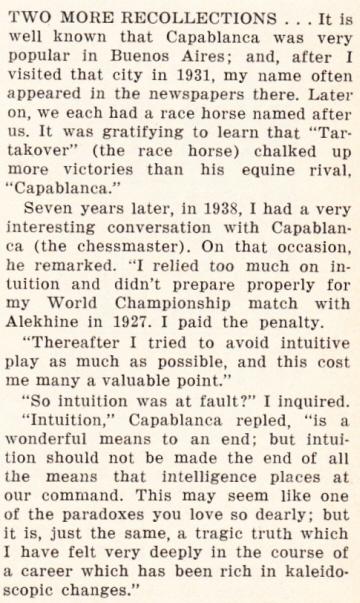
(8163)
As shown in C.N. 8162, Tartakower stated on page 331 of the November 1952 Chess Review that he arrived 20 minutes late for his first-round game against Capablanca in Nottingham (10 August 1936), having travelled from Rotterdam via Hull. By choosing that route, he claimed, he had ‘avoided a sure death’, because the Dutch ship to London that he had envisaged taking ‘sank in the Thames with the loss of all on board’.
Olimpiu G. Urcan has examined a number of British newspapers of the time and has found reports of only one major accident on the Thames during the relevant period, i.e. on 9 August 1936. It involved Batavier IV, a Dutch steamer from Rotterdam, but the only casualty was its cargo of fruit.
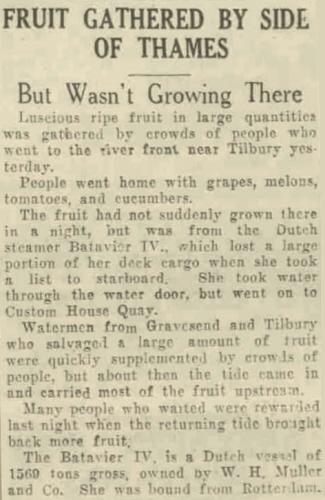
Aberdeen Journal, 10 August 1936, page 7
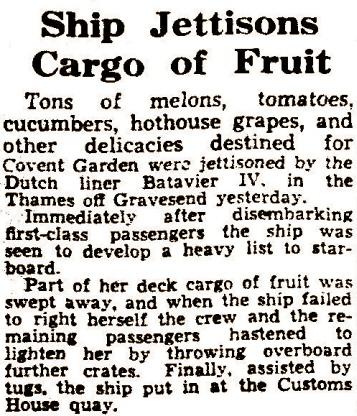
Daily Mail, 10 August 1936, page 7

Daily Mail, 11 August 1936, page 5
Mr Urcan also notes that the report on the first round of play on page 1 of the Nottingham Evening Post, 10 August 1936 does not indicate any surprising late arrival by Tartakower:

David Abrams (Syracuse, NY, USA) writes:
‘Tartakower’s account of his game with Capablanca, as quoted in Chess Review, November 1952, includes an assertion that Capablanca “offered me a draw as early as the 20th move”. Yet Capablanca’s own score-sheet ends with White’s (Tartakower’s) 19th move, followed by the word “Drawn”.
Assuming that the players followed protocol and offered draws only after their moves had been played (and recorded), it would appear from Capablanca’s score-sheet that it was Tartakower himself who offered the draw – unless Capablanca never recorded his 19th move on the score-sheet.
Are you able to clarify this matter?’
As regards the moves played, we have found no contemporary source which contradicts what Capablanca wrote on his score-sheet, i.e. that the last move of the game was Tartakower’s 19 h3.
On page 1 of Alekhine’s tournament book, the controller, A.J. Mackenzie, wrote:
‘Capablanca, who has missed the opening luncheon through slight indisposition, is not in the mood for extending himself against Tartakower and draws in 19 moves. For the first time, in England at any rate, the FIDE rule that no game shall be agreed drawn in less than 30 moves is done away with, since the rule is so easily evaded when desired.’
The book did not include the rules under which the tournament took place, but an international code had been adopted by FIDE and the British Chess Federation a few years previously. The full text is reproduced in a new feature article The Laws of Chess (1931). It will be observed from Article 16(d) on page 265 that the reference to games being drawn ‘by mutual agreement’ incorporated no restrictions as to whether the ‘Player’ or the ‘Opponent’ had to make the draw offer.
(8167)
An early victim of the Great War was a younger brother of Savielly Tartakower, Arthur, as reported on page 58 of the February 1915 Deutsche Schachzeitung:
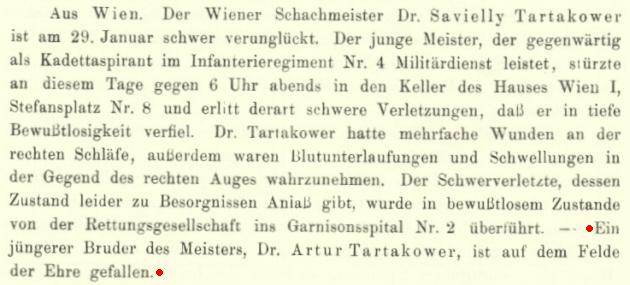
Further details about him were given on page 24 of the January 1918 issue:

As recorded on page 23 of the Hamburg, 1910 tournament book, Arthur Tartakower finished in the middle of group five of the Hauptturnier B. His defeat of the joint winner, ‘Jankowitsch’ (Boris Yankovich), was given on pages 169-170:
1 e4 e5 2 Bc4 Nf6 3 d3 Bc5 4 Nc3 d6 5 f4 Bxg1 6 Rxg1 Bg4 7 Qd2 exf4 8 Qxf4 Nbd7 9 h3 Bh5 10 g4 Bg6 11 h4 h5 12 g5 Ng4 13 Bd2 Nge5 14 O-O-O a6 15 Be3 O-O 16 Bb3 Ng4 17 Rxg4 hxg4 18 Qxg4 Ne5 19 Qe2 Kh8 20 d4 Nc6 21 h5 Bh7 22 g6 Bg8 23 Qh2 Na5
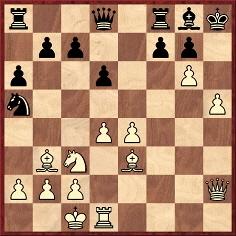
24 h6 Nxb3+ 25 axb3 Qd7 26 hxg7+ Kxg7 27 Bh6+ Kf6 28 Qh4+ Ke6 29 d5+ Ke5 30 Qf4 mate.
Unsurprisingly, the FatBase database ascribed the victory to Savielly Tartakower.
(8198)
Tomasz Lissowski (Warsaw) reports that Arthur Tartakower is buried in Kotowice Cemetery.Source, found by Marek Lis (Opoczno, Poland): page 251 of Wielka Wojna na Jurze by P. and K. Orman (Cracow, 2008).
(8220)
Addition on 25 October 2022:
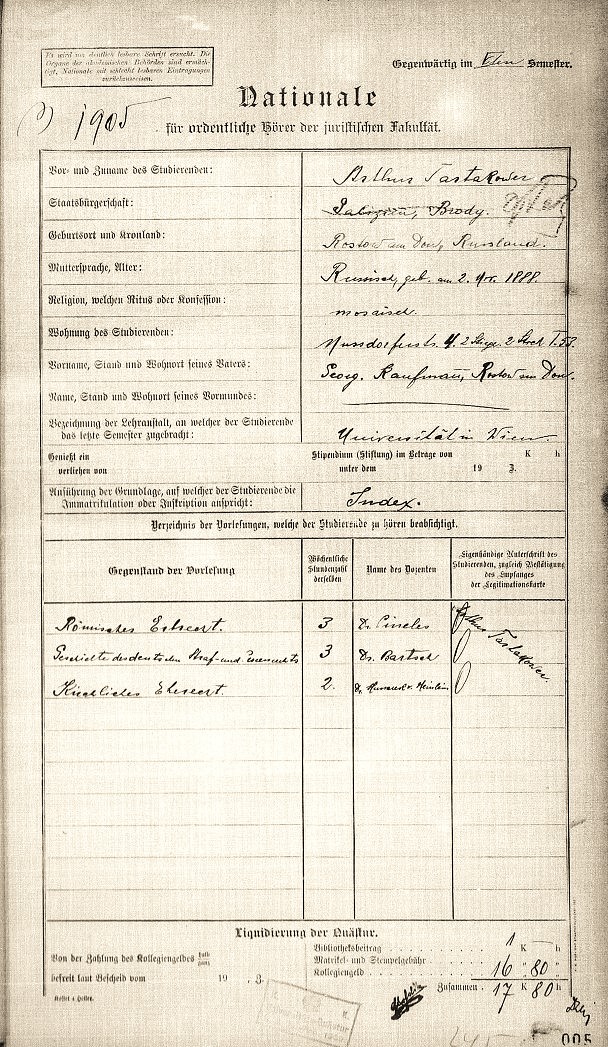
The above document has been provided by Michael Lorenz (Vienna), who writes:
‘This is Arthur Tartakower’s “Nationale” from the law faculty of the University of Vienna from the Summer semester 1909 (“im V Semester”). It documents his date of birth as 2 November 1888 (“am 2 9er 1888”). Arthur Tartakower does not appear to have acquired a doctorate.’
On page 313 of the July-August 1934 issue of Les Cahiers de l’Echiquier Français Tartakower wrote that Barnes’ Opening (1 f3) could gain recognition if two ‘arbitrary’ chess rules were abolished: the double pawn-move and castling.
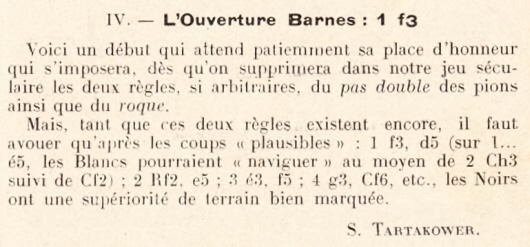
(8240)
A detail of Rotlewi from the Carlsbad, 1911 group photograph (Wiener Schachzeitung, September-October 1911, pages 304-305) was shown in C.N. 8524. Below from the same source is Tartakower:
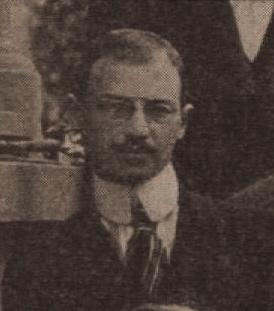
(8574)
From an article about Tartakower by Genna Sosonko on page 42 of the 6/2010 New in Chess:
‘Chessplayers are familiar with the so-called pearls of eastern wisdom that were dreamt up by Tartakower. One of the most well known of them goes: “There are players who are weak and don’t know that they are weak: these are ignoramuses – avoid them! There are players who are weak and know that they are weak: these are smart – help them! There are players who are strong and don’t know that they are strong: these are modest – respect them! There are players who are strong and know that they are strong: these are chess sages – follow them!”’
C.N.s 56, 263, 485 and 1200 discussed this quotation, including the unresolved question of whether it originated with Sir Richard Burton in the late nineteenth century.
As regards Tartakower, this paragraph was published on page 22 of his booklet Am Baum der Schacherkenntnis (Berlin, 1921):
‘Arabische Weisheit. Es gibt Spieler, die schwach spielen und nicht wissen, daß sie schwach spielen: das sind Ignoranten – meide sie! Es gibt Spieler, die schwach spielen und wissen, daß sie schwach spielen: das sind Einsichtige – hilf ihnen! Es gibt Spieler, die stark spielen und nicht wissen, daß sie stark spielen: das sind Bescheidene – achte sie! Es gibt Spieler, die stark spielen und wissen, daß sie stark spielen. Das sind die Schachweisen – folge ihnen!’
The same quotation (introduced not by ‘Arabische Weisheit:’ but by ‘Ein morgenländischer Spruch lautet’) appeared on page 43 of Tartakower’s Die Hypermoderne Schach (Vienna, 1924), followed by a brief additional paragraph:
‘Capablanca weiß, und er weiß, daß er weiß. – Wollen wir ihm folgen? ...’ [‘Capablanca knows, and he knows that he knows. – Do we wish to follow him? ...’]
Harry Golombek gave the saying in two chess columns in the Review section of The Times (24 May 1969, page 21, and 30 September 1972, page 10), and in the latter he added:
‘Fischer belongs to this last category, and the number of his followers among masters and amateurs alike is inevitably enormous. Few if any of these doubt that he is the strongest player the world has ever seen and, even if they cannot achieve his results, at least they will imitate his methods of play. ... I entertain the fervent hope that Fischer’s healthily direct approach to the game will be imitated by exactly those players who employed the negative methods of Petrosian when he was world champion. In chess, as in most of life’s pursuits, fashion and success go hand in hand.’
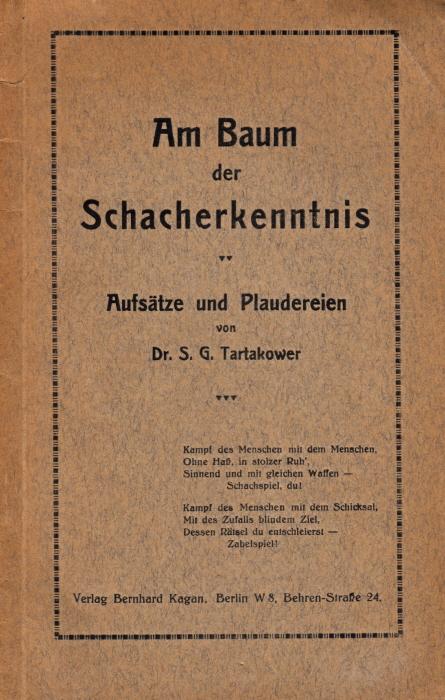
‘He was the wittiest man I ever met’, wrote Harry Golombek about Savielly Tartakower on page 65 of Chess Treasury of the Air by Terence Tiller (Harmondsworth, 1966). Some bons mots were given on subsequent pages.
Below is an extract from part one of Edward Lasker’s article ‘The New York Tournament of 1924’, on page 185 of the March 1974 Chess Life & Review:
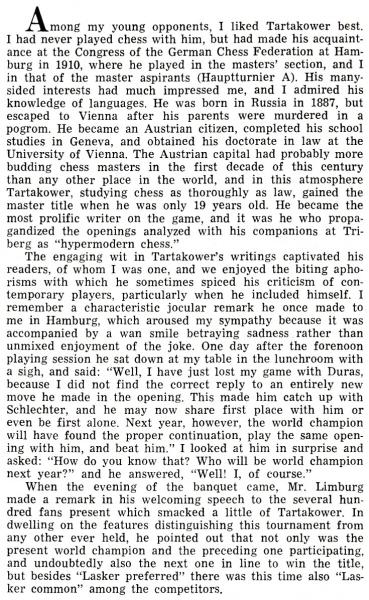
(8699)
From page 160 of The Most Instructive Games of Chess Ever Played by Irving Chernev (New York, 1965):
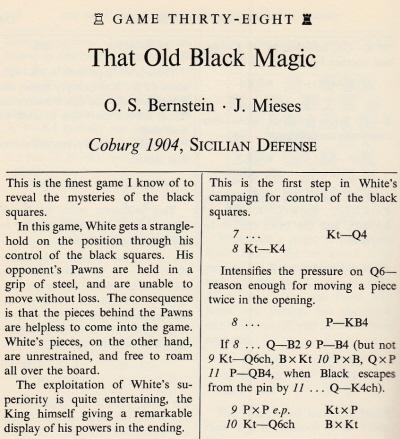
In his annotations to the game (pages 160-165) Chernev did not indicate explicitly which move or moves caused Black’s defeat. See too his notes in Logical Chess Move by Move (New York, 1957).
Below is the game as it appeared with Georg Marco’s annotations on pages 105-109 of the Coburg, 1904 tournament book, which Marco edited with Paul Schellenberg and Carl Schlechter. (The Vorwort on page iii specified that Marco annotated the Bernstein v Mieses game.)
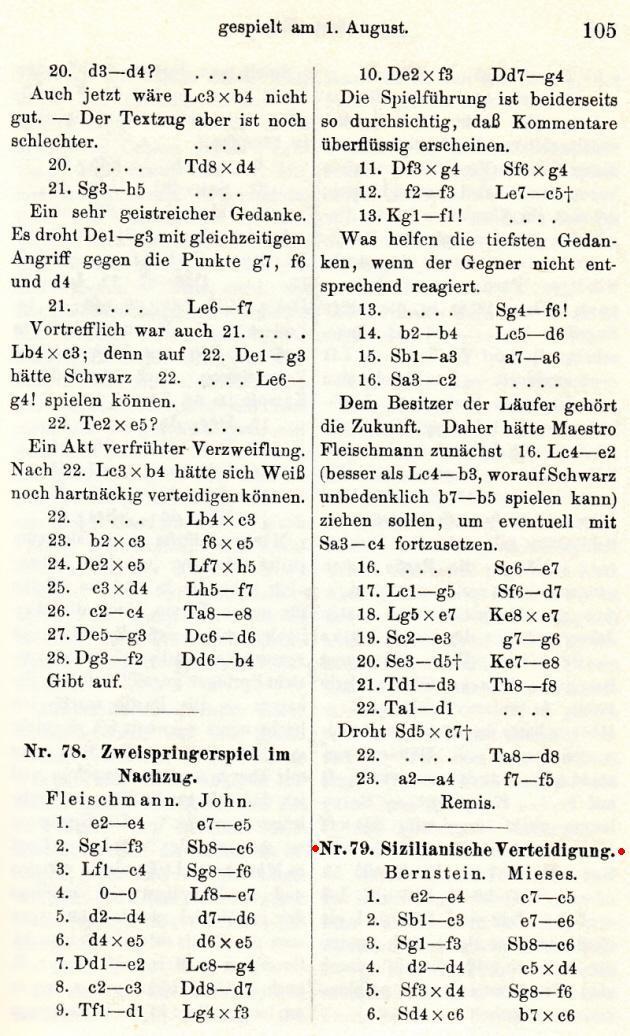
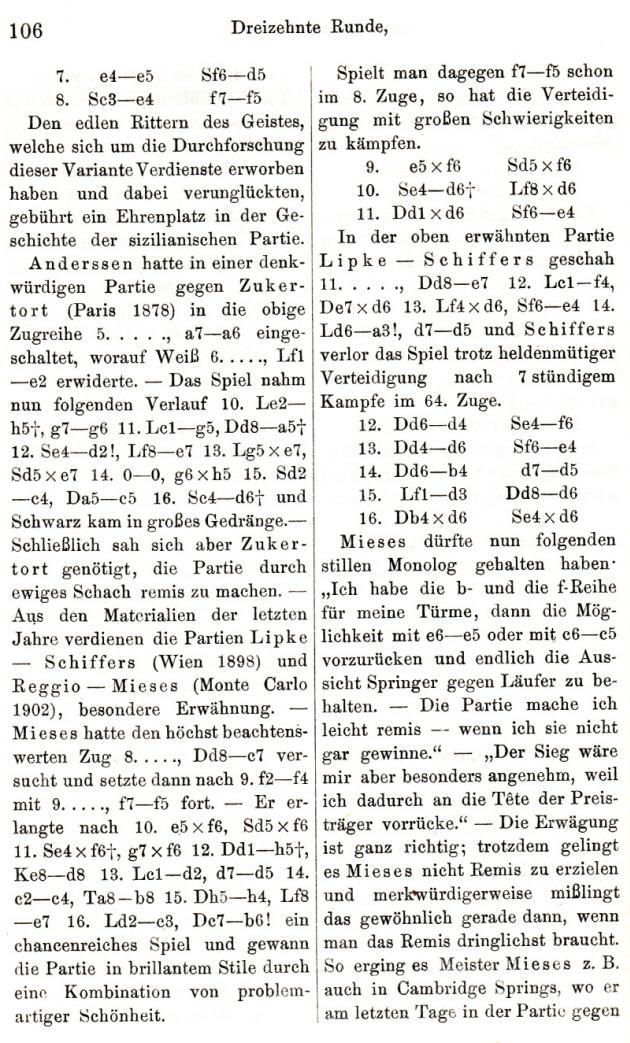
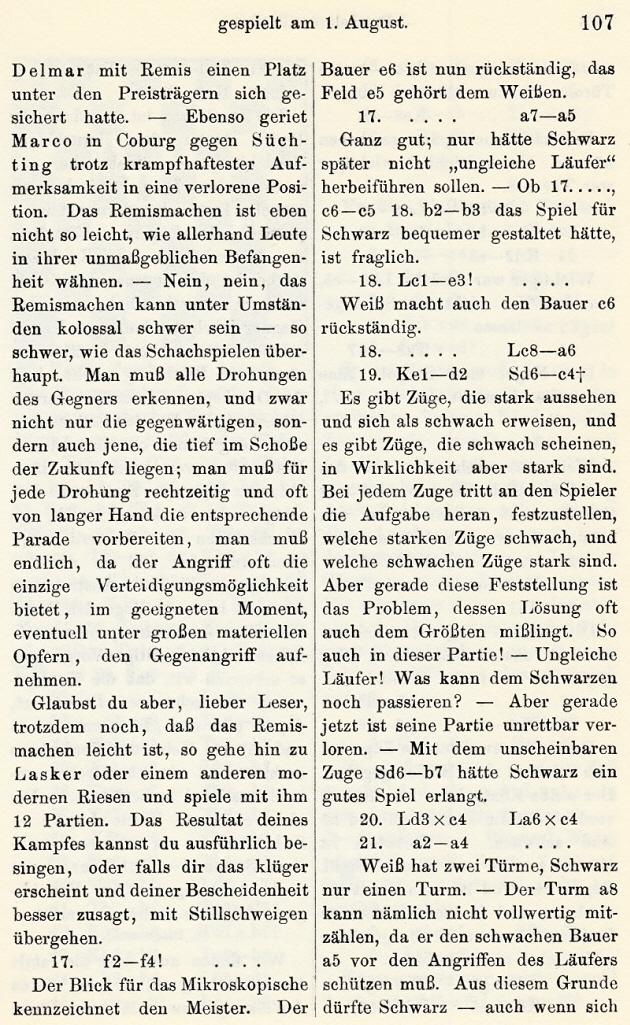
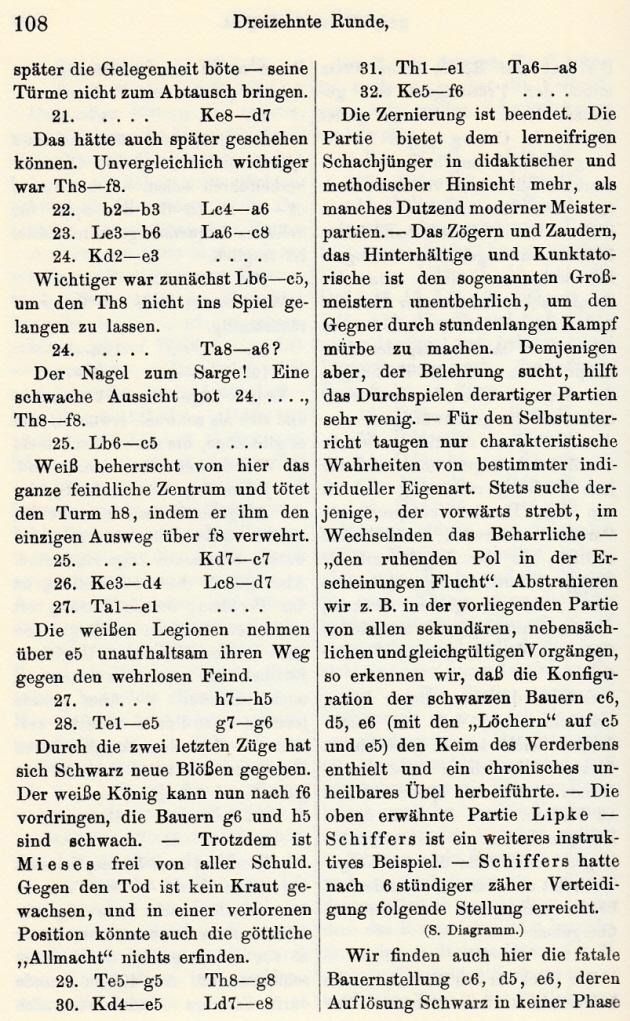
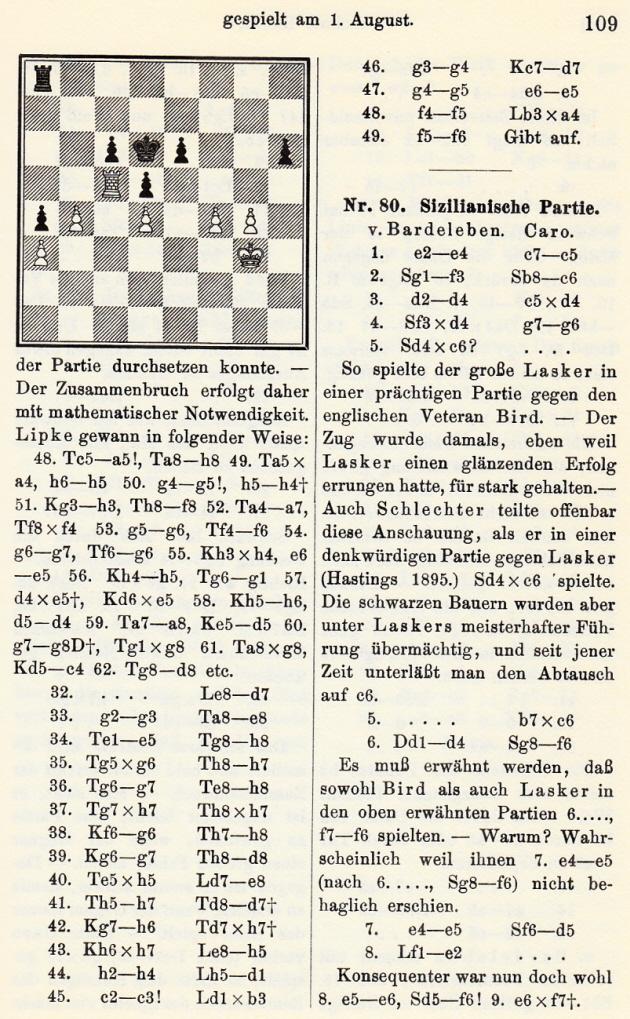
The notes were reproduced on pages 361-364 of the December 1905 Wiener Schachzeitung.
Next, Tartakower’s annotations from pages 36-39 of his monograph on Bernstein, Moderne Schachstrategie (Breslau, 1930):
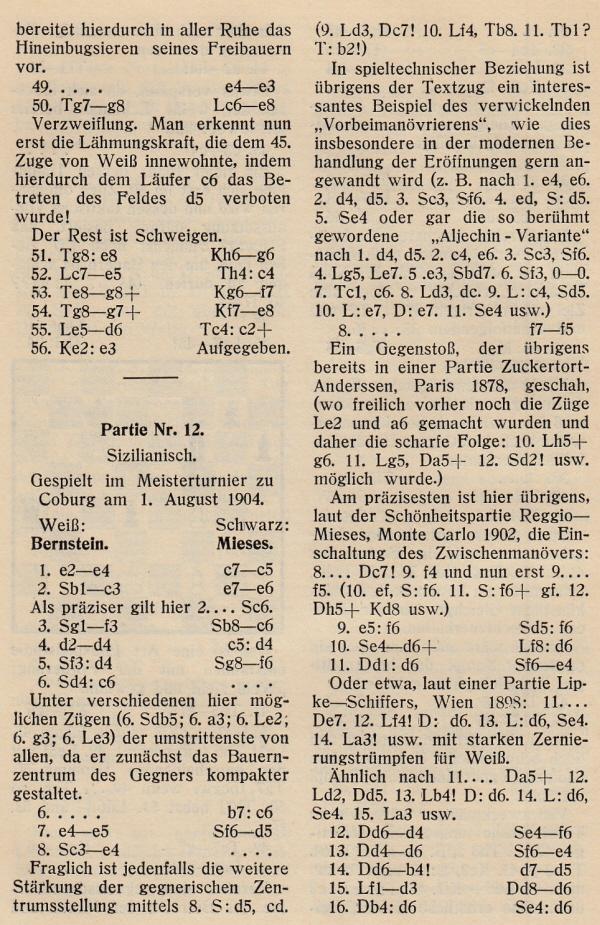
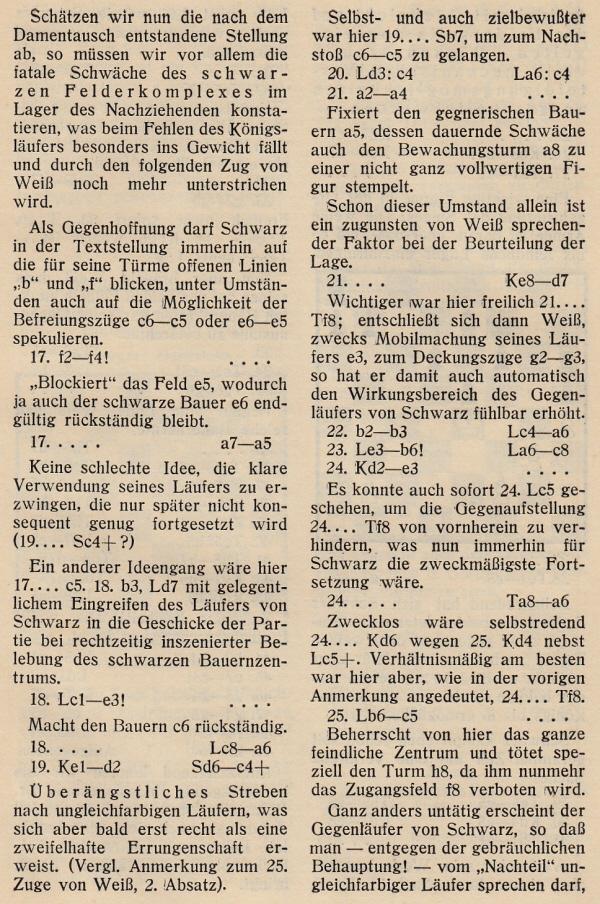
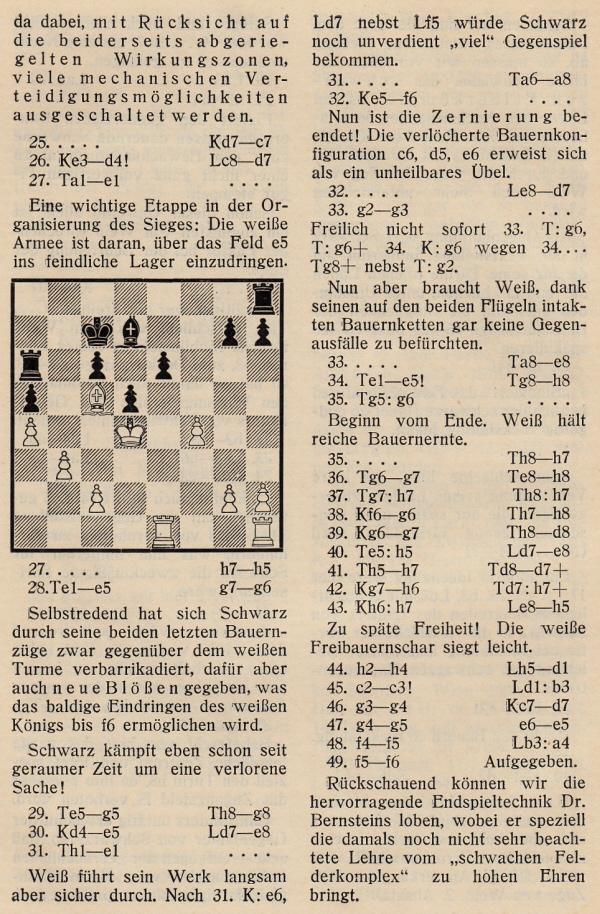
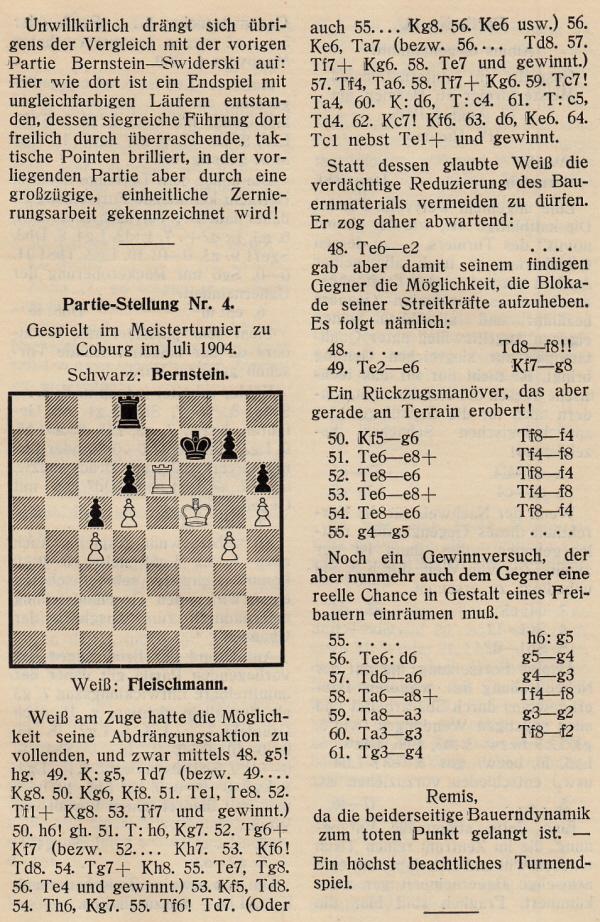
The score according to the above German-language sources was: 1 e4 c5 2 Nc3 e6 3 Nf3 Nc6 4 d4 cxd4 5 Nxd4 Nf6 6 Nxc6 bxc6 7 e5 Nd5 8 Ne4 f5 9 exf6 Nxf6 10 Nd6+ Bxd6 11 Qxd6 Ne4 12 Qd4 Nf6 13 Qd6 Ne4 14 Qb4 d5 15 Bd3 Qd6 16 Qxd6 Nxd6 17 f4 a5 18 Be3 Ba6 19 Kd2 Nc4+ 20 Bxc4 Bxc4 21 a4 Kd7 22 b3 Ba6 23 Bb6 Bc8 24 Ke3 Ra6 25 Bc5 Kc7 26 Kd4 Bd7 27 Rae1 h5 28 Re5 g6 29 Rg5 Rg8 30 Ke5 Be8 31 Re1 Ra8 32 Kf6 Bd7 33 g3 Rae8 34 Ree5 Rh8 35 Rxg6 Rh7 36 Rg7 Reh8 37 Rxh7 Rxh7 38 Kg6 Rh8 39 Kg7 Rd8 40 Rxh5 Be8 41 Rh7 Rd7+ 42 Kh6 Rxh7+ 43 Kxh7 Bh5 44 h4 Bd1 45 c3 Bxb3 46 g4 Kd7 47 g5 e5 48 f5 Bxa4 49 f6 Resigns.
The position after 26...Bd7:
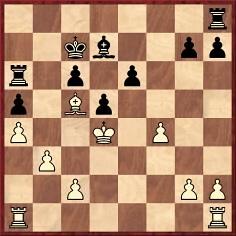
The Chernev books gave White’s 27th move as Rhe1 instead of Rae1.
A slightly different ending (without 46...Kd7) can also be found in some databases. Indeed, one database that we consulted offered three versions of the game, and none of them corresponded exactly to the moves in the tournament book.
As regards possible errors by Black, his 24th and 25th moves received question marks on page 45 of O.S. Bernstein (Grand maître international d’Echecs) by J. Cena:
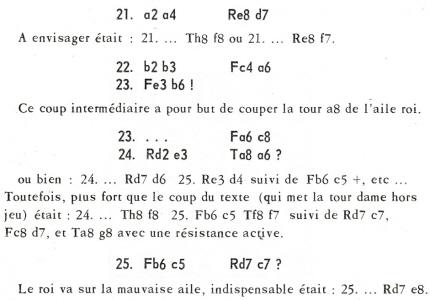
On the same page Cena gave 27 Rae1, and not 27 Rhe1. The privately-printed book contains no date or place of publication; it was listed for sale on page 83 of the March 1968 BCM.
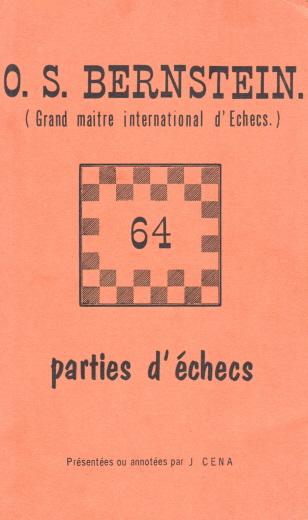
Moves 19-40 of the game (with 27 Rhe1) can be found on pages 43-44 of Positional Chess Handbook by Israel Gelfer (London, 1991). The only move criticized was 19...Nc4+, which Cena had passed over in silence.
In Logical Chess Move by Move (see, for instance, page 180 of the 1998 algebraic edition published by B.T. Batsford Ltd.), Chernev pointed out that at move 11/13 (taking account of a repetition of moves) Alekhine suggested ...Qb6. We are not aware that Alekhine ever annotated, or even mentioned, the Bernstein v Mieses game, but he commented on the position when it arose in Yates v Emanuel Lasker at New York, 1924. From page 186 of the tournament book:

Finally, concerning Bernstein’s 17 f4 Chernev wrote on page 161 of The Most Instructive Games of Chess Ever Played:
‘It was about moves of this sort that the great annotator Marco said, “An eye for the microscopic betokens the master”.’
The quote was also included in Logical Chess Move by Move. From the above annotations in the Coburg, 1904 tournament book it will be seen that Marco’s comment in German was, on page 107:
‘Der Blick für das Mikroskopische kennzeichnet den Meister.’
(8704)
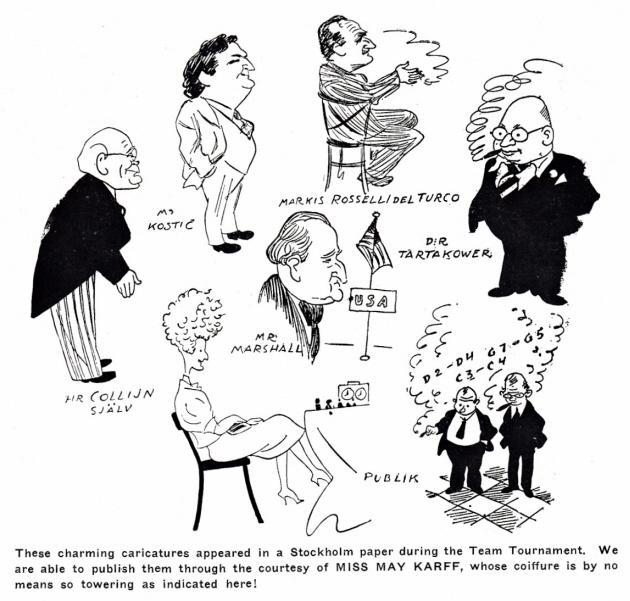
Chess Review, December 1937, page 277
(8756)
Following on from B.H. Wood’s critiques of The Chess Mind (C.N. 8824) and 500 Master Games of Chess (C.N. 8828), we show his review of My Best Games of Chess 1905-1930 by S.G. Tartakower (London, 1953), on page 113 of the March 1953 CHESS:
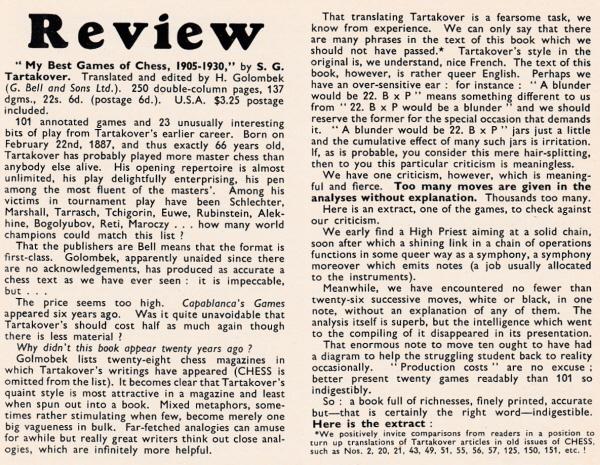
The extract referred to (given on pages 113-116) was the game Tartakower v Schlechter, St Petersburg, 1909.
(8839)
From page 41 of the London, 2007 edition of Kasparov’s How Life Imitates Chess:
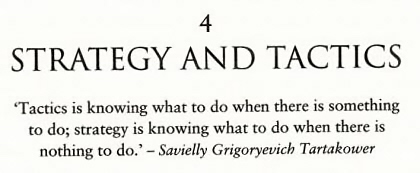
In the US edition (New York, 2007) this ‘Tartakower quote’ is in the heading to Chapter 3, on page 36. But did Tartakower make such a remark and, if so, where and when?
The earliest citation that we can currently offer is nothing better than a ‘once’ reference in an article about Fischer by Harold C. Schonberg on page SM63 of the New York Times, 23 February 1958:
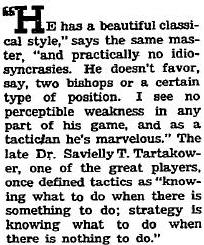
The article was reproduced on pages 49-55 of The Joys of Chess by Fred Reinfeld (New York, 1961), still with the initial T. for Tartakower’s second forename. Schonberg also ascribed the quote to Tartakower on page 160 of Grandmasters of Chess (Philadelphia and New York, 1972), and it is regularly seen in chess books, without a source. For instance, Gary Lane used it to fill a corner on page 57 of Prepare to Attack (London, 2010).
In his entry on aphorisms on page 16 of The Encyclopedia of Chess by Harry Golombek (London, 1977) Wolfgang Heidenfeld included the following:
‘“Whereas the tactician knows what to do when there is something to do, it requires the strategist to know what to do when there is nothing to do” (Abrahams).’
Heidenfeld gave no source, but we have found the remark on page 150 of Abrahams’ book Teach Yourself Chess (London, 1948), although with ‘strategian’ instead of ‘strategist’.
Furthermore, the following can be quoted from page 152 of The Handbook of Chess by Gerald Abrahams (London, 1965):
‘At many stages of the game the general choice is available; what to do now that there is no coercion? Epigrammatically, it may be said: Tactics are what you do when there is something to do. Strategy is what you do when there is nothing to do. That isolation, however, is rare. Strategy is a feature, albeit unobserved, of most good tactical play. It is latent – not patent.’
(8833)
See too Chess Strategy and Tactics.
(8839)
C.N. 1288 (see page 127 of Chess Explorations) quoted from page xvii of My Best Games of Chess 1905-1930 by S.G. Tartakower (London, 1953):
‘If one wishes to generalize one might say that as a rule it is towards his 45th year that an intellectual worker is most successful. In my own case it was not till 1930 that at long last I achieved a first prize in a big international tournament in which several great masters competed (at Liège).’
(8876)
See also The Peak Age for a Chessplayer.
Alan McGowan (Waterloo, Canada) notes a wide-ranging article by Tartakower on pages 209-215 of the August 1931 Magyar Sakkvilág:
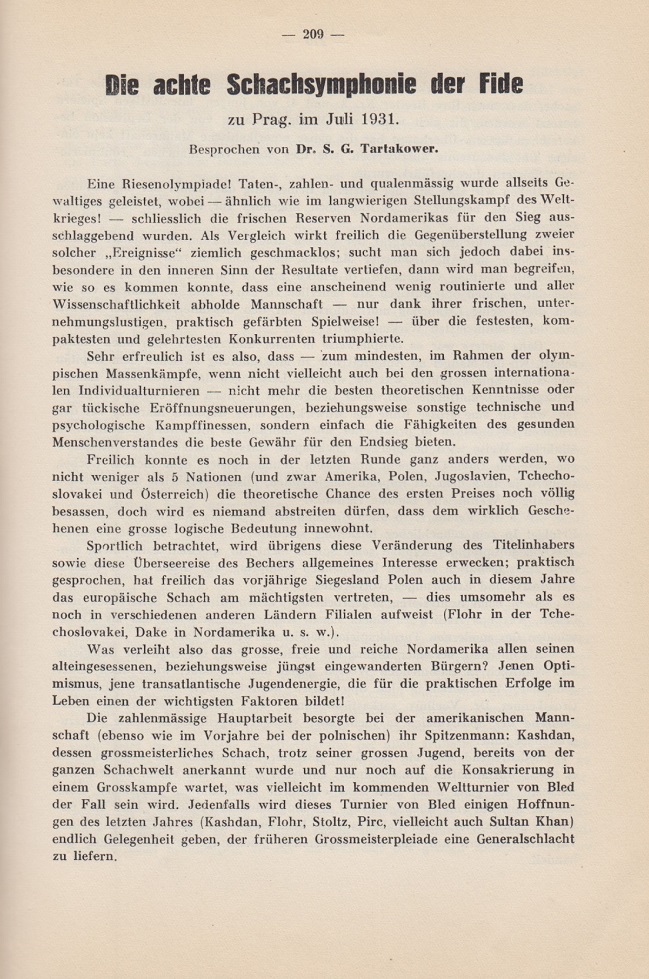
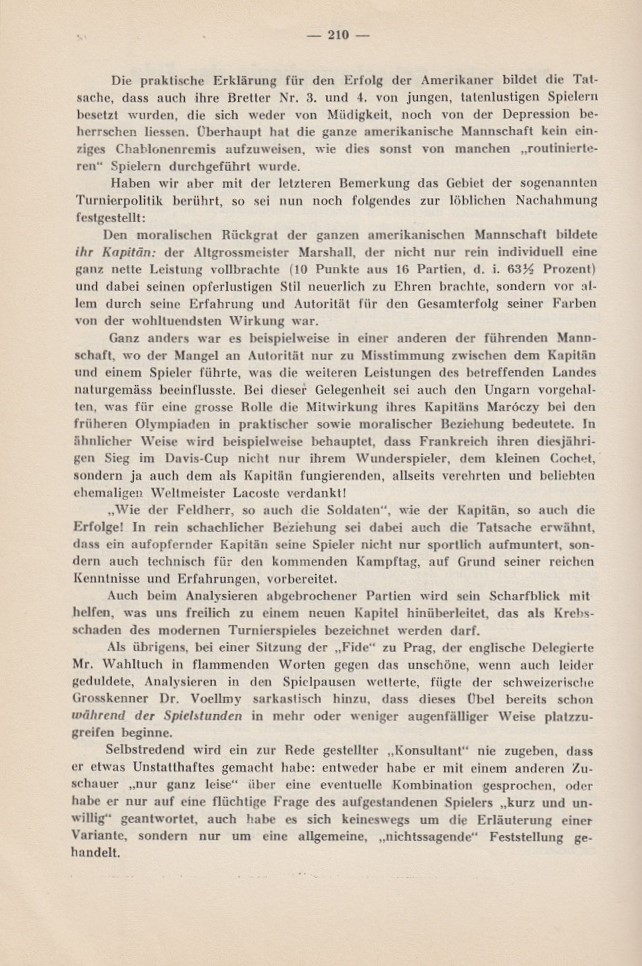
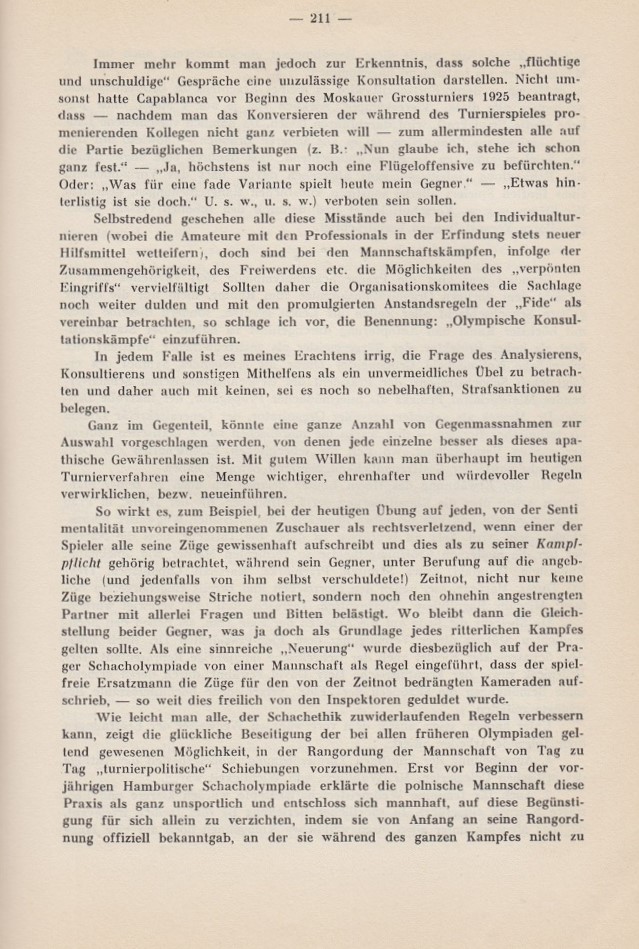
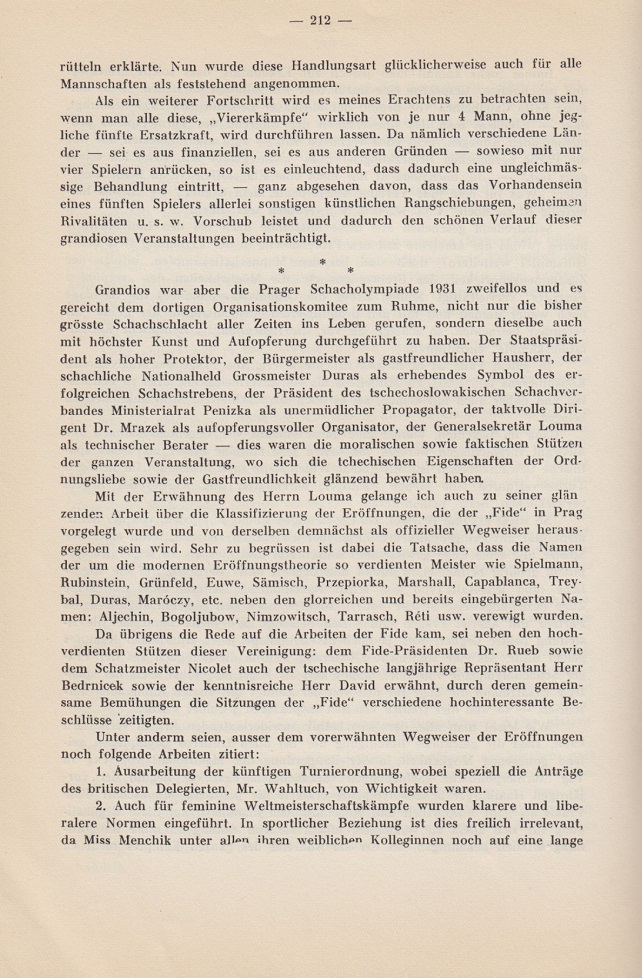
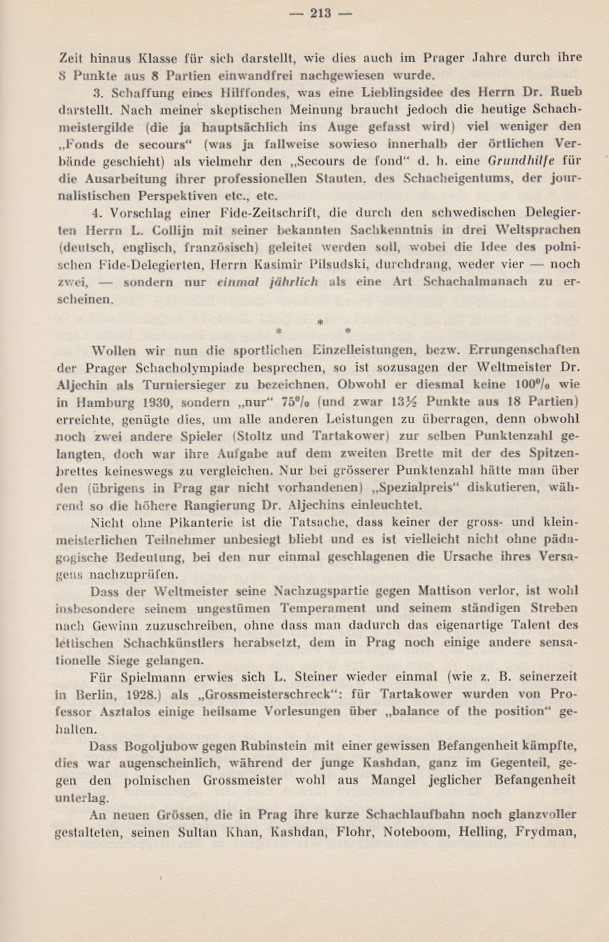
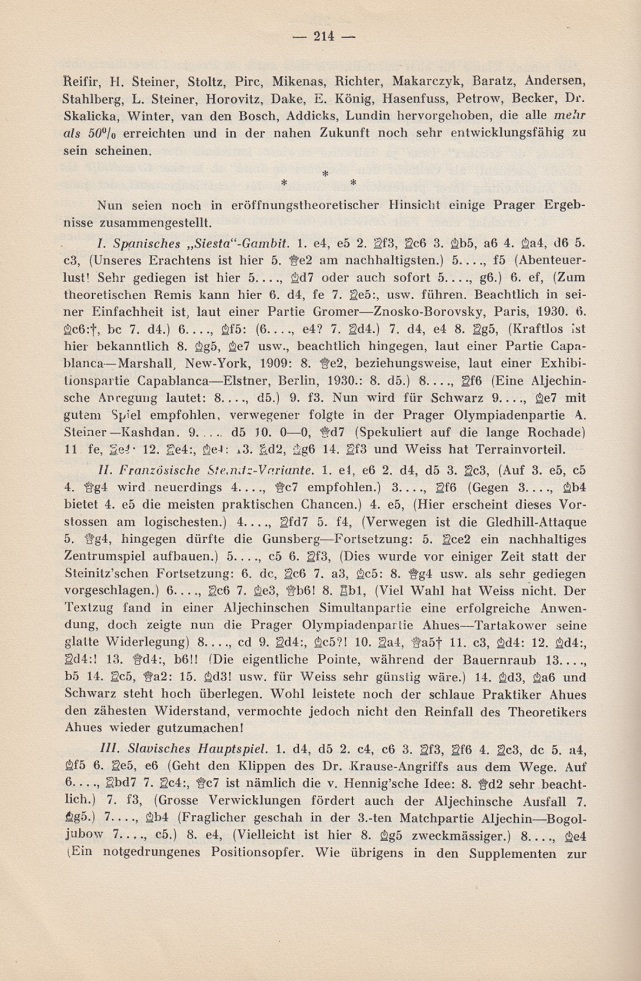
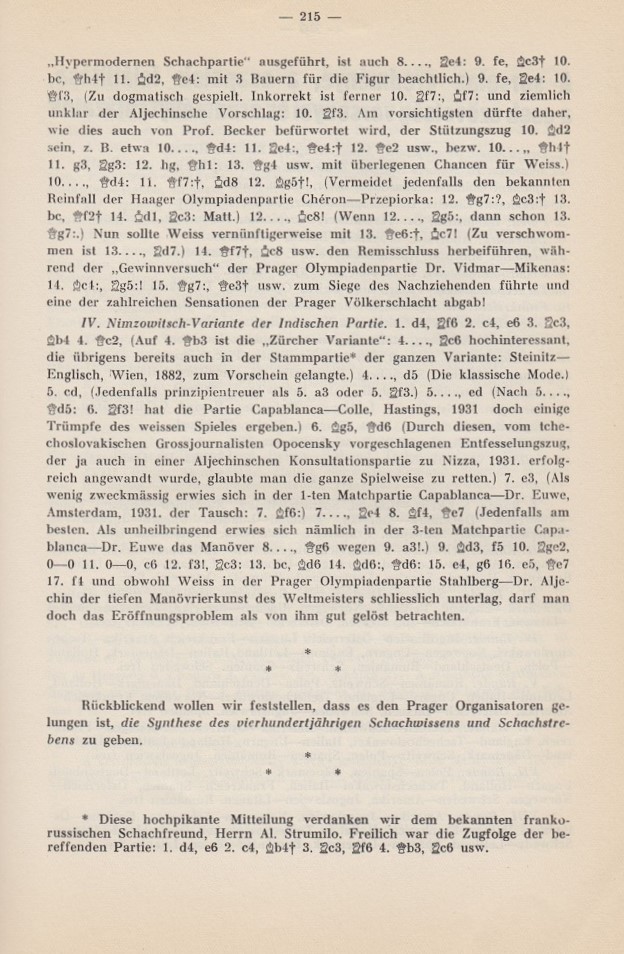
(8941)
Page 263 of Chess Explorations quoted a statement by Hans Kmoch that at Dubrovnik, 1950 Tartakower ‘had lost his zest, hinted occasionally at suicide’. Below is the complete passage from Kmoch’s article on pages 123-125 of the April 1956 Chess Review:
‘After the War, I met Tartakower at the Groningen tournament, Holland, 1946. He was the same. But, four years later, at Dubrovnik, Yugoslavia, he had entirely changed. Gone was his good figure as he had grown an enormous hypochrondium. Gone was much of his vivacity, gone, too, the facility and stirring anapest of his talk. Needless to say, his chess had deteriorated correspondingly. He had lost his zest, hinted occasionally at suicide. Only now and then did his grim sense of humor break through; for instance, on that hot day he had ordered iced water, got lemonade, instead – and washed his face with it.
They treated him very generously in Yugoslavia. But, when I met him shortly after in Paris, he again was penniless. Why? Well, just a petit jeu, you know. His case was hopeless.
Maybe, he should have married; but he used to claim to be too ugly for that, and too poor. According to one report, though, he did marry, shortly before his death.’
As ever, solid information is sought. ‘According to one report ...’ will never do.
Below is a page, inscribed by Tartakower, from our copy of Book of the Warsaw 1935 International Chess Team Tournament by Fred Reinfeld and Harold M. Phillips (New York, 1936):
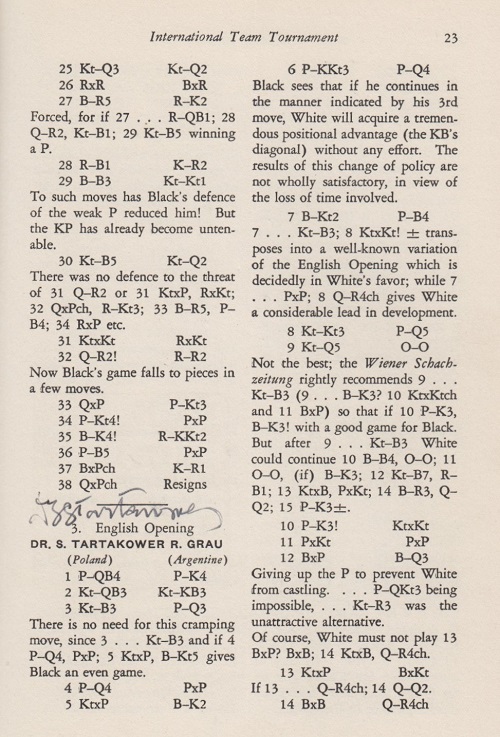
(8994)
See too C.N. 2556 in our ‘Chess Jottings’ feature article.
From page 52 of My Best Games of Chess 1931-1954 by S.G. Tartakower (London, 1956):

The full score of this exhibition game between Tartakower and Ramón Rey Ardid (Paris, September 1934): 1 d4 d5 2 c4 e6 3 Nc3 Nf6 4 Bg5 Be7 5 e3 h6 6 Bf4 Bd6 7 Bg3 b6 8 cxd5 exd5 9 Bd3 O-O 10 Nf3 Bb7 11 Rc1 Ne4 12 Bxe4 dxe4 13 Nd2 Qe7 14 Qb3 Bxg3 15 hxg3 Na6 16 O-O c5 17 Qa3 f5 18 dxc5 Rfd8 19 Nb3 Rac8 20 cxb6 Qxa3 21 bxa3 axb6 22 Nd4 Nc5 23 Nxf5 Ra8 24 a4 Ba6 25 Rfd1 Bd3 26 Rd2 Rd7 27 Rb2 Nxa4 28 Nxa4 Rxa4 29 Rc8+ Kh7 30 Rxb6 Rxa2 31 Nh4 Ra1+ 32 Kh2 Rb1 33 Re6 Rf7 34 Ng6 Rf6 35 Nf8+ Kg8 36 Nd7+ Kf7 37 Ree8 Rd6 38 Rf8+ Ke7 39 Nc5 Rd5 40 Rce8+ Kd6 41 Nxe4+ Bxe4 42 Rxe4 Rh5+ 43 Rh4 Ra5 44 Rg8 Raa1 45 Rd4+ Ke6 46 g4 Kf7 47 Rc8 h5 48 Rc7+ Kg8 49 Rd8+ Kh7 50 Rdd7 h4 51 Rxg7+ Resigns.
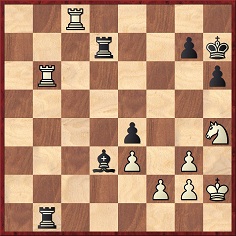
Position after 32...Rb1
Tartakower passed over 33 Re6 without comment, but in a letter on pages 329-330 of the December 1956 BCM Edgard Tchélébi of Beirut pointed out an immediate win for White with the ‘simple, but brilliant, move’ 33 Ng6, followed by 33...Rxb6 34 Nf8+ Kg8 35 Nxd7+ Kh7 36 Nxb6. Tchélébi concluded:
‘Really, an unbelievable treble chess blindness since neither Dr Rey (when playing 32...R-QKt8) nor Dr Tartakower (when answering 33 R-K6) nor still Dr Tartakower (when analysing the game) suspected this brilliant possibility.’
(9018)
When giving Tchélébi’s comments in C.N. 2990 we provided this assessment of Tartakower by Harry Golombek (BCM, March 1956, page 71):
‘He was a man who never committed an underhand action and who was more truly honest than anyone I have ever met. Sincerity and generosity were two marked features of his character and made me trust and revere him.’
On 25 May 1934 Tartakower lost a miniature to Rey Ardid in the first round of the Sitges tournament: 1 d4 d5 2 c4 e6 3 Nf3 Nf6 4 Nc3 c5 5 cxd5 Nxd5 6 g3 cxd4 7 Nxd4 Nxc3 8 bxc3 e5 9 Nb5 Qa5 10 Qd5 Nc6 11 Rb1 Be6 12 Nd6+ Bxd6 13 Qxd6 Rd8 14 Qa3
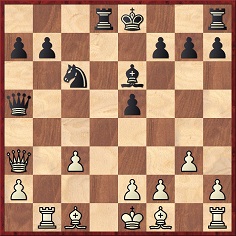
14...Nd4 15 Qb2 Bf5 16 Bd2 Nc2+ 17 Kd1 Na3 18 Qb4 Qd5 19 Rb2 Qxh1 20 White resigns.
Rey Ardid annotated it on pages 41-42 of his book Cien nuevas partidas de ajedrez (Saragossa, 1940), concluding that it was one of his best games:
‘Esta bonita miniatura, que ha sido publicada en revistas y crónicas de todo el mundo, es una de las mejores partidas del autor del presente libro.’
He had given a briefer set of notes on pages 189-191 of Los principios del ajedrez (Saragossa, 1939).
Tartakower annotated the game in depth on pages 984-986 of L’Echiquier, March-April 1935. His final remark was:
‘Quelle débâcle!’
(9019)
Ivor Goodman (Stevenage, England) asks about the move order in Tartakower v Atkins, London, 1922. He points out that after 34 Kc2 ...
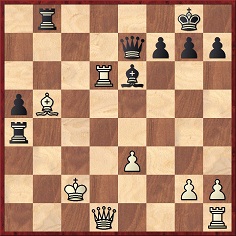
... databases have the continuation 34...Ra2+ 35 Kc3 Rc8+ 36 Bc6 Rxc6+ 37 Rxc6 Qb4+, whereas 34...Rc8+ 35 Bc6 Rxc6+ 36 Rxc6 Ra2+ 37 Kc3 Qb4+ is given on pages 106-107 of H.E. Atkins Doyen of British Chess Champions by R.N. Coles (London, 1952).
The game was widely published at the time, e.g. in the BCM, Chess Amateur and (with Brian Harley’s notes from page 4 of the Observer, 13 August 1922) American Chess Bulletin. It is in the London, 1922 tournament book by Maróczy with Amos Burn’s annotations from The Field, and it was later anthologized in A Treasury of British Chess Masterpieces by F. Reinfeld (London, 1950) and 500 Master Games of Chess by S. Tartakower and J. du Mont (London, 1952). In all of these publications the move order was 34...Ra2+ 35 Kc3 Rc8+ 36 Bc6 Rxc6+ 37 Rxc6 Qb4+.
Capablanca did not mention the game in his report on the ninth round of the London tournament on page 14 of The Times, 12 August 1922, but the same page had this paragraph ‘by our chess correspondent’:
‘The game between Tartakower and Atkins was the first example of this opening in the tournament, Atkins playing the KtxP variation on his fourth move. The middlegame was even. Tartakower castled on the queen’s side with a view to a king’s-side attack. Mr Atkins countered by an attack on the queen’s side, but again got short of time. However, he seemed to play all the better for it, for with only about 14 minutes to make as many moves he drove Tartakower’s king all over the board by a series of checks, and finally mated him on the 42nd move.’
(9070)
Some German-language websites ascribe to Tartakower, with no further particulars, this remark about the Evans Gambit: ‘Dieses blendende Angriffsspiel ist dafür erfunden worden, die Menschen zu dem Glauben zu veranlassen, dass die Schachkunst ein Geschenk der Götter ist.’
Readers are invited to add citations to the three shown below:
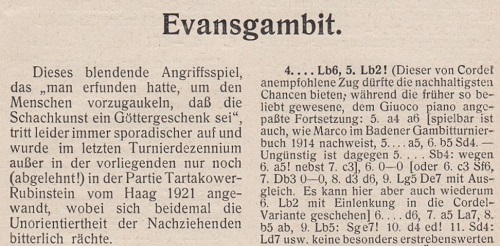
Die Hypermoderne Schachpartie by S. Tartakower (Vienna, 1924), page 173

La moderna partida de ajedrez by S. Tartakower, volume one (Buenos Aires, 1959), page 161
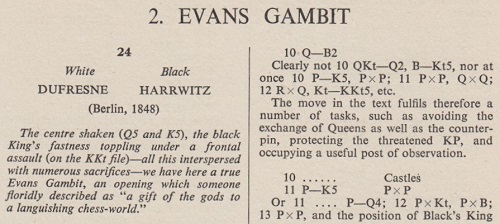
500 Master Games of Chess by S. Tartakower and J. du Mont (London, 1952), page 29.
(9113)
See too The Evans Gambit.
Further to the reference to Tartakower in Chess Grandmasters, it is worth noting that on the front cover and the title page of Bréviaire des échecs he was described as ‘Grand maître international’:
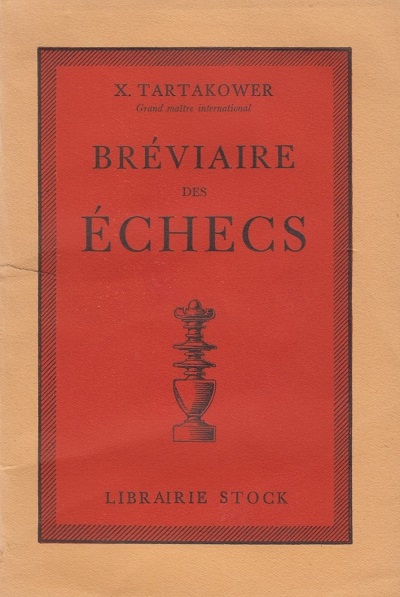
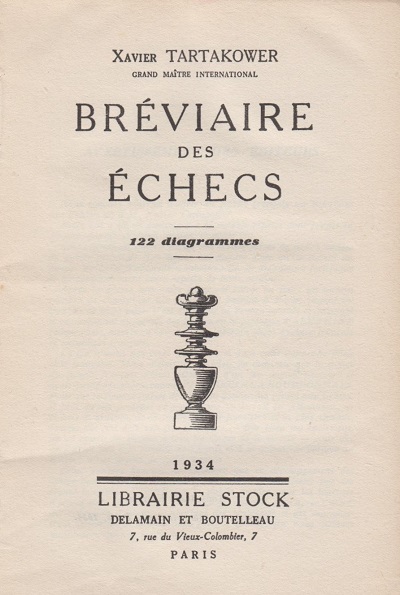
(9180)
C.N. 1947 (see page 203 of Kings, Commoners and Knaves) cited a report on page 296 of CHESS, 14 April 1936 that Tartakower ‘is the only person to have given a simultaneous exhibition in an aeroplane – between Budapest and Barcelona in 1929’.
From page 29 of the Chess Amateur, November 1929:
‘AERO-CHESS. The first reported display of chess in the air is credited to Dr Tartakower, who recently won three games, blindfold and simultaneous, during a flight from Budapest to Vienna. Dr A. Seitz acted as “teller”.’
(9198)
Dominique Thimognier has found a report on page 3 of El Mundo Deportivo, 29 September 1929:
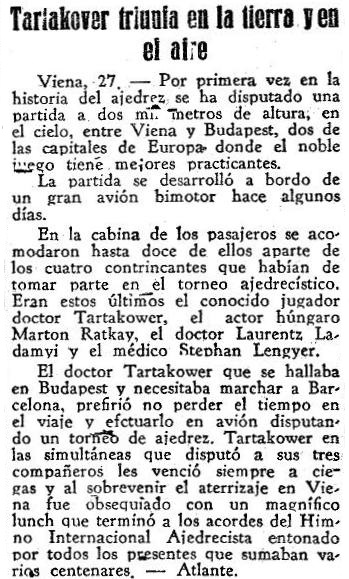
Thus Tartakower’s flight was from Budapest to Vienna. As noted on page 98 of his book on the Budapest, 1929 tournament, the last round was on 16 September. The Barcelona tournament began eight or nine days later, as shown, for instance, in the report by Tartakower on pages 39-49 of Kagans Neueste Schachnachrichten, February 1930.
(9243)
From page 313 of the 14 May 1939 CHESS:
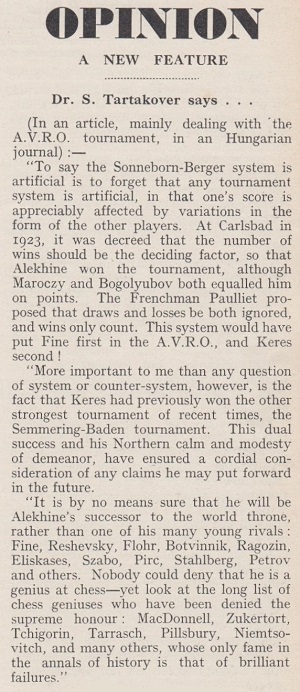
Before any examination of details (e.g. the fact that Alekhine and Bogoljubow both had nine wins at Carlsbad, 1923) we should like to see the original text in the ‘Hungarian journal’.
(9224)
From page 128 of Wonders and Curiosities of Chess by Irving Chernev (New York, 1974):
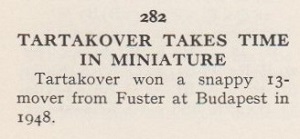
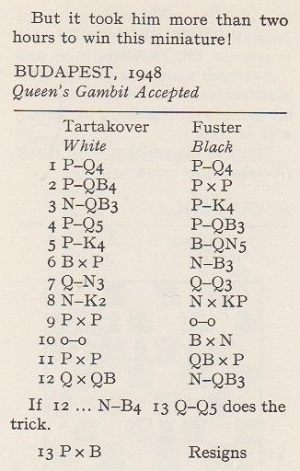
There was a different slant on page 285 of Chess World, 1 December 1948:
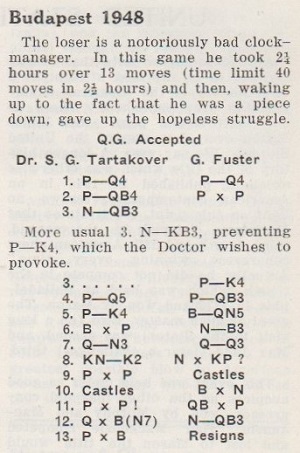
(9339)
On pages 120-122 of the May 1946 issue of Le monde des échecs Tartakower annotated the game doddorf v Cortlever from the 1939 International Team Tournament in Buenos Aires. His concluding notes:
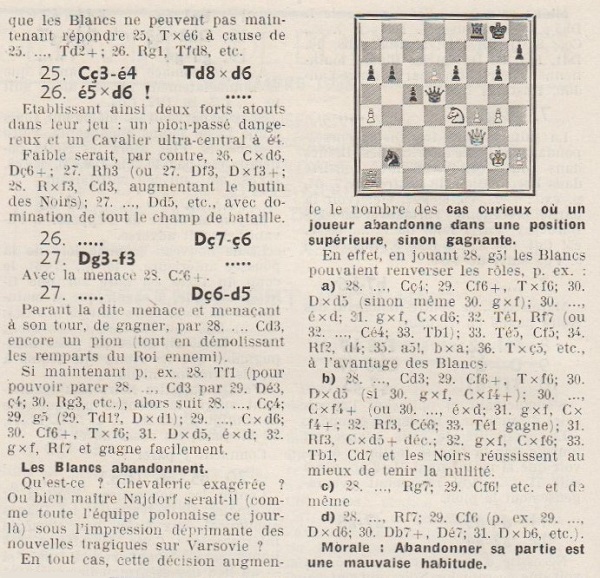
The game was also given on pages 226-227 of Chess World, 1 November 1946, under the title ‘Resigns??’. After quoting Tartakower’s final note (including ‘Moral: Resigning is a bad habit’), Purdy commented:
‘We hope beginners will not use Dr Tartakower’s witticism as an excuse for dragging on hopelessly lost games. Friendly games, by the way, should be resigned earlier than match games. By resigning quickly, you give time for another game – more fun and more practice.’
(9400)
An addition from Dominique Thimognier is the conclusion of Cukierman v Tartakower, Paris, 1939, annotated by the latter on pages 102-103 of La Stratégie, July 1939:
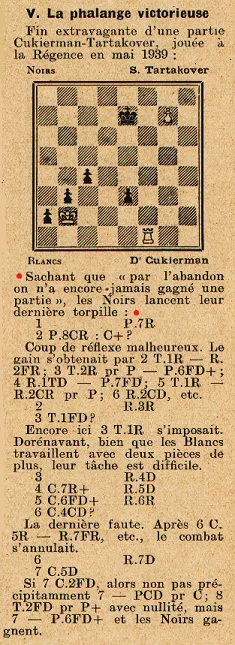
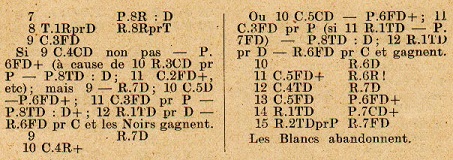
(9867)
Tartakower is often attributed the remark that it is better to sacrifice the opponent’s pieces, but on what basis?
On page 1 of the New York Times, 16 February 1927 Capablanca wrote about Vidmar:
‘In London, in 1922 (where from the beginning he was a contender for chief honors), while talking about one of the weaker participants, he made the following typical remark:
“He has not learned yet to sacrifice his opponents’ pieces instead of his own.”
He meant, of course, that while a good many players will always look for a chance to sacrifice something in order to obtain a so-called brilliant victory, the real player knows that a sacrifice is only a means to an end, a weapon only to be used when no safer course is available.’
The full article is on pages 154-156 of our monograph on Capablanca. As shown on page 249, the Cuban made similar points in a lecture in Cuba on 25 May 1932.
(9602)
‘Tartakower wrote many well-regarded books. Studded with brilliant insights and witty observations, they are nevertheless marred by a loquacity which often degenerates into mere chattiness and verbiage. In reading these books, it is therefore always necessary to seperate [sic] the gold from the dross, a task that calls for patience.’
Source: Great Moments in Chess by Fred Reinfeld (New York, 1963), page 102.
(9607)
From Jan Kalendovský:
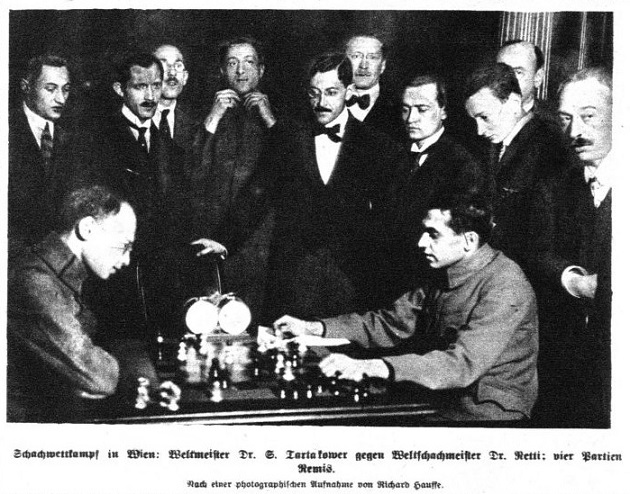
Wiener Bilder, 9 February 1919, page 10.
(9671)
From page 7 of Stein move by move by Thomas Engqvist (London, 2015):

From C.N. 8651:
Give the source of a quote if it is known. If it is not known, do not give the quote.
(9678)
‘One of the most original games ever played, and one of the finest examples of cool, resourceful chess under very trying circumstances.’
That was the concluding remark by Fred Reinfeld about a game which he annotated on pages 69-73 of How to Play the Black Pieces (New York, 1955):
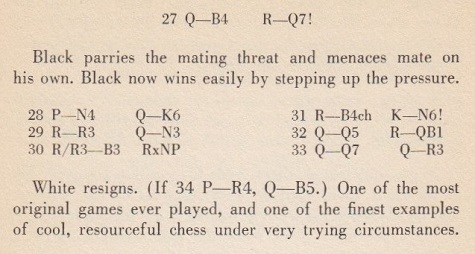
The players were not named, but the game was Spielmann v Tartakower, Copenhagen, 1923. Tartakower gave only the conclusion on page 115 of My Best Games of Chess 1905-1930 (London, 1953):
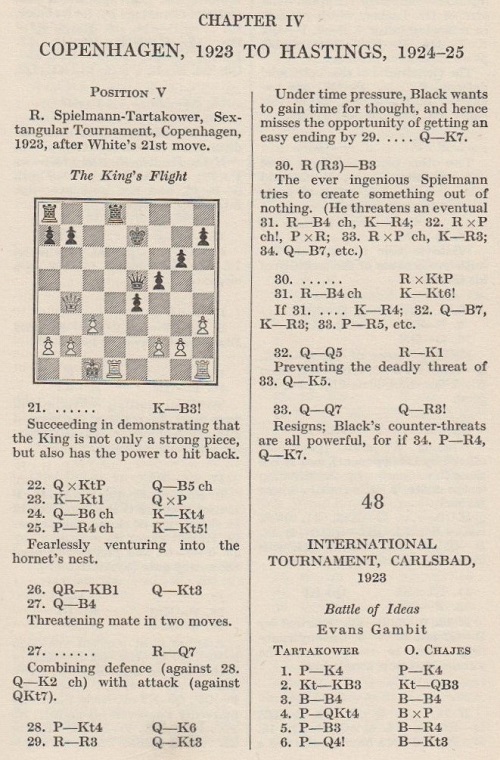
The full game was annotated by Tartakower on pages 35-36 of the April 1923 issue of the Wiener Schachzeitung:
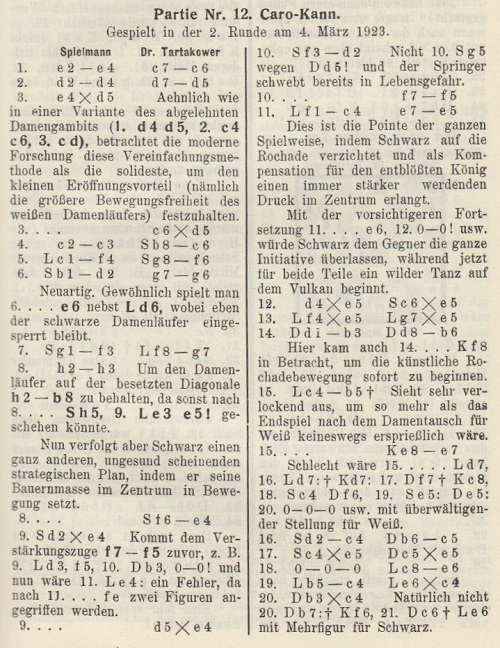
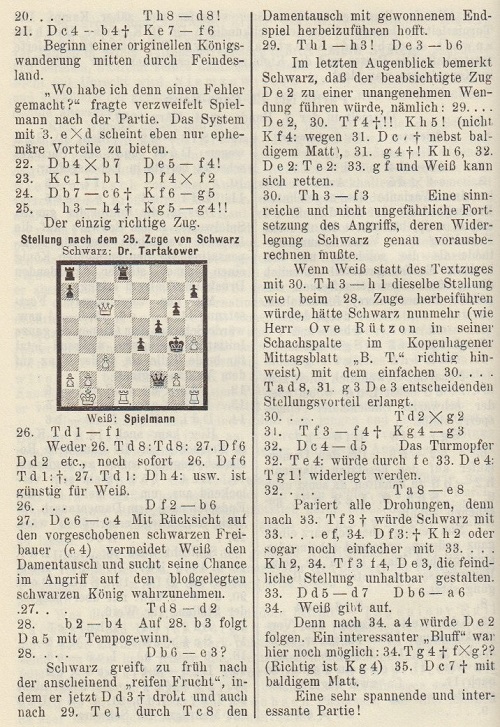
The ‘bluff’ mentioned in the final note is of particular interest, and it will be seen that in both publications Tartakower gave his 32nd move as ...Ra8-e8. Reinfeld, however, put ‘...R-QB1’, and that was also the move in the tournament book, where notes by Rubinstein were given on pages 9-10:
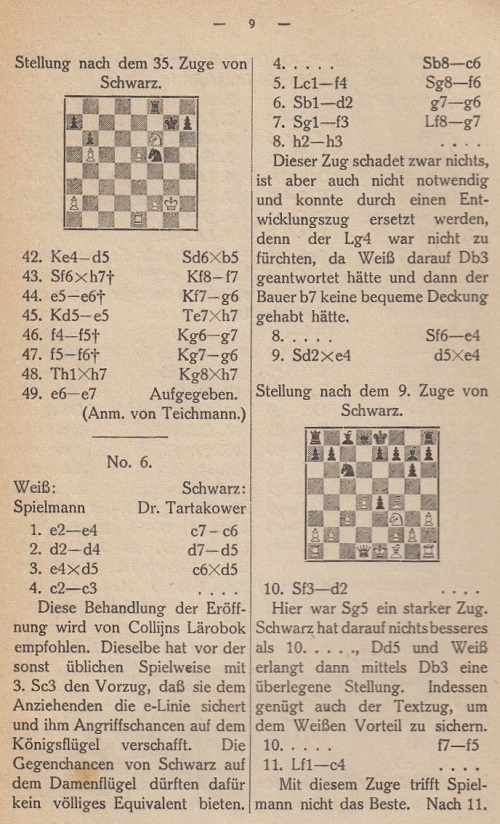
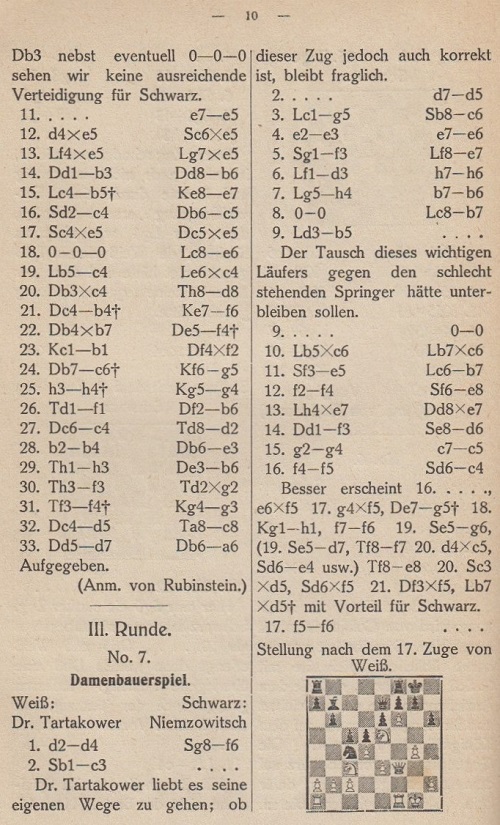
The improbable 32...Rc8 could be answered by 33 Rxe4.
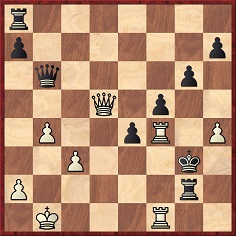
Position after 32 Qd5
The score as published by Tartakower in 1923: 1 e4 c6 2 d4 d5 3 exd5 cxd5 4 c3 Nc6 5 Bf4 Nf6 6 Nd2 g6 7 Ngf3 Bg7 8 h3 Ne4 9 Nxe4 dxe4 10 Nd2 f5 11 Bc4 e5 12 dxe5 Nxe5 13 Bxe5 Bxe5 14 Qb3 Qb6 15 Bb5+ Ke7 16 Nc4 Qc5 17 Nxe5 Qxe5 18 O-O-O Be6 19 Bc4 Bxc4 20 Qxc4 Rhd8 21 Qb4+ Kf6 22 Qxb7 Qf4+ 23 Kb1 Qxf2 24 Qc6+ Kg5 25 h4+ Kg4 26 Rdf1 Qb6 27 Qc4 Rd2 28 b4 Qe3 29 Rh3 Qb6 30 Rhf3 Rxg2 31 Rf4+ Kg3 32 Qd5 Re8 33 Qd7 Qa6 34 White resigns.
It was played in the same tournament as the Sämisch v Nimzowitsch ‘Immortal Zugzwang’ encounter, and neither game was widely published at first.
(9679)
‘The sake of the mistake is that it be made.’
That string of words is on page 76 of The Hypermodern Game of Chess (Milford, 2015), a ‘translation’ of Tartakower’s book by Jared Becker. The imprint page also specifies, ‘Editorial Consultant: Hannes Langrock’.
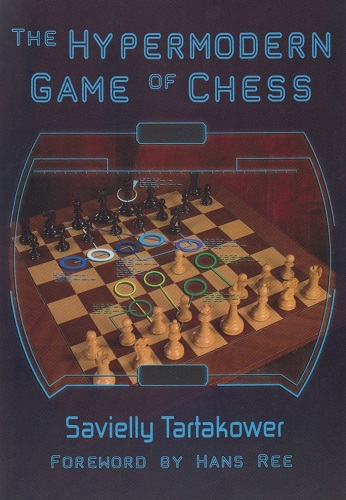
‘The sake of the mistake is that it be made’ is Jared Becker’s rendering of a line included in The Most Famous Chess Quotations:
- ‘Die Fehler sind dazu da, um gemacht zu werden.’
Die Hypermoderne Schachpartie by S. Tartakower (Vienna, 1924), page 90.
We commented in C.N. 4437 that Tartakower is one of the most difficult writers to translate into English (i.e. even by a competent linguist), and The Hypermodern Game of Chess is not remotely of publishable standard. Pages 52-53, for instance, have all kinds of mishaps, including ‘the most finest thing there is in chess’ and this challenging paragraph:
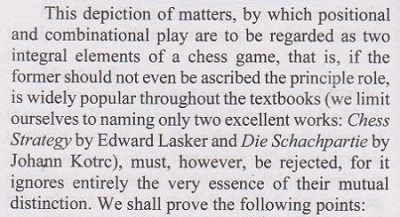
(9701)
The complete section, ‘Was ist Fehler?’, on pages 90-91 of Tartakower’s book:
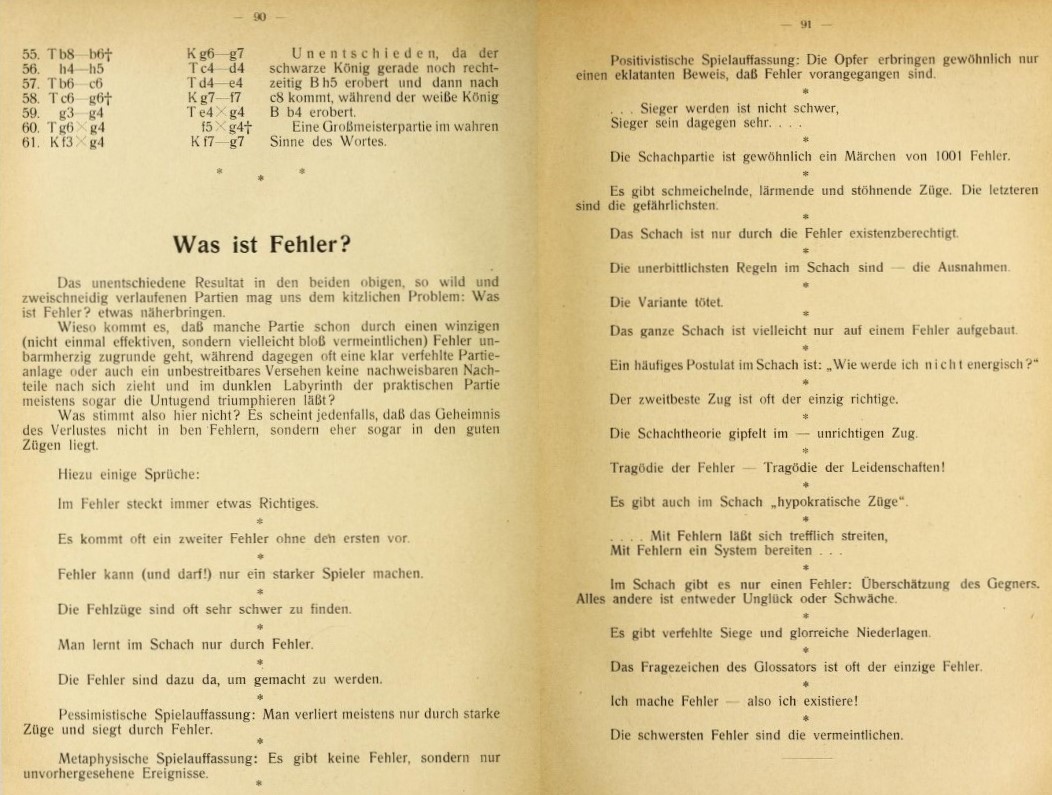
Dominique Thimognier asks about this game:
1 e4 e5 2 Nf3 Nc6 3 c3 d5 4 Bb5 dxe4 5 Nxe5 Qd5 6 Qa4 Ne7 7 f4 Bd7 8 Nxd7 Kxd7 9 O-O Nf5 10 b4 a5 11 Kh1
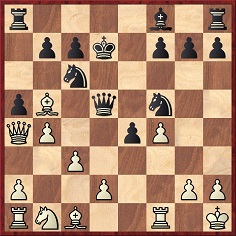
11...axb4 12 Bxc6+ bxc6 13 Qxa8 Bc5 14 Qxh8 Ng3+ 15 hxg3 Qh5 mate.
Our correspondent observes that page 10 of 200 megnyitási sakkcsapda by Emil Gelenczei (Budapest, 1958) stated that the players were Tartakower and Schiffers, no date being specified. On pages 36-37 of 300 miniaturas by A. Roizman (Barcelona, 1975) the heading, also without a date, was ‘NN-Schiffers’. There are databases which give the game as ‘Tartakower v Schiffers, Poland, 1910’, even though Emanuel Schiffers died in 1904. As noted on pages 141-142 of the September-October 1935 issue of Les Cahiers de l’Echiquier Français, the game had been published in Pitfalls of the Chessboard by E.A. Greig (where the opening moves were 1 e4 e5 2 Nf3 Nc6 3 c3 d5 4 Qa4 dxe4 5 Nxe5 Qd5 6 Bb5 Ne7) without any date or players’ names. The same move order was on pages 96-97 of Emanuel Lasker’s Common Sense in Chess (London, 1896), where the game appeared with the bare information that Black was ‘a fine Liverpool player’.
Mr Thimognier has raised an intriguing matter. First of all, we reproduce, concerning what Lasker wrote, an extract from page 903 of Amos Burn A Chess Biography by Richard Forster (Jefferson, 2004):
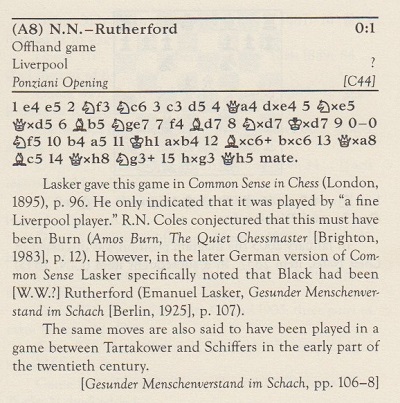
Below is the relevant part of the 1925 edition of Gesunder Menschenverstand im Schach:
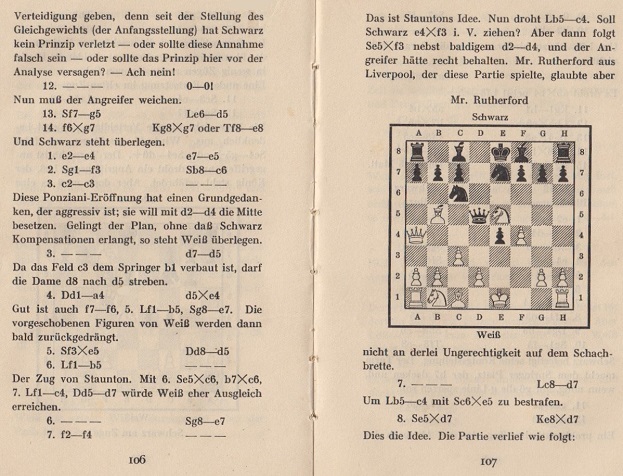
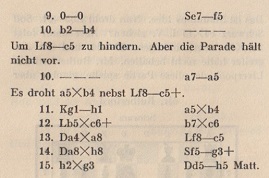
Page 65 of the algebraic edition of Common Sense in Chess (Milford, 2007) amended the game heading to ‘N.N. vs. Rutherford. Liverpool, 1800s’.
Analysis on page 213 of Play the Ponziani by D. Taylor and K. Hayward (London, 2009) awarded an exclamation mark to 10 d4, adding: ‘Tartakower’s 10 b4? runs into Schiffers’ 10...a5!; e.g. 11 Kh1 axb4 12 Bxc6+ bxc6 13 Qxa8 Bc5 14 Qxh8 Ng3+ 15 hxg3 Qh5 mate’.
Regarding Tartakower, mention may be made of analysis on page 180 of Die Hypermoderne Schachpartie (Vienna, 1924):
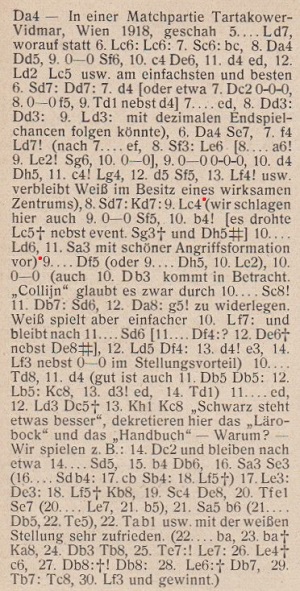
See too page 196 of 500 Master Games of Chess by Tartakower and du Mont (London, 1952).
Page 133 of the eighth edition of Modern Chess Openings (London, 1952) gave the line 10 b4 a5 with the footnote ‘Black wins (Swinnerton-Dyer)’. The same page referred to a game between Swinnerton-Dyer and Barrett, Cambridge, 1949 in another variation of the Ponziani Opening. On page 75 of the ninth edition of Modern Chess Openings (London, 1957) the note after 10 b4 a5 became ‘Black wins (Schiffers). The threat is 11...PxP and 12...B-B4ch’.
The 15-move game was the subject of a short story, ‘The Wiener Dog Gambit’ by Brent Haywood, on pages 34-35 of the February 1985 Chess Life. Prizes were offered to readers able to identify ‘which two famous masters really played this miniature’, and the result was published on page 57 of the May 1985 issue:
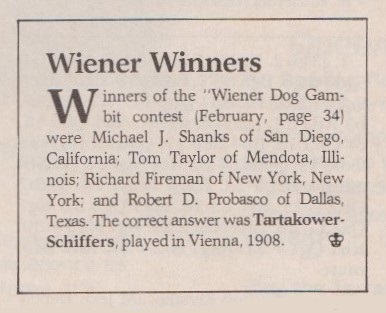
Tartakower, Schiffers, Vienna and 1908 were also referred to in a letter from Robert Probasco on page 7 of the May 1985 Chess Life, but why? As noted above, Schiffers died in 1904.
(9758)
Wanted: early references to pawn offers being the best or hardest type of chess sacrifice.
An example (‘Pawn sacrifices are the finest sacrifices after all’) comes from A. Becker’s notes to Réti v Tartakower, Hastings, 31 December 1926, on pages 2-4 of the January 1927 Wiener Schachzeitung. 1 Nf3 Nf6 2 d4 d5 3 c4 e6 4 Nc3 Be7 5 Bg5 h6 6 Bxf6 Bxf6 7 e3 O-O 8 Qb3 dxc4 9 Bxc4 c5 10 dxc5 Nd7 11 Ne4 Nxc5 12 Nxf6+ Qxf6 13 Qc2 b6 14 O-O Bb7 15 Nd4 Rac8 16 Qe2 e5:
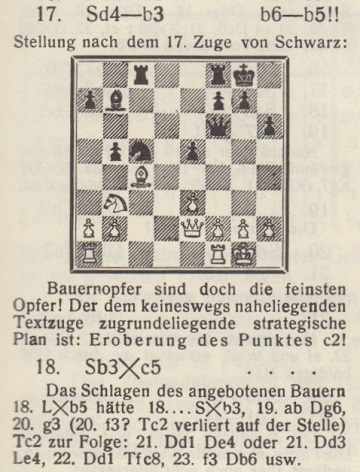
Tartakower annotated the full score in the first volume of his Best Games collection and commented that 17...b5 was ‘one more illustration of the paradox of a chess author that “the principal finesses in chess conflicts are furnished by pawn moves”.’ He concluded, ‘This is one of my best games’.
From page 56 of the February 1927 BCM:
‘The tit-bit of the round was expected to be the Réti-Tartakower game; but the former, who was evidently tired out by his six hours’ match-chess plus four hours’ blindfold display the previous day, did not do himself justice. Tartakower secured an endgame advantage on the queen-side, and playing with relentless accuracy he won the game in 45 moves.’
(9859)
C.N. 3197 (see A Nimzowitsch Story) quoted a remark by Tartakower on page 373 of issue 28 of Les Cahiers de l’Echiquier Français (1932):
‘1. Puisque “la menace est plus forte que l’exécution”, il n’est pas paradoxal de prétendre qu’il est plus fort de ne pas user de la menace. Qu’on appelle cette stratégie “louvoiement”, “jeu positionnel” ou “stratégie d’attente”, c’est une façon de jouer qui est très pratiquée dans les grands tournois et qui donne souvent de bons résultats, car il peut en résulter chez l’adversaire une moindre vigilance. Elle peut, en outre, lui faire perdre patience et le pousser à s’élancer dans une attaque prématurée.’
Christian Sánchez (Rosario, Argentina) notes that the article had previously appeared on pages 132-134 of El Ajedrez Americano, May 1931, with this slightly different text on page 134:
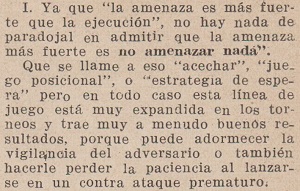
(9964)
C.N. 9739 mentioned that the absence of sources in Chess Results, 1747-1900 by Gino Di Felice (Jefferson, 2004), as had been noted in C.N. 3594, was corrected later in the series, starting with Chess Results, 1941-1946 (Jefferson, 2008).
A source is helpful in this case, from page 291 of Chess Results, 1956-1960 (Jefferson, 2010):
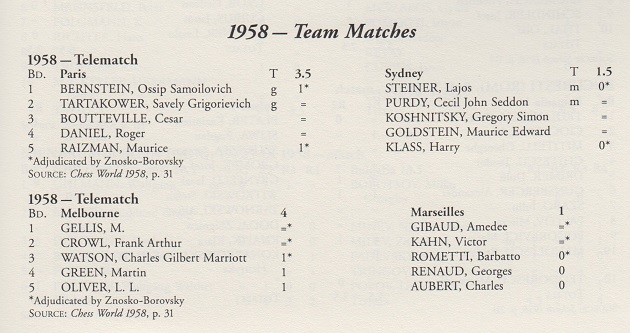
Below is what was published in the Australian magazine in 1958:
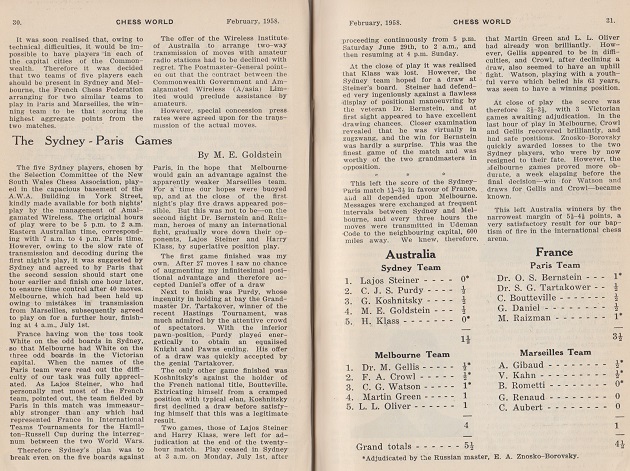
This was not a topical report but an historical article on matches played in 1946. Tartakower died in 1956.
(10072)
From Jan Kalendovský come two photographs published on page 4 of Světozor, 5 August 1910:
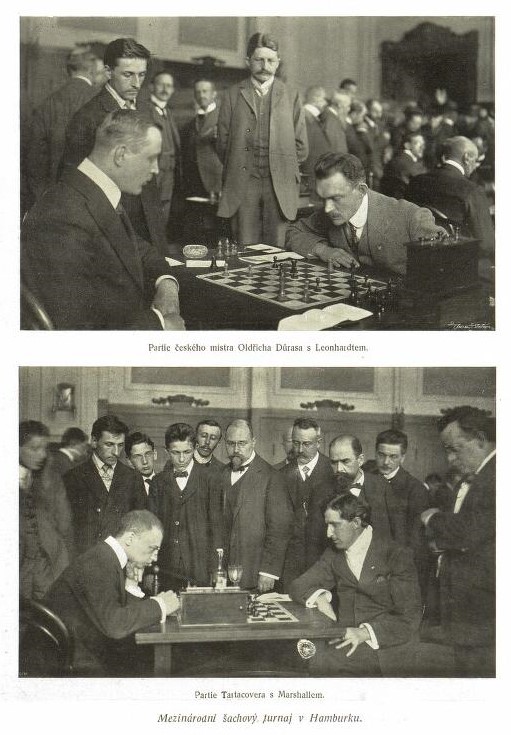
Larger versions: Důras v Leonhardt; Tartakower v Marshall.
(10079)
From the Detroit Free Press (Rotogravure Supplement), 23 March 1924:
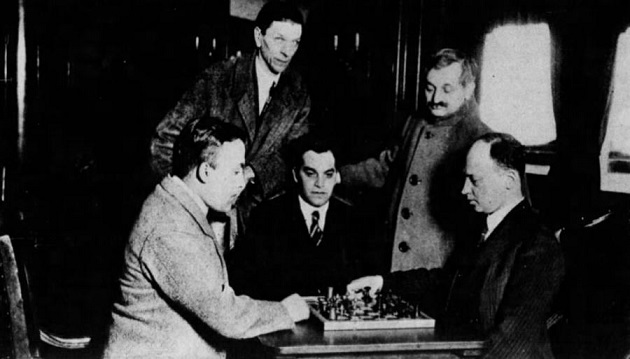
From left to right: Efim Bogoljubow, Géza Maróczy, Richard Réti, Emanuel Lasker, Savielly Tartakower
(10189)
Dominique Thimognier (Fondettes, France) refers back to the ‘cynical’, sourceless annotation attributed to Tartakower, ‘Here Black overlooks that he has the right to resign’ (C.N.s 10171 and 10182).
Our correspondent draws a parallel with a remark given in C.N. 202 (see page 233 of Chess Explorations). That item pointed out that page 27 of the Australasian Chess Review, 30 January 1936 quoted a comment by Tartakower concerning Alekhine’s move 30...Kh8 in the 12th match-game against Euwe in 1935:
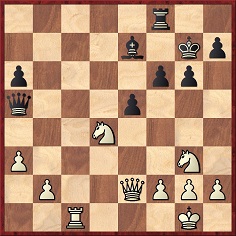
Position after 30 Rxc1

We add that a similar annotation was attributed to Tartakower on page 127 of CHESS, 14 December 1935:

Tartakower covered the world championship match for De Telegraaf, and below is his note on page 9 of the 30 October 1935 edition of the Dutch newspaper:

Although the Australasian Chess Review and CHESS both had the adjective ‘excellent’, the usual meaning of ‘geschikte’ is ‘suitable’, and a more literal translation of Tartakower’s remark ‘Hier mist zwart een geschikte gelegenheid om op te geven’ would therefore be ‘Here Black missed a suitable opportunity to resign’. That, though, is far less quotable than ‘Here Black missed excellent resigning chances’. It is difficult to judge how much humour and/or irony Tartakower’s note in Dutch was intended to convey.
(10202)
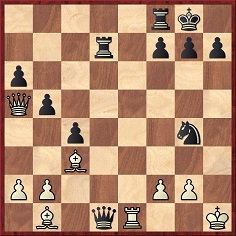
White to move
From page 10 of Chess Review, January 1952 in an article by Tartakower entitled ‘From My Chess Memoirs’:
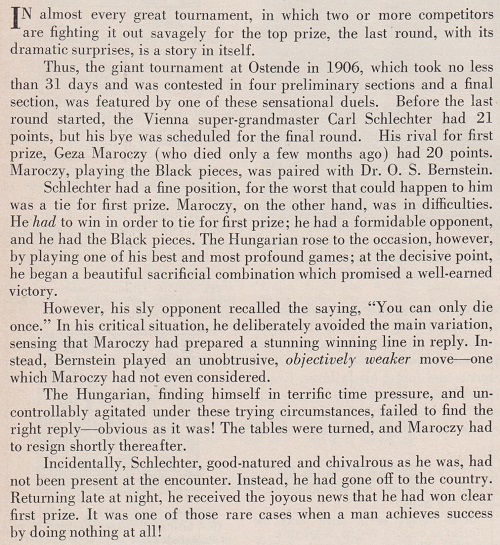
The episode was also referred to by Albéric O’Kelly de Galway on page 266 of the September 1956 Chess Review:
‘Bernstein narrates the following concerning his game against Maróczy. In a desperate position and about to resign, he saw that his opponent had only 30 seconds for three moves to the time-limit, while he himself had half an hour. Knowing a normal move must lose quickly, he suddenly made a move which was rather stupid. As he expected, his opponent was caught by surprise, flushed nervously, overlooked the winning move and lost.’
The Bernstein v Maróczy game: 1 d4 d5 2 c4 e6 3 Nc3 Nf6 4 Nf3 Be7 5 Bf4 O-O 6 e3 b6 7 cxd5 exd5 8 Bd3 a6 9 O-O Bb7 10 Ne5 c5 11 Qf3 Ra7 12 Rad1 c4 13 Bb1 b5 14 e4 dxe4 15 Nxe4 Nbd7 16 Nc6 Bxc6 17 Nxf6+ Nxf6 18 Qxc6 Qd5 19 Qb6 Rd7 20 Rfe1 Bb4 21 Bd2 Bd6 22 Qa5 Qxd4 23 Bc3 Bxh2+ 24 Kxh2 Ng4+ 25 Kh1 Qxd1

26 f3 Qd5 27 fxg4 Rd6 28 Qc7 b4 29 Be4 Rh6+ 30 Kg1 Qb5 31 Bd2 Re6 32 Bf3 Rfe8 33 Rxe6 Resigns.
The game was annotated on pages 69-71 of Moderne Schachstrategie (Breslau, 1930), a monograph on Bernstein by Tartakower.
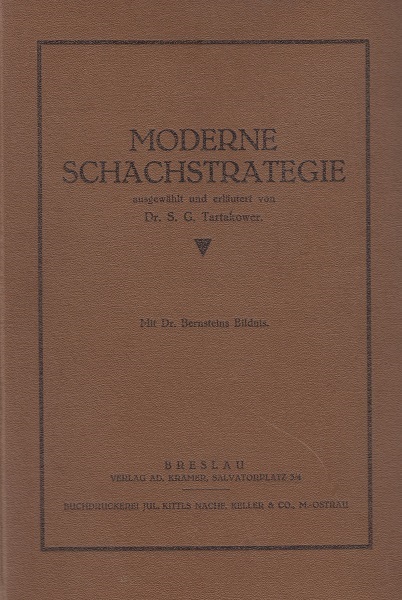
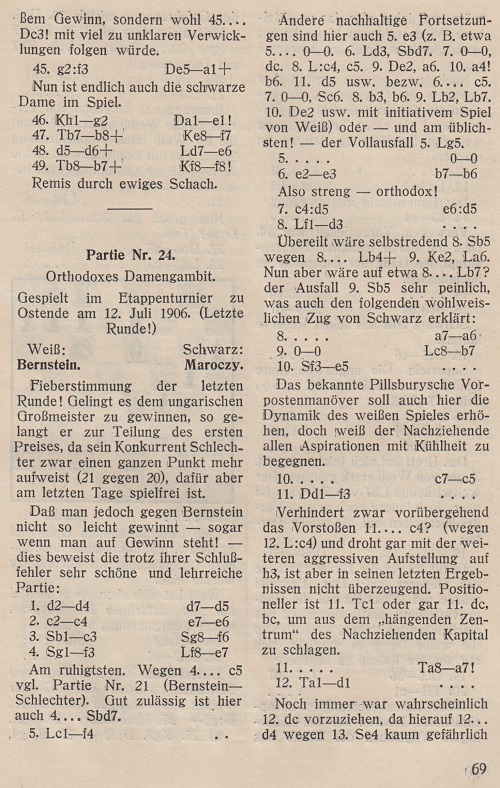
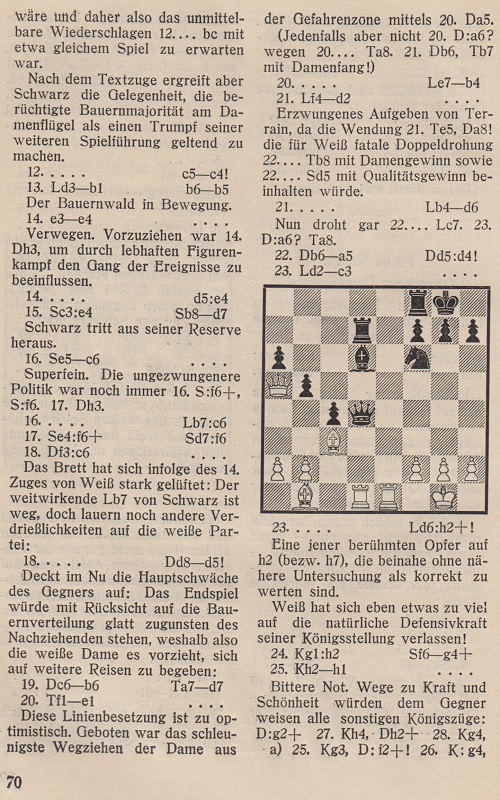
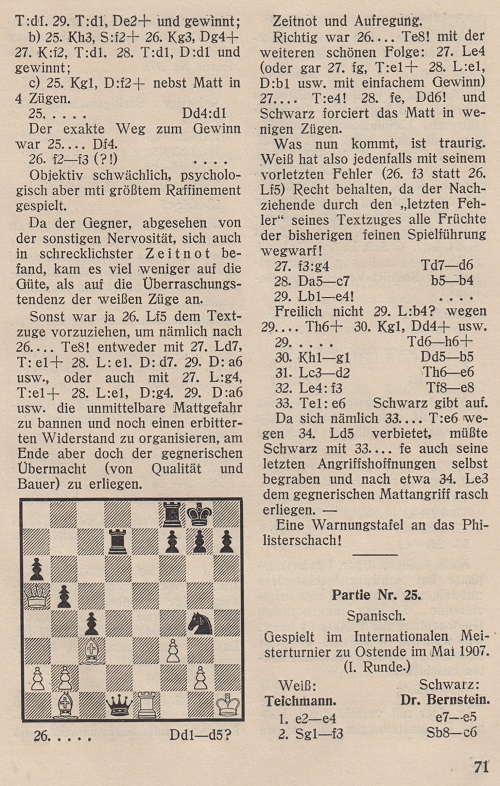
Other notes can be found on pages 395-400 of the Caissa Editions book on Ostend, 1906 edited by A.J. Gillam (Yorklyn, 2005), and a computer-check of the game will be found particularly valuable. A curiosity is that on page 177 of the June 1952 BCM E.G.R. Cordingley stated that the game was drawn.
(10300)
See too C.N. 10326.
A paragraph on page 367 of José Raúl Capablanca A Chess Biography by M.A. Sánchez (Jefferson, 2015):

It is dispiriting to see ‘allegedly wrote (per Chessquotes.com but unconfirmed)’ in any outlet, and especially in a McFarland book and in connection with a familiar, easily-documented remark. Below is page 169 of Tartakower’s Die hypermoderne Schachpartie (Vienna, 1924):
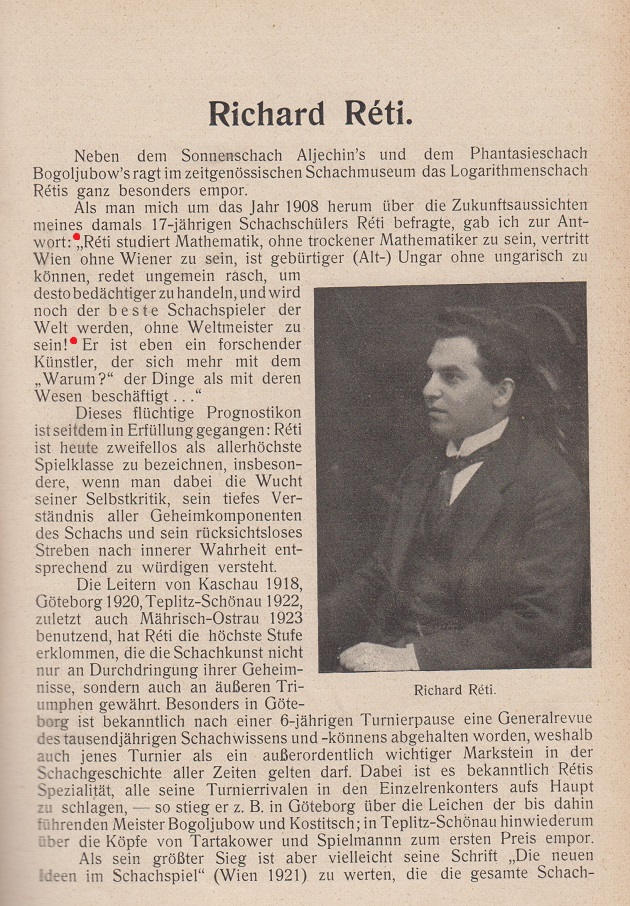
A good translation of the passage about the Réti paradoxes was on page 45 of the February 1952 Chess Review:
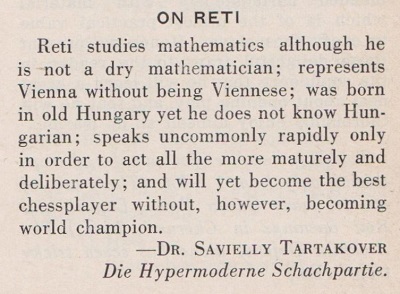
An awful translation, by Jared Becker, is on page 141 of The Hypermodern Game of Chess (Milford, 2015), a book criticized in C.N. 9701:
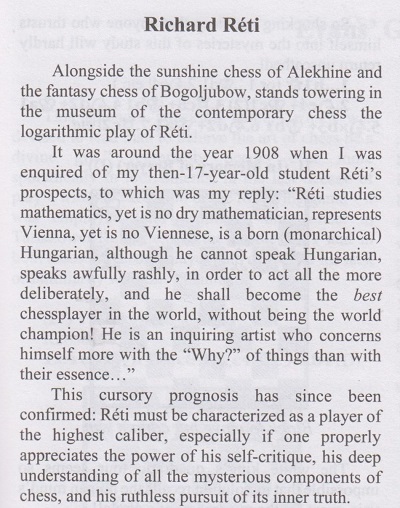
(10408)
Regarding the well-known gamelet between the two masters, see Réti v Tartakower (Vienna, 1910).
From an article by Tartakower, ‘Secrets of San Remo, 1930’, on pages 421-424 of CHESS, 20 August 1939:
‘Coming second in so important a competition, Nimzowitsch was considered the prince of chess. Nevertheless he was less dangerous to Alekhine throughout the tournament than Rubinstein, who had the chance, two rounds before the end, of catching up with the leader. That is why in the game Alekhine-Rubinstein played in the 14th round – the one before the last – it appeared to be to Alekhine’s advantage to try for a draw, which would give him first prize, rather than chase an uncertain win. When somebody suggested to Rubinstein before the game that he would do well to accept such a pacific situation the great Akiba replied, “A Rubinstein always plays to win”.
Lacking thus a quiet and objective outlook, Rubinstein fell into an opening trap which cost him a pawn and, despite a heroic resistance, the game.’
Concerning that game, see The Rubinstein Trap. With regard to Tartakower’s comments about the standings, it should be noted that before the 14th round Alekhine led with 12 points, followed by Nimzowitsch and Rubinstein (9 points). Alekhine won the tournament by a 3½-point margin.
(10489)
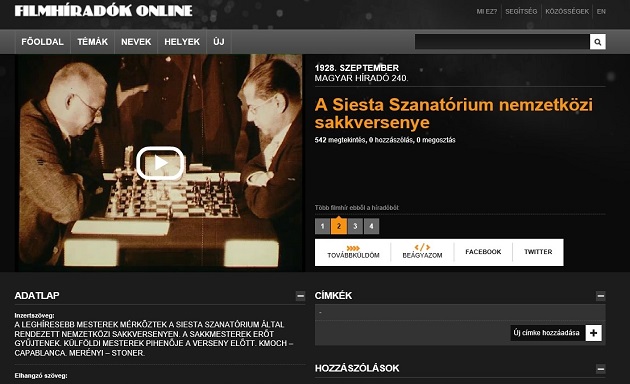
Olimpiu G. Urcan notes that a search for sakk on the Magyar Világhíradók website provides film coverage of Budapest, 1928 (notably featuring Capablanca) ...
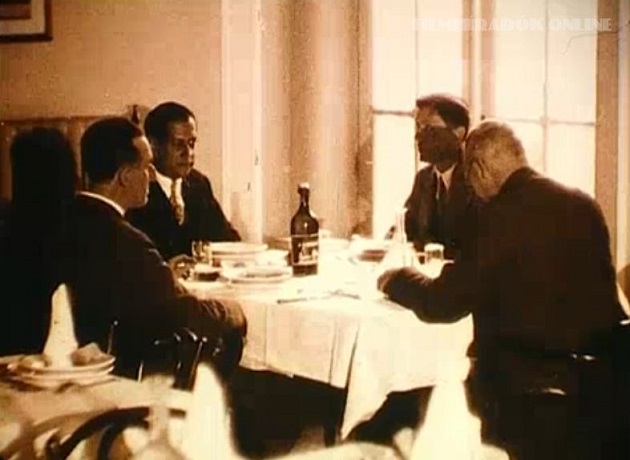
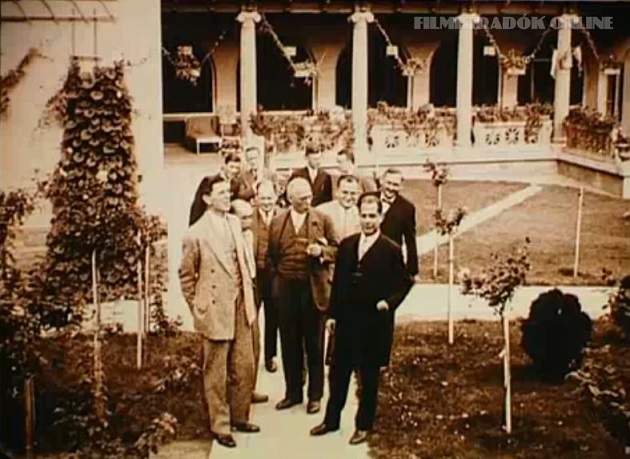
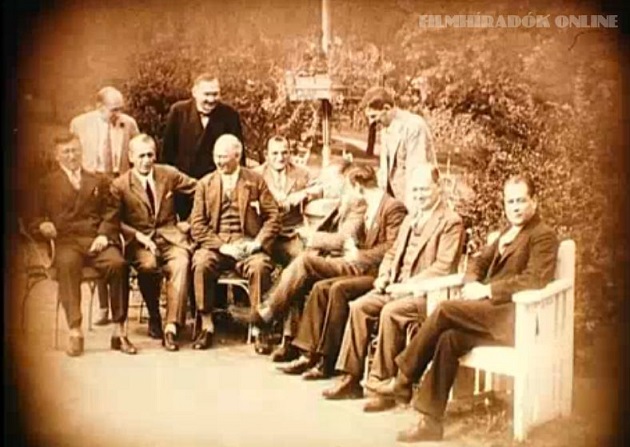
... as well items with footage of Maróczy, Réti, Rubinstein and Tartakower.
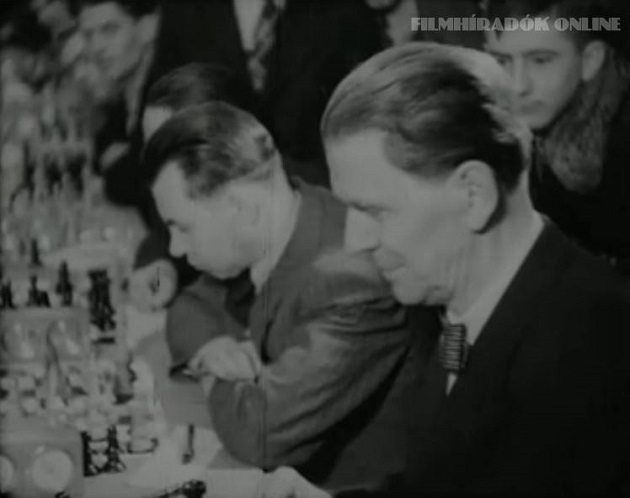
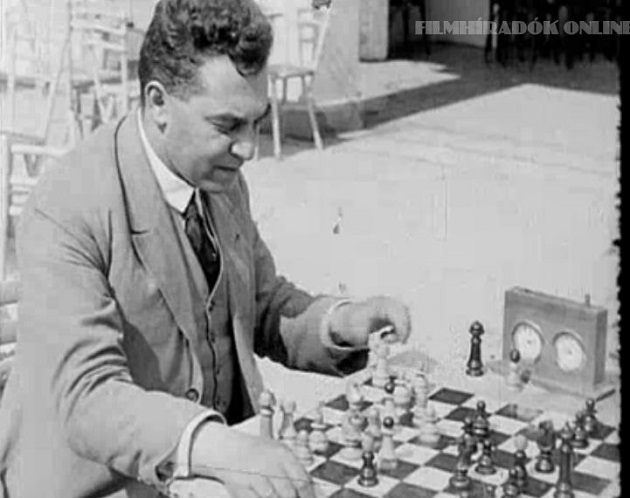
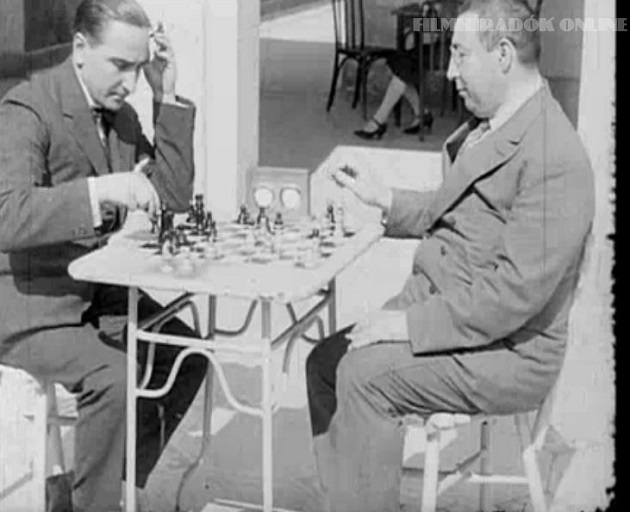
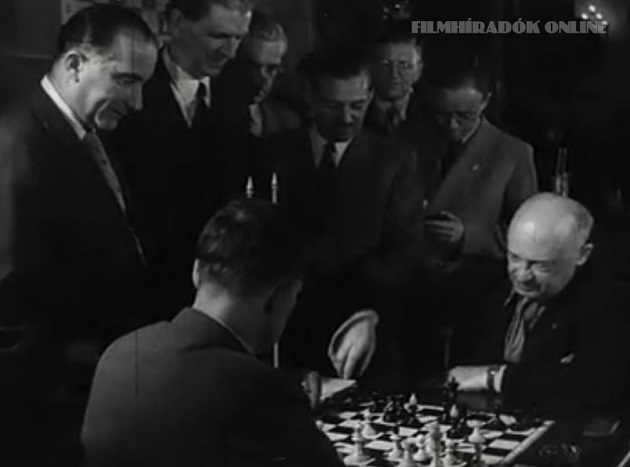
(10764)
James Lanning (Bloomington, IN, USA) draws attention to this curious passage on page 442 of Die hypermoderne Schachpartie by Savielly Tartakower (Vienna, 1924):

Tartakower’s essay in Spielmann’s monograph on Schlechter is given below in full. It appeared under the pseudonym ‘Spielmann’ in the sense that it was in Spielmann’s book without any indication of authorship, thus leaving readers to assume that the three and a half pages were by Spielmann himself.
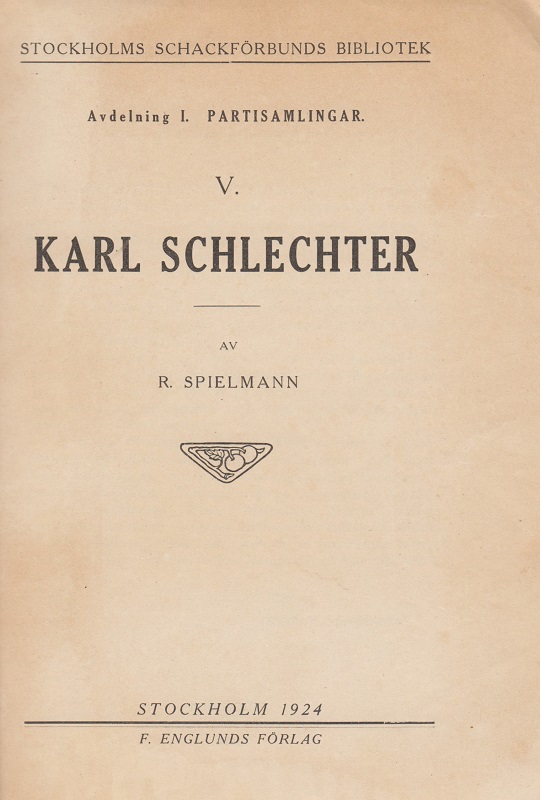
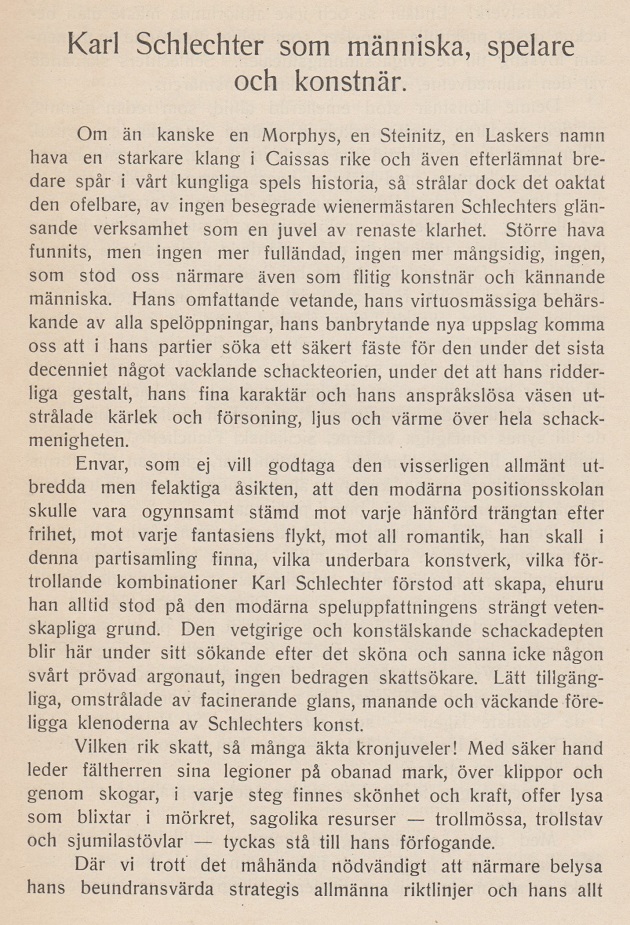
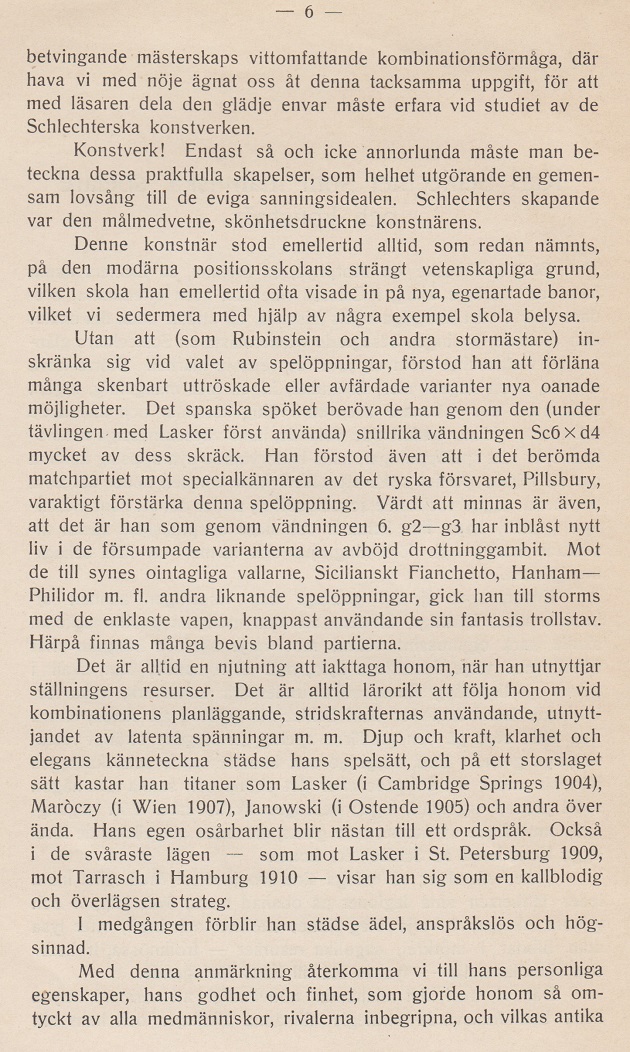
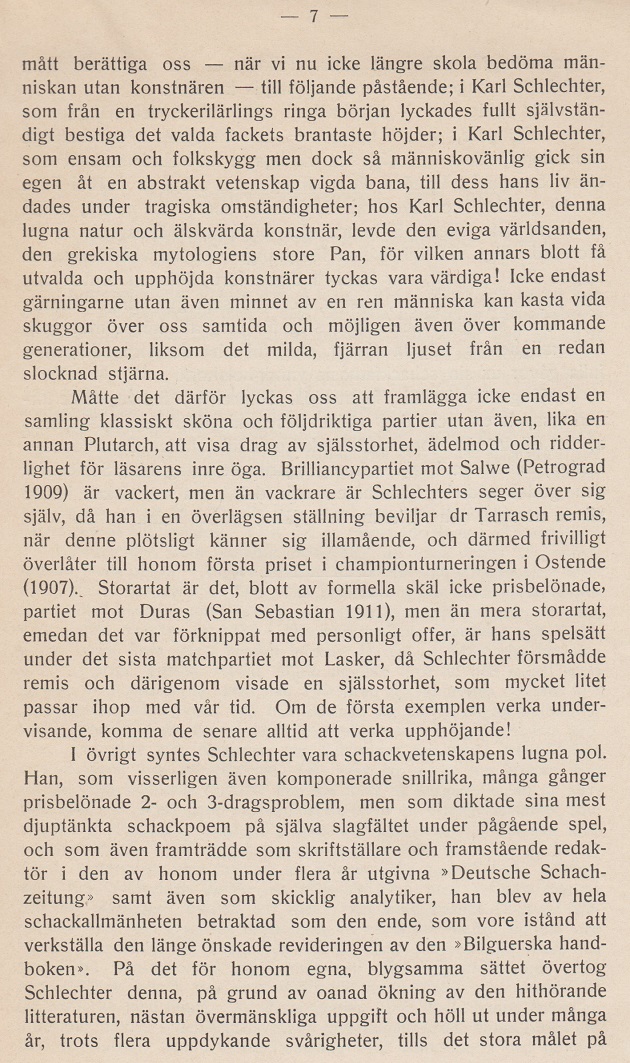
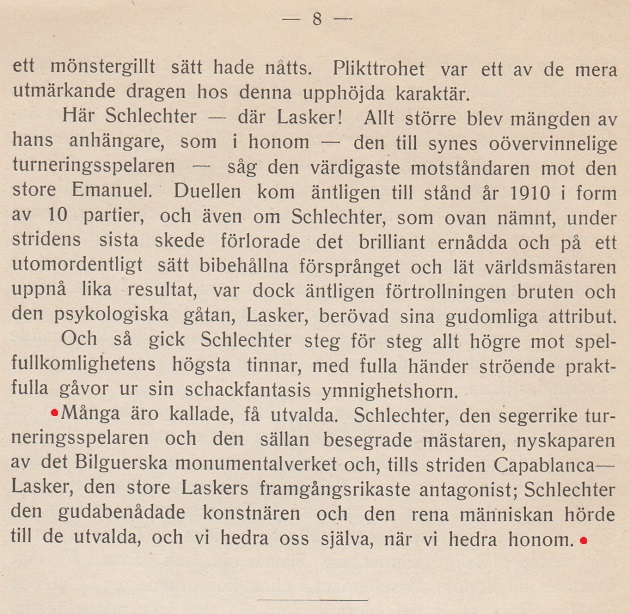
The passage in Die hypermoderne Schachpartie mentioned by our correspondent was mistranslated in the disastrous English edition (see C.N.s 9701 and 10408) of Tartakower’s book, The Hypermodern Game of Chess (Milford, 2015):
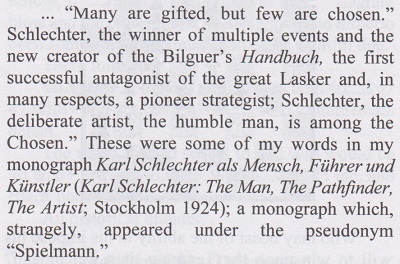
(10915)
The opening paragraph of the article ‘My Bizarre Openings’ by Savielly Tartakower on pages 414-415 of CHESS, 14 August 1938:
‘I regard my openings not so much “bizarre” as psychological, for there is much more risk of going wrong when one adopts a well-known and hackneyed opening than when one succeeds in putting one’s opponent off his balance at the very outset by some totally unexpected coup. The worse a move seems at first sight, the more effective it may be. I refuse to admit that chance does not enter into chess; chance is the measure of human ignorance, and an opponent who, through over-confidence or alarm – two emotions commonly engendered by an apparently “bad” move in the opening – allows his perception of the possibilities and therefore his knowledge of them to be lessened is allowing the chances to pile up against him.’
(10918)
From page 189 of CHESS, May 1940, in an article entitled ‘Last-Round Surprises’ by S. Tartakower (pages 186-190):
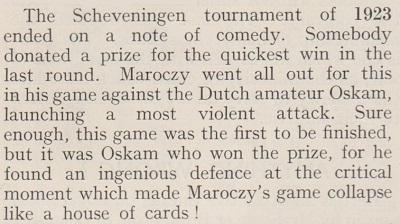
Maróczy annotated his loss to Oskam on pages 101-102 of the Scheveningen, 1923 tournament book published by Bernhard Kagan:
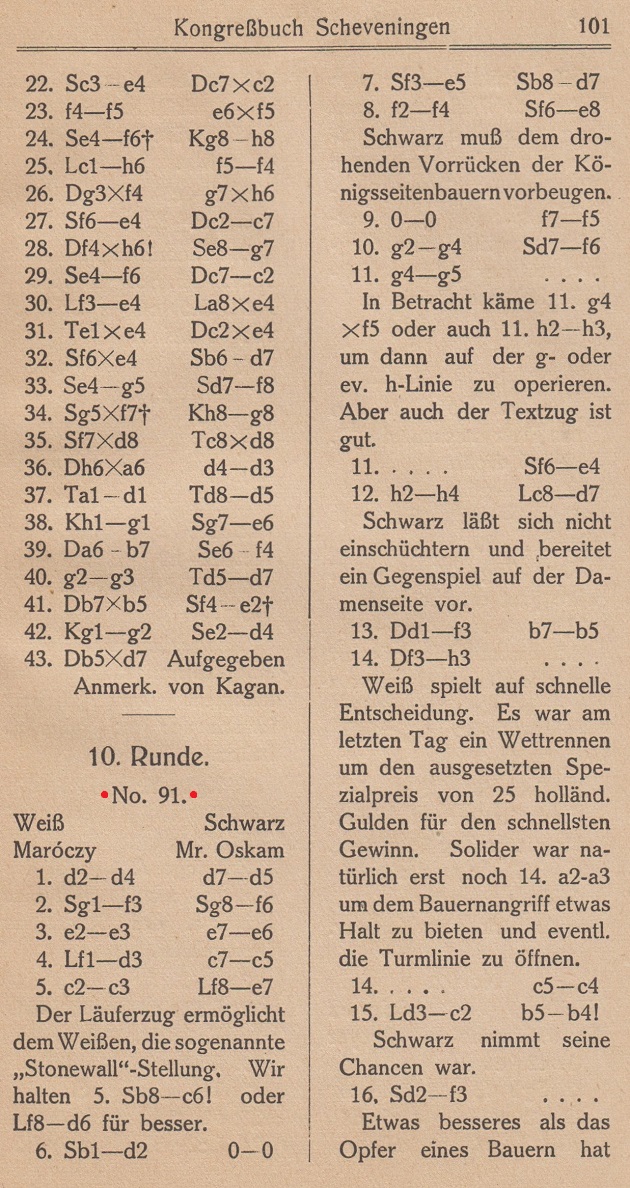
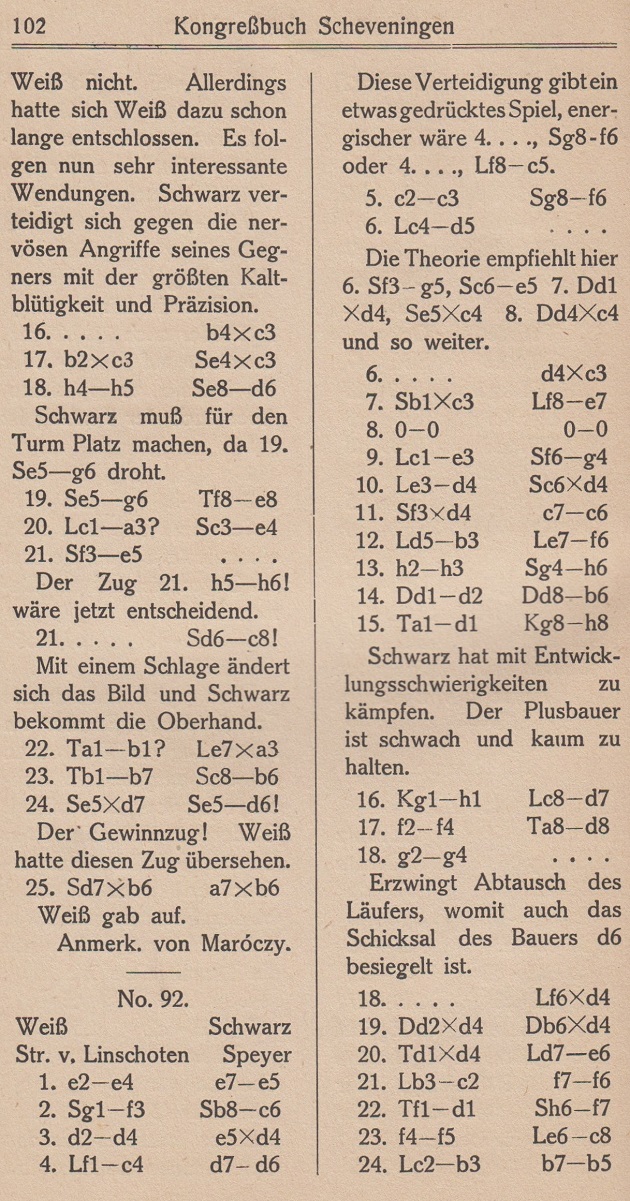
1 d4 d5 2 Nf3 Nf6 3 e3 e6 4 Bd3 c5 5 c3 Be7 6 Nbd2 O-O 7 Ne5 Nbd7 8 f4 Ne8 9 O-O f5 10 g4 Ndf6 11 g5 Ne4 12 h4 Bd7 13 Qf3 b5 14 Qh3 c4 15 Bc2 b4 16 Ndf3 bxc3 17 bxc3 Nxc3 18 h5 Nd6 19 Ng6 Re8 20 Ba3 Nce4 21 Nfe5
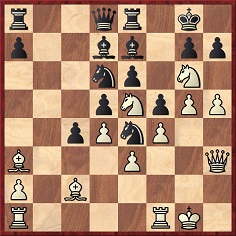
21...Nc8 22 Rab1 Bxa3 23 Rb7 Nb6 24 Nxd7 Nd6 25 Nxb6 axb6 26 White resigns.
However, according to pages 104-105 of the tournament book it was another game, Johner v Fick, which won the prize for the first game to end in the final round:
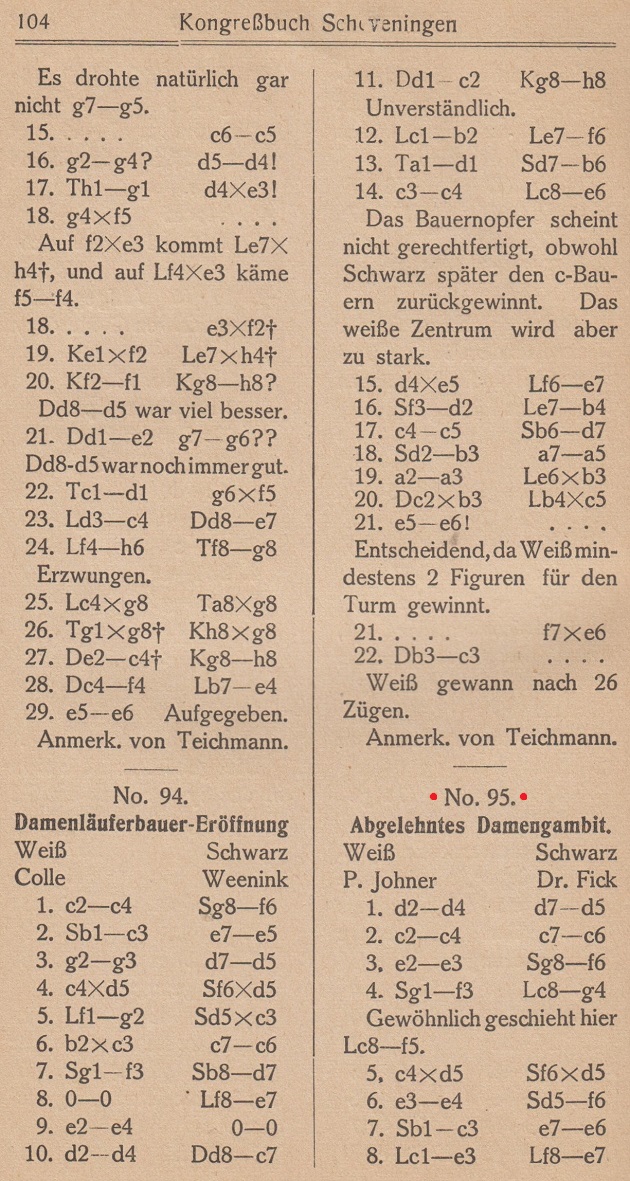
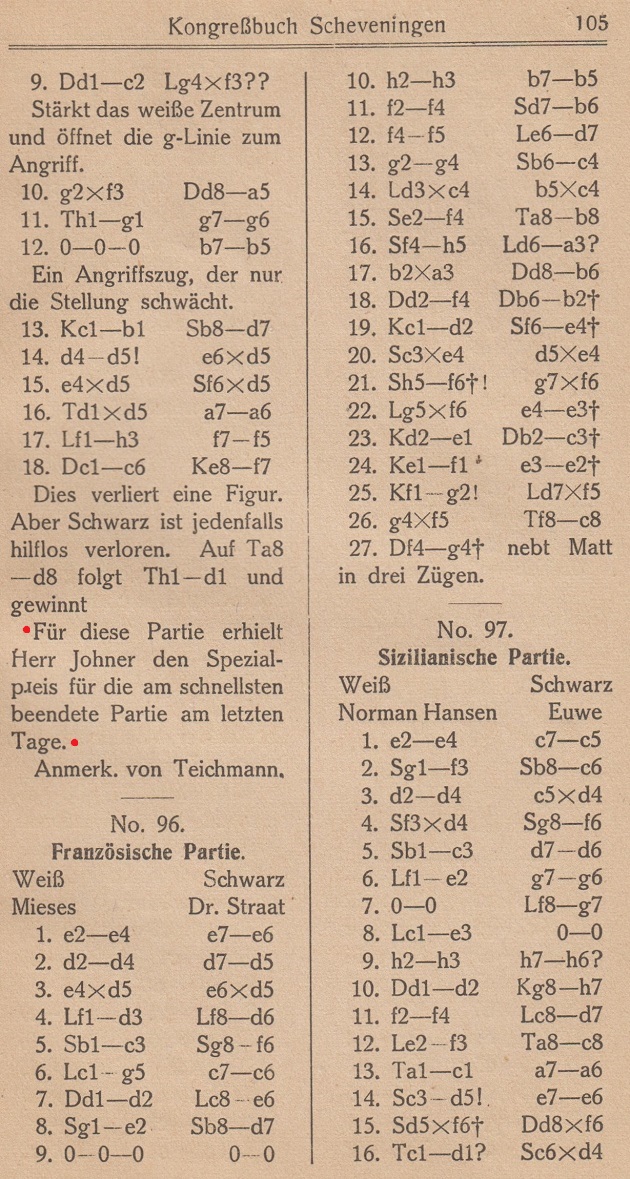
1 d4 d5 2 c4 c6 3 e3 Nf6 4 Nf3 Bg4 5 cxd5 Nxd5 6 e4 Nf6 7 Nc3 e6 8 Be3 Be7 9 Qc2 Bxf3 10 gxf3 Qa5 11 Rg1 g6 12 O-O-O b5 13 Kb1 Nbd7
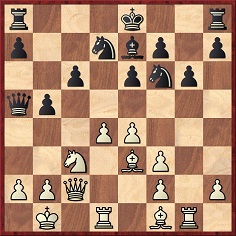
14 d5 exd5 15 exd5 exd5 16 Nxd5 Nxd5 17 Rxd5 a6 18 Bh3 f5 19 Qc6 [Kf7 and Black resigns].
In the exchanges on d5 a pair of moves was missing from the tournament book, and our game-score above follows what appeared on page 3 of the Nieuwe Rotterdamsche Courant, 4 August 1923, which discussed both games:
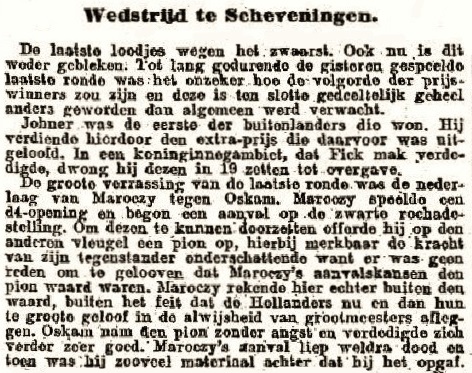
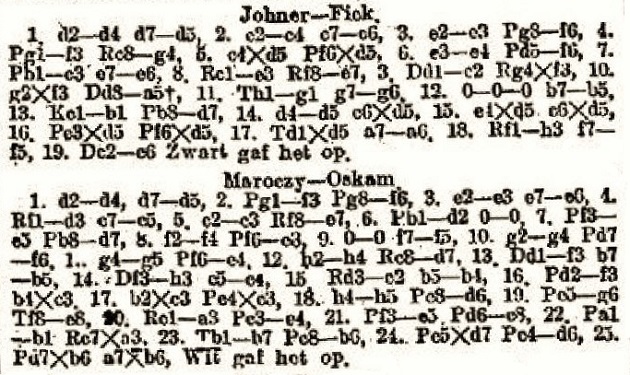
(11002)
From page 188 of CHESS, May 1940, below is a further extract from the article by Tartakower referred to in C.N. 11002:
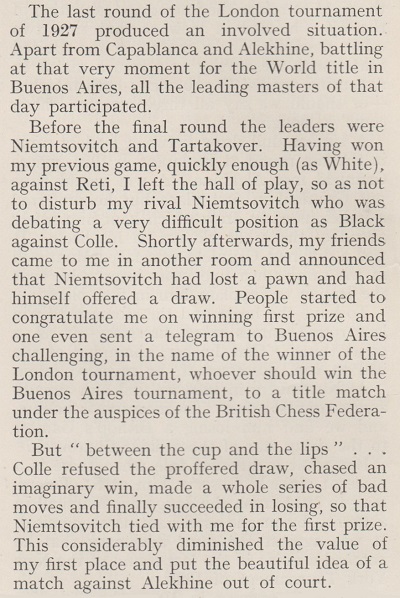
In the first paragraph, the word ‘previous’ is inapposite; Tartakower v Réti was the last-round game. Against Colle, Nimzowitsch was White, not Black; he annotated the game on pages 73-76 of Die Praxis meines Systems (Berlin, 1930).
Having annotated his win over Réti, Tartakower discussed the aftermath of the London, 1927 tournament on page 201 of his first volume of Best Games (London, 1953).
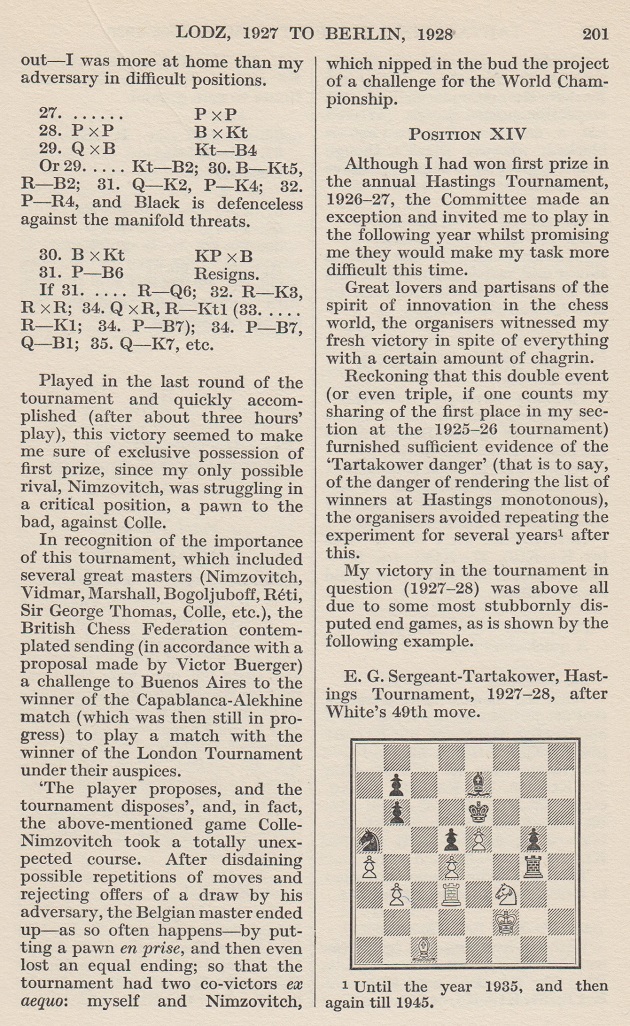
In CHESS, Tartakower stated that a telegram was sent to Buenos Aires, whereas his book had the phrase ‘contemplated sending ... a challenge to Buenos Aires’. On page 270 of the French edition, Tartacover vous parle (Paris, 1953), the wording was ‘envisageait ... de lancer à Buenos-Aires un défi’.
(11014)
A remark by Tartakower on page 37 of the Wiener Schachzeitung, April 1923:

(11015)
From page 462 of L’Echiquier, 5 April 1934, in a ‘fins de partie curieuses’ article by Tartakower:

(11052)
Zdenĕk Závodný (Brno, Czech Republic) has forwarded an article by Tartakower, ‘Die Welt des Schachspielers. Eine historisch-psychologische Studie’, on pages 15-17 of the 6/1920 edition of Moderne Welt:
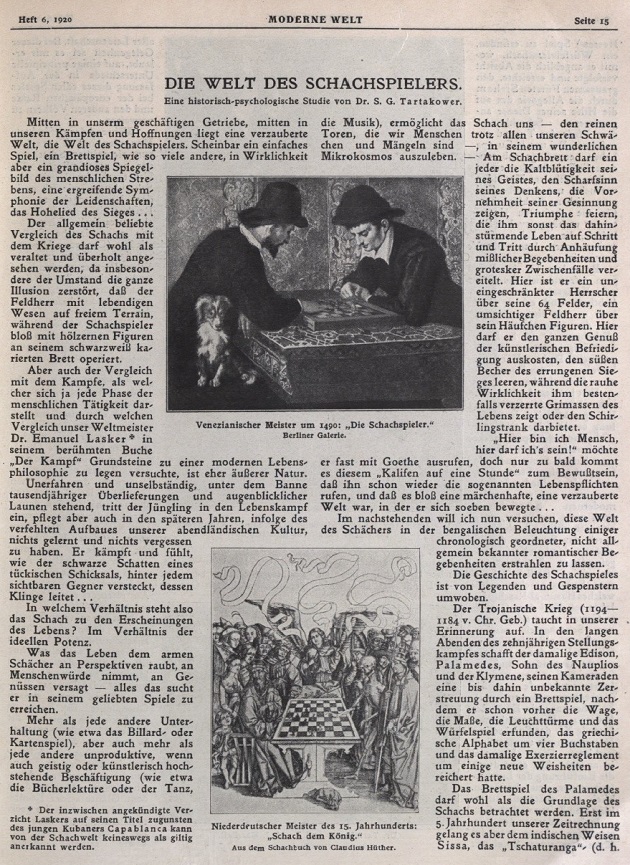
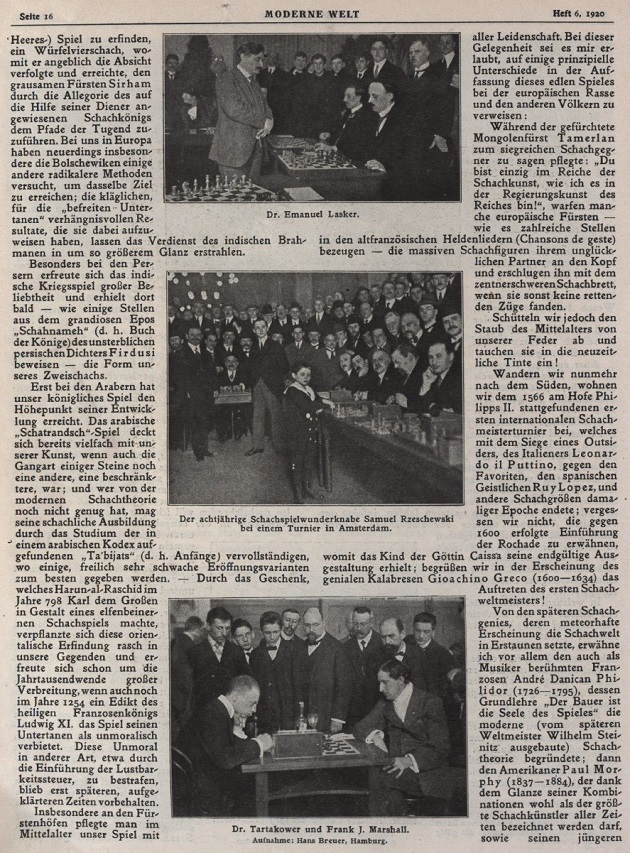
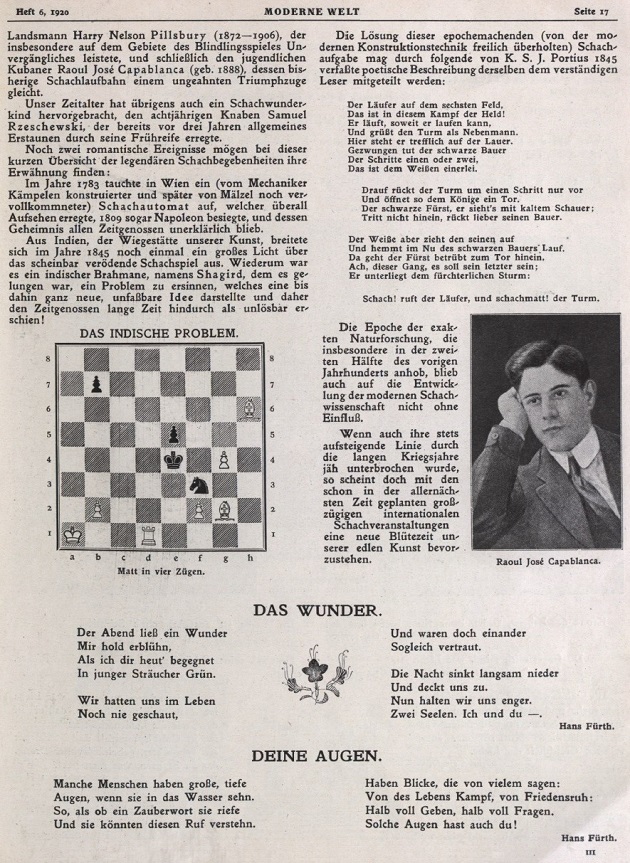
Tartakower reproduced the article, without the pictures, on pages 3-7 of his booklet Am Baum der Schacherkenntnis (Berlin, 1921).
(11351)
Tim Bogan (Chicago, IL, USA) submits a pair of quotations:
Page 112 of Training for the Tournament Player by M. Dvoretsky and A. Yusupov (London, 1993), in the chapter ‘Studying the Classics’ by M. Shereshevsky;
Page 90 of Chess Training for Candidate Masters by A. Kalinin (Alkmaar, 2017). The paragraph reported on a 1979 speech by Petrosian.
A general remark about the latter book is that although the imprint page promises, ‘we will collect all relevant corrections on the Errata page of our website’, a start has yet to be made.
(11630)
Further information about Savielly Tartakower during the Great War is in the 1915 volume of the Wiener Schachzeitung: January-February, page 20; May-June, pages 109-110; July-August, pages 183-184. As mentioned in C.N. 7728, the periodical is available on-line at the ANNO website.
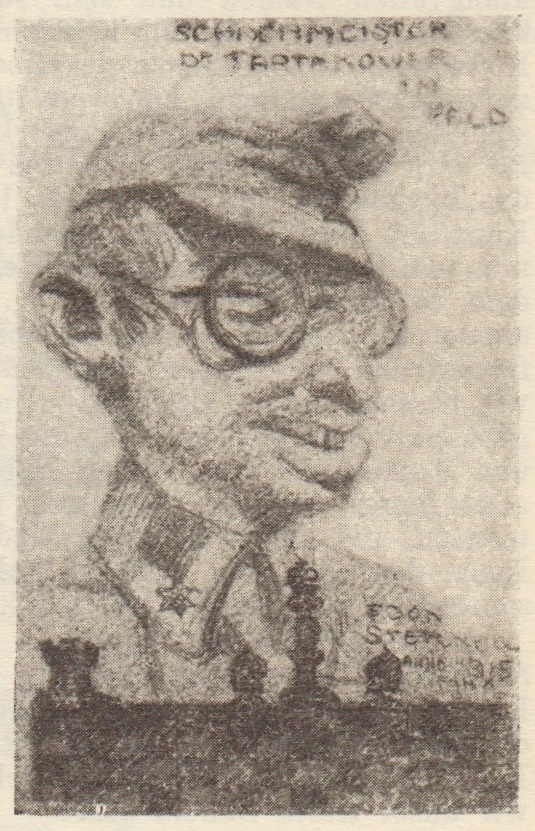
Wiener Schachzeitung, May-June 1915, page 109
(11779)
On 22 April 1997 Mark Saylor, an editor at the Los Angeles Times, asked whether we had a source for a quote attributed, he believed, to Tartakower:
‘Chess ennobles man, for it is filled with disappointment.’
Nothing was found, but now Richard Forster notes that the remark (‘Das Schachspiel veredelt den Menschen, da es voller Enttäuschungen ist’) was the fourth in a list of observations by Tartakower on pages 353-355 of the December 1927 Deutsche Schachzeitung:
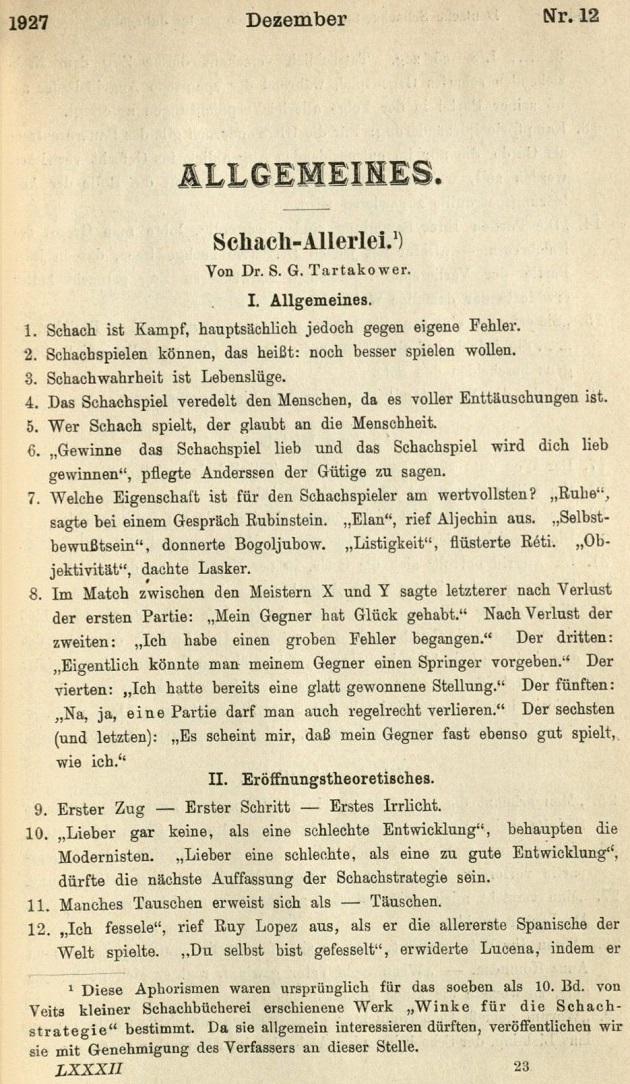
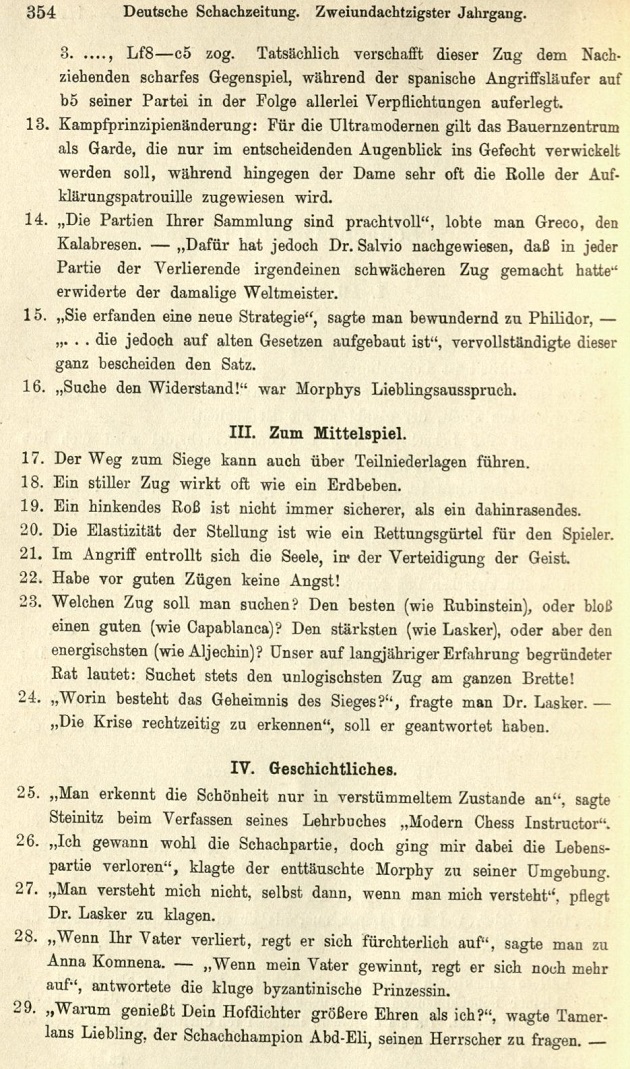
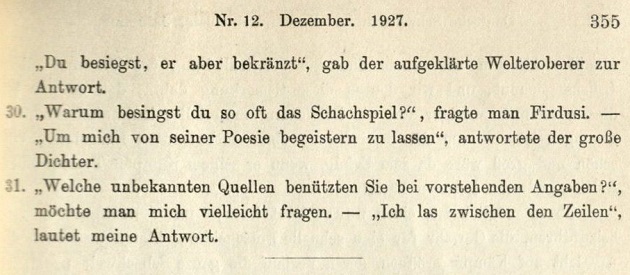
Acknowledgement to the Cleveland Public Library for the scans in this item.
(11830)
‘Castling is the first step towards a well-ordered life’ is a familiar remark by Tartakower, cited, for instance, in Wolfgang Heidenfeld’s entry on (sourceless) chess aphorisms on page 16 of The Encyclopedia of Chess by Harry Golombek (London, 1977).
The castling observation is one of dozens given by Tartakower on pages 551-553 of the Teplitz-Schönau, 1922 tournament book (shown below courtesy of the Cleveland Public Library):
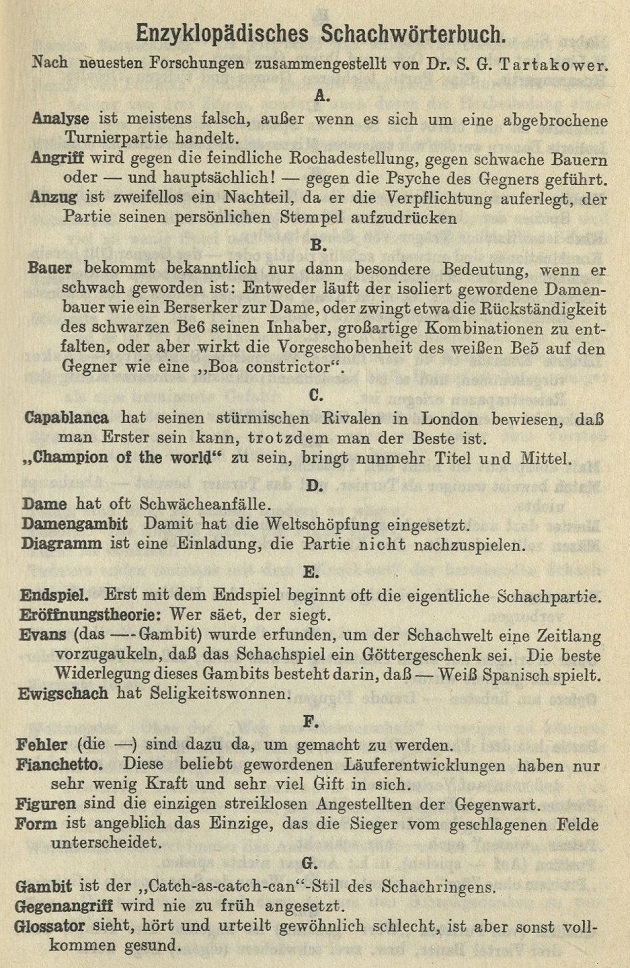
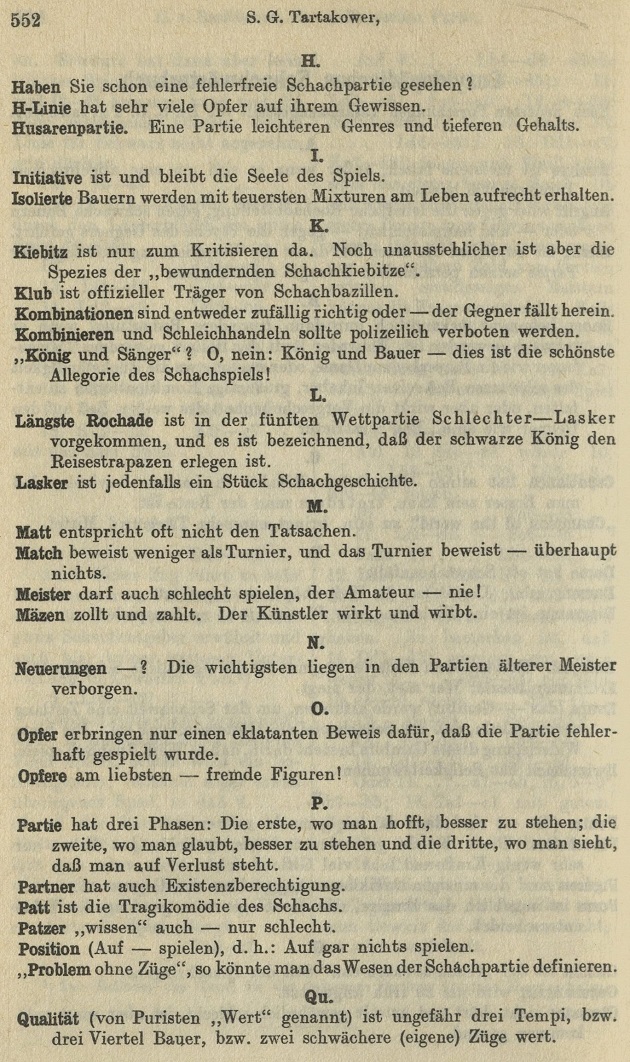
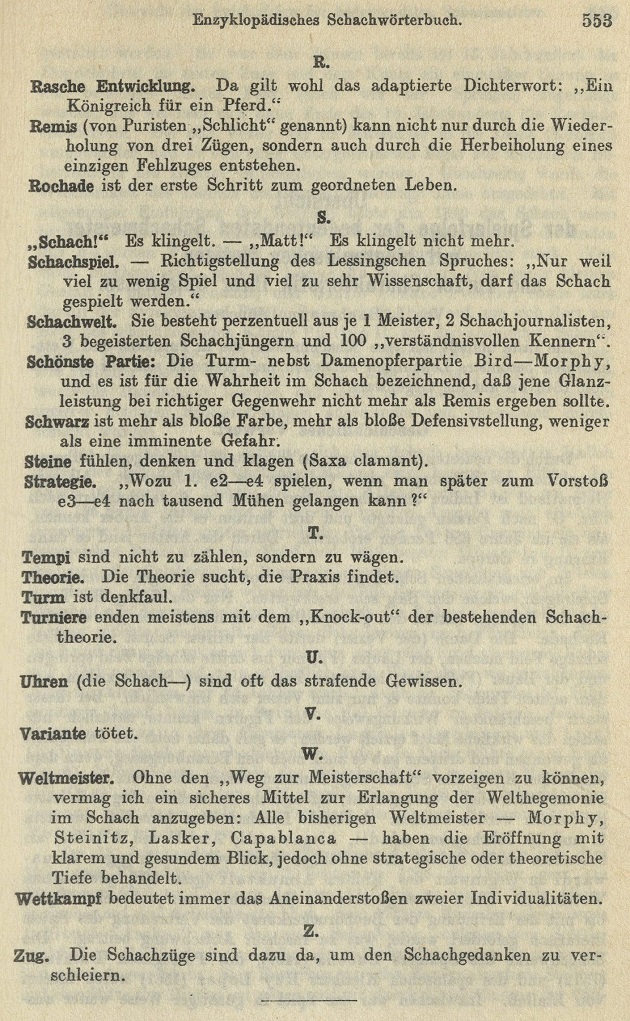
Thus page 553 has:
‘Rochade ist der erste Schritt zum geordneten Leben.’
A number of other observations above will be familiar. Concerning ‘Die Fehler sind dazu da, um gemacht zu werden’ (customarily translated as ‘The mistakes are all there, waiting to be made’), we have now slightly amended the Tartakower entry in The Most Famous Chess Quotations, given that the Teplitz-Schönau, 1922 tournament book predated our source (Die Hypermoderne Schachpartie).
See too our feature article Castling in Chess.
(11929)
‘Opfer erbringen nur einen eklatanten Beweis dafür, daß die Partie fehlerhaft gespielt wurde’ often appears in English as ‘Sacrifices only prove that someone has blundered’.
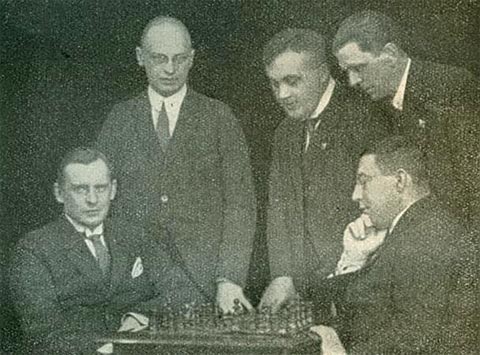 ßß
ßßThis picture was given by us in a Chess Mysteries article at ChessBase.com on 20 November 2007 with this brief information:
The photograph above shows Alekhine at the board with Rubinstein (watched by Tartakower, Bogoljubow and Maróczy). It is taken from Tartakower’s book Die Hypermoderne Schachpartie, published in the mid-1920s, and the credit reads ‘Friedmann, Wien’. Can a better copy of the picture be found?
Now, Philip Jurgens (Ottawa, Canada) asks whether anything further has come to light. Unfortunately not, to our knowledge.
(11948)
Concerning C.N.’s discussion of Janowsky and Tartakower spelling matters, see the sequence beginning with C.N. 1342 in Chess Jottings.
See also the references to Tartakower in The Paris Opening (1 Nh3). For further games played by Tartakower, see the Factfinder.
‘I had a toothache during the first game. In the second game I had a headache. In the third game it was an attack of rheumatism. In the fourth game, I wasn’t feeling well. And in the fifth game? Well, must one have to win every game?’
Anyone using a search-engine for that remark, or a slightly different wording, will be presented with countless webpages. Most ascribe the comment to Tarrasch, some to Tartakower, and none to a precise source.
In print, it is no surprise to find A. Soltis writing the following sourcelessly on page 11 of Chess Life, June 1990:
‘And it was Tartakower who had perhaps the final word on excuses. Asked how he could lose so many games in a row at one tournament he replied: “I had a toothache during the first game, so I lost. In the second game I had a headache, so I lost. In the third game an attack of rheumatism in the left shoulder, so I lost. In the fourth game I wasn’t feeling at all well, so I lost. And in the fifth game – well, must I win every game in a tournament?”’
An earlier version was related by Harry Golombek on page 91 of the April 1953 BCM in a report on that year’s tournament in Bucharest, at which he ‘had a really dreadful phase’:
‘If asked to account for these six successive losses I think I cannot do better than to quote Dr Tartakower who on a similar occasion was explaining why he lost five games in a row in an international tournament. “The first”, he said, “I lost because of a very bad headache; during the second I didn’t feel at all well; I was afflicted by rheumatic twinges throughout the third; in the fourth I suffered acute toothache; and the fifth – well, must one win every game in a tournament?”’
Readers may care to imagine themselves entrusted with editing a chess quotations anthology. What to do with this ‘final word on excuses’? Omit it owing to the lack of a source? Give in detail the various versions and attributions? Plump and hope for the best (the process described in C.N. 9887)?
An attempt may first be made to establish when, if ever, Tartakower or Tarrasch lost five consecutive tournament games, and when the story was first attributed to, if not voiced by, either of them.
(11994)
C.N. 12015 shows, courtesy of the Cleveland Public Library, a number of pages from Les Échecs au coin du feu by N. Rossolimo (Paris, 1947), including the Preface by Tartakower:




From page 2 of the Brooklyn Daily Eagle, 10 March 1930:

(12103)
Latest update: 9 August 2025.
To the Chess Notes main page.
To the Archives for other feature articles.
Copyright: Edward Winter. All rights reserved.